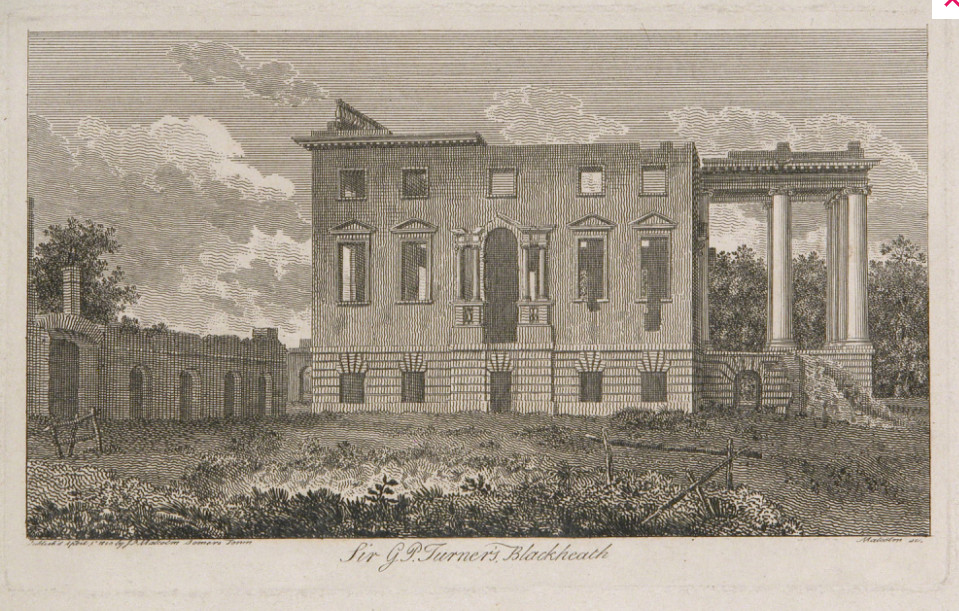
With edits to June 2025
The Years 1800 onwards Back to Intro
Overview:
The
beginning of the 19th Century which would see major changes in land
ownership and the beginnings of suburban development. John Cator
had exchanged land with Peter Burrell IV (Lord Gwydir) in 1793 and as a
result Burrell land was south of the village and Cator mainly
north. After
Mary and John Cator’s deaths, John left the Cator estates in
the
hands
of several family trustees headed by his nephew, John Barwell Cator,
making complex bequests. Whether John
intended the
Beckenham estates to be developed is in doubt. His will intends the
estates to be kept intact
although some development of the Wricklemarsh, Blackheath estate had
taken
place. His will dictated restrictions on selling or developing the
estate which
the Cators will get altered by Private Act of Parliament in 1825.
Between the
time of his death and a Private Act of Parliament in 1825 brought by
the
remaining trustees, some of the trustees had died intestate thus the
primary
heir, John Barwell Cator, son of John Cator’s brother Joseph,
gains
control of
the estates and resides at Beckenham Place for at least some of the
time. He
buys estates
in Norfolk and visits Ireland, his wife's family's home, regularly or
for substantial periods and
spends less
and less time in Beckenham. After about 1840 the Park is mostly leased
to a
series of tenants. But other events affect the park such as the
building of the
railways and inheritance of the park by John Barwell Cator’s
descendents. The
Trust by which the estates are managed will perhaps never be fully
understood,
but John Barwell Cator’s brother Peter is reported as
managing
the
Beckenham
estate upon his return from being a magistrate in India. The pace of
built
development of the estates was dictated in part by the demand for
housing and
at least once that process stalled when demand was low. J.Barwell Cator
along
with his father Joseph and siblings as trustees were involved in
further
purchases of land including the enclosure of Penge Common and
development of
the Croydon Canal and later the railways. Apart from being landlords of
the
properties involved it seems the main protagonists for development
where other
entrepreneurs.
The
other large estate under the Burrells, now Peter Burrell IV (Baron
Gwydir) will survive until his death in 1820 and then be divided
through sale. Langley
and Kelsey are divided between different buyers. Edward Grose-Smith,
John Woolley and the Hoare banking family take root. Other properties
such
as
Austin’s Elmers End etc. change hands and the
district begins to become
suburbanized although OS maps published
as late as
the 1890's show large swathes of open land.
Return
to the timeline:
1800
- Wricklemarsh, Blackheath; dated 1st April an engraving of
Wricklemarsh in a state of demolition showing columns, window masonery
and columns.
Described as Sir G.P.Turner's House, Blackheath and the picture
attributed to
James Peller
Malcolm (Philadelphia 1767-London 1815). But the property was acquired
by John Cator in 1783 apparently already in a state of disrepair.
Parts of the masonry is
believed to have been removed to Beckenham Place but probably
by
John Barwell Cator beween 1806 and 1812 who is said to have improved
the Beckenham Place property. The masonery of the
windows and columns is strikingly similar to those
at
Beckenham Place.

The
picture adds to the evidence that the addition of a portico to
Beckenham Place with materials from Wricklemarsh is after John Cator's
death in
1806.
source: http://www.nationaltrustcollections.org.uk/object/732838
1800
–
Burials in Beckenham St. Georges from 1701-1800 total about 2500
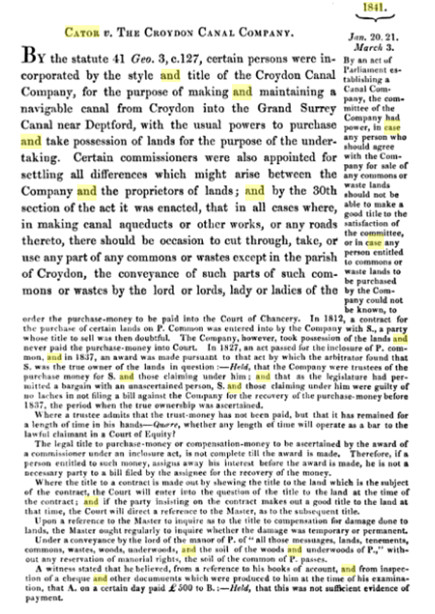
In
1841
John Barwell Cator brings a case against the company.
1801
– John Cator and his brother Joseph are active in local
affairs.
Press cuttings in an online archive reveal how John is influencing
church
wardens Thomas Pool and David Bassett who are required to set a rate to
provide
relief for the poor. The poor rate is not set and the accusation is
that
Cator and
other ‘local persons and Noble Lords’ perhaps
referring to Lord Gwydir are used to
influence this
process. A
Mr Jackson, a merchant, has the church wardens prosecuted for not
fulfilling
their duty. It would appear that Cator stays in the background but his
identity
is revealed by the lawyer Garrow in proceedings. The two churchwardens
are confined in Kings
Bench
prison for contempt.
Subsequent
to this legal case, Joseph Cator is prosecuted and found
guilty of libel against Jackson, apparently an attempt at revenge by
Joseph Cator
for his brother John. A significant piece of evidence in the case is
the fact
that letters containing the libel are on paper only supplied by a
Bromley statiuoner to Joseph
Cator
and the Bishop of Rochester who resides at the Bishops Palace in
Bromley.
Joseph’s defence lawyer is George Wickes.
Reference
is made to John Cator’s experiences with the law, perhaps
referring to his suits against Bolingbroke’s trustees over
the purchase
of
Beckenham Manor as well as his time as Sheriff of Kent
and as
an MP and to his differences with Hester Thrale over Henry
Thrale’s
Will.
1801
– The Croydon Canal; July; It was resolved by the
General Assembly of the
Croydon
Canal company that the Croydon Canal Act be carried into execution.
(Times Newspaper). The canal was short lived and much of the
route is later taken over by the subsequent
railway.
1802
– John Cator is implicated in another court case at Maidston
Assizes for an unwarranted eviction a tenant from one of his fields. A
Mr
Jackson sues Cator for damages. The case is prosecuted by the barrister
Garrow.
Cator is made to pay £100 damages.
1802
– Minor Road diversion to straighten part of what is now the
High
Street; Part of highway with footpath between village
of Beckenham and
village of Southend, from the churchyard of Beckenham, 264
yards
long, being
crooked and narrow, to be diverted to new line through lands of John
Cator,
Esq., from Beckenham churchyard, 242 yards long, 30
feet wide.
Part of footpath between village of Beckenham and
village
of
Sydenham, from
the highroad near Beckenham churchyard, 631 yards
long, to be
diverted to new line through lands of John Cator, 575 yards long.
Order: at Beckenham, 30 August 1802, with plans (scales: 80
inches
to mile
and 25 inches to mile) surveyed by G. Wildgoose.
Endorsed: consent of John Cator of Beckenham, Esq., 30 August
1802;
certificate of completion, 4 October 1802.
Held
At:Kent History and Library Centre
Document
Order #:Q/RH/2/68

Courtesy
of Kent Archive
1803
– Elmers End? Ambrose Austin is christened, son of Ambrose
and
Mary
Austin. Ambrose Austin appears as landlord of the Elmers End Farms on
the1838
tithe map. We have not been able to link Ambrose Austin to Francis
Austin or Francis Motley Austin who inherited
Elmers End
Farms from Thomas Motley. And an Ambrose Austin is described
as a
farm labourer on a census record.
1804
- Mary Cator dies and is buried in St. Georges churchyard with her
daughter. Although born and raised in a Quaker family, Peter
Collinson was her father, the Cators embraced the Church of England
about the time of John Cator the Elder's death in 1763.
1805
– John Cator prepares his Last Will and Testament, mentioning
properties in Kent, Surrey, Essex, Herefordshire and Middlesex. These
include his
Mansion at Beckenham
Place and an estate “situate near Addington”.
Copies are in the
National
Archive, Surrey Archive and Prerogative Court of Canterbury Wills.
Middlesex
may refer to his west end Adelphi apartment? It must be remembered that
County
boundaries have been modified. The original Southwark based business
was in
Surrey as were any properties in Croydon, Norwood and Addington. The
small amount of Herefordshire (Ross on Wye) property relates to John
Cator the elder's birthplace. The
will
copied into the records of the Prerogative Court of Canterbury Wills
extends to
21 pages of difficult to read handwritten text. The original
presumeably in
John Cators handwriting is in the National Archive at Kew. Several of
Cators
nephews are mentioned including George and Henry Sparkes, his nephews
by his
sister Mary. His inention was that the estates remained intact and this
leads to
the later 1825 Act sought by his heirs to allow the break up of the
estate. See
1825.
1806
- John Cator dies at his apartment in the Adelphi near The Strand
and is buried in St George’s churchyard, Beckenham with his
wife and
daughter
in the family vault. Having lived on Bankside in Southwark near his
business
and later acquiring an apartment in the Adam Brothers Adelphi near the
Strand
Cator was a man of property and we can only speculate on how he
accumulated his
wealth. Referring to Pat Mannings “Cators of Beckenham and
Woodbastwick” will
give details of John Cator’s legacy. His Will was complex and
the
assets
extensive. The later Act of Parliament of 1825 listing properties is
enlightening.
The
family tomb bears this inscription:
JOHN
CATOR, late of Beckenham Place, 21st
February
1806 aged 76 years/ MARY his wife 13th
August
1804 aged 71 years/ MARIA their
only child April 1766 aged 3 years/
MARY
his
mother 28 August 1787 aged 78 years/ ANN his sister 27th
July
1766 aged 17 years/ MARY daughter
of his brother SAMUEL August 1793 aged 8 years.”
(source:
P.Manning)
1806
– John Barwell Cator marries Miss Elizabeth Louisa Mahon,
daughter
of Sir Ross Mahon, 1st Baronet, of Castlegar, County Galway and a niece
to Lord
Vigo. They spend a good deal of time in Ireland and some of their
children are
born there. This contributes towards the Cator’s move away
from
Beckenham.
1806-1825
- John Barwell Cator (1781-1858), son of John's oldest brother
Joseph, ultimately inherits the estate with other trustees although
substantial
assets are directly left to him in the Will. John Cator is following
the
practice of the gentry in leaving his estate ‘in
tail’ i.e. in trust
for the
family. It is held
in trust by his
father Joseph until Joseph's death in 1818. But not before two cousins
of
Barwell Cator who are also named in the will die before majority and
hence the
whole estate becomes J.Barwell Cator's and his brothers via an act of
parliament, though this has yet to be fully unravelled and Pat
Manning’s
account of it is the best thus far so please read her book. According
to John
Cator’s will of 1805, No one person was left in charge of his
estates
and there
were strict instructions in the will to keep the estates intact, avoid
cutting
down timber, defacing or destroying the land. He also wished that the
property
should remain in the family and be passed from father to son. Subject
to
limitations and conditions, Beckenham Place, all Manors and herediments
in
Kent, Surrey, Essex, Middx, Hereford and elsewhere including an
Addington
estate were left in trust to George Sparkes and Henry Sparkes, sons of
John’s
deceased sister, Mary Sparkes. Sarah Cator, the widow of his late
brother
William was left an annuity of £60 pa for life. £20
p.a. annuities went
to
Bridget Cator, widow of Kingston, Jamaica and Elizabeth Scott of
Rodborough,
Glos. Susannah Scott, Elizabeth’s daughter received dividends
from bank
annuities, similarly niece Harriet Heapy and great-niece Mary Ann
Sparkes. Ann
Frances Baynes, wife of Lt Col Baynes and daughter of John’s
late
brother
William received £2000. By 1825, the Cators found the estates
impossible to
administer because the Sparkes brothers had died intestate and their
heirs were
all minors.
They
submitted a private Act dated
27.6.1825 to King George IV to enable the descent to go down through
Joseph’s
eldest son, John Barwell Cator. (source: P.Manning “Cators of
Beckenham
and
Woodbastwick”)
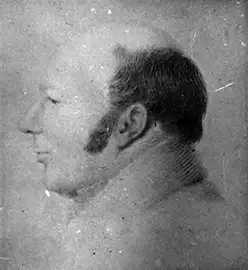
John
Barwell Cator 1781-1858
1806
- Building leases begin to be sold
for parts of the Cator Wricklemarsh, Blackheath estate. There is some
debate
about the alterations to Beckenham Place Mansion. Possibly John Barwell
Cator
having acquired great wealth through his inheritance indulged in adding
the
portico to the mansion and remodelling the lake as part of his spending
spree.
Without written records the maps available are a source of information.
In 1799
the mansion appears on a map without a portico and it’s
unlikely that
John
Cator the younger would engage in such alterations at this late stage
in his
life. The lake is of a different shape in the 1799 and later maps. The
print of
1812 shows the portico and the maps of about 1860 show a different lake
outline.
This
description is from the 2009
Conservation Management Plan produced by Rees Bolter Architects:
Although
the fabric of the north wing
is of considerable archaeological significance, the architectural
relationship
between the extension and rest is clumsy and it is hard, almost
impossible, to
believe that the patron of the first house could have sanctioned such
work. The
survival of the shell of Wricklemarsh into the nineteenth century and
the
internal character of the extension make it far more likely that the
extension
was the work of John Barwell Cator, undertaken in the whirlwind of
expenditure
following his inheritance, to impress his new wife and family. Major
expenditure on country houses usually follows a change of ownership.
The wing
has, within this report, generally been referred to as work of c1810
although
no secure dating has been established. The new wing required the main
hall to
be approached along a rather long central corridor, with long rooms
flanking it
on each side. The overall impression of the new wing is that it was
conceived
as a showcase for masonry salvaged from Wricklemarsh, compromised by
the levels
existing within the original house. The pediment supported by the
columns is
visually too light and the rooms on each side of the central corridor
are
ill-proportioned. The additional accommodation was, presumably, welcome.
1806
– Kent House Farm; This will of a leaseholder, Thomas
Randall,
of Kent House Farm leaves unexpired terms of leases to heirs. Kent
House had
been acquired by the Barings in 1797, by 1828 Kent House ownership
passes from
Julius Angerstein, who had married Barings widow, to
John Barwell Cator and in 1838 and the
Tithe map the Randalls have disappeared unless sub leasing, as by that
time
Michael Mathew Snr. is leaseholder. Thomas Randall is buried at
St.George’s and
his son James in 1815 and these are the last two Randalls recorded
buried at
St.George’s. The wife Mary is not recorded so presumably
buried in
another
parish or possibly remarried.
I Thomas
Randall of Kent House in the Parish
of Beckenham in the County of Kent Farmer do make this my last
Will and
Testament as follows (that is to say)
I
give and bequeath unto my Son James
Randall my leasehold Estate called Kent House Farm whereon I
now
reside
for all the Rest and Residue of my Lease to come The stock and Utensils
Goods
Chattels Effects whatsoever (save and except hereinafter mentioned) to
hold the
same and every part thereof save and except as aforesaid
I
give and bequeath unto my Wife Mary
Randall all that Cottage Tenement part of my Leasehold Estate
Scituate in
the Hamlet of Tonge and also five acres of Meadow Land now in the
Occupation
of James Marshall To hold to her all which I do
direct she
shall
enjoy to her sole use during the Term to come
It
is my Will that my Son James Randall do grant to
Mrs. Randall a Lease for the unexpired Time to come at a Pepper Corn *
per Year
* Peppercorn Rent: A token or nominal rent. The name comes from leases
where
the rent is one peppercorn a year. A peppercorn rent is often found
where a
premium has been paid for a lease.
I do desire my Son James Randall to suffer and permit my said Wife Mary
Randall
to occupy the Blue Room called in my house all the Residue of the Term
I
give and bequeath to my Wife Mary Randall the
Interest that shall become due from Time to Time of the Sum of five
hundred
pounds in the Long Annuities during her Life
And after her decease I give unto Thomas Randall the Younger
my
Grandson
of Wallere? Street the Sum of Three hundred Pounds of the said
stock
I
give and bequeath unto my Grandsons John
Field and William Field (of?) Brooks Market the Sum of Two
hundred
pounds
Stock in the five per Cent Long Annuities the remainder of the said
Stock to
them or the Survivor
I
give and bequeath unto my said Wife all such household
Goods Plate and Linen and China as were her property and brought with
her from
her house (in?) Beckenham on our Marriage
I also give to my said Wife all my wearing apparell for her to
distribute the
same amongst my Brothers at her Discretion
If
any part of the above Stock should be Sold out
and made use of in the Farm in my Lifetime the said Sum so made use of
out of
the said Stock in twelve Months after my Decease the said stock shall
be bought
in and made good out of my Effects
And all my just Debts and Demands out of the said Farm to be paid by my
said
Wife Mary Randall and my said Son James Randall to be my joint Exors.
[Executors] and Trustees
I
do hereby desire that my said Wife do hold the
Lease of the said Premises called Kent House Farm for the Deficiencies
if any
of the said Stock and shall at the years End after my Decease enter the
said
Premises and to sell any part of the Effects to make good the said
Stock five
per Cent Long Annuities
And
my exors. Mary Randall and James Randall shall
sell out and replace the said Stock Long Annuities into any other Stock
at any
Time they shall find it to be necessary and same to be divided in two
ad the
three Fifths as within mentioned
I
do hereby appoint Mary Randall my Wife and James
Randall my Son to be my Joint Executors to this my last Will and
Testament
revoking all other Wills dated the Twentieth Day of March One thousand
Eight
hundred and five Written and signed by me
Thomas Randall
Appeared
Personally Matthew Concanon the
Younger of Sandys Street in the Parish of St. Botolph Bishopsgate
London
Gentleman and John Garrard of Sydenham in the County of Kent
Gentleman and
made Oath that they knew and were well acquainted with Thomas Randall
late of
Kent House in the Parish of Beckenham in the County of Kent deceased
for some
Time before and to the Time of his Death Acquaintance with the said
deceased
they have often seen him write and Subscribe his name and are thereby
become
well acquainted with his manner and character of handwriting and
subscription and
having now carefully viewed and perused the Paper Writing thereunto
annexed and
purporting to be the last Will and Testament of the said deceased the
Will
beginning thus, I Thomas Randall of Kent House in the Parish of
Beckenham in
the County of Kent Farmer ending thus dated the Twentieth Day of March
One
thousand Eight hundred and five Written and signed by me Thomas Randall.
these Deponents say they verily and in consideration believe the whole
Body
series and Contents of the said Will together with the Subscription
hereunto to
be all of the proper handwriting and subscription of the said deceased
M. Concanon John Garrard
On the 5th Day of June in the year of our Lord 1806 the said Matthew
Concanon
the younger and John Garrard were duly sworn to the Truth of this
affidavit
before me C. Coote Surrogate J.B. Morgan Not. Pub.
This
Will was proved at London on the ninth Day of
June in the year of our Lord one Thousand eight Hundred and Six before
the
Worshipful Charles Coote Doctor of Laws Surrogate of the Right
Honorable Sir
William Wynne Knight Doctor of Laws Master Keeper of the Prerogative
Court of
Canterbury lawfully constituted by the Oaths of Mary Randall Widow the
Relict
and James Randall the Son of the deceased and the Executors named in
the said Will
to whom Admon. of all and singular the Goods Chattels and Credits of
the said
deceased having been Sworn duly to administer.
1806
– Langley and Kelsey; Peter Burrell IV/Baron
Gwydir resides in Sidmouth and Langley is occupied by his sons Peter
and Lindsey.
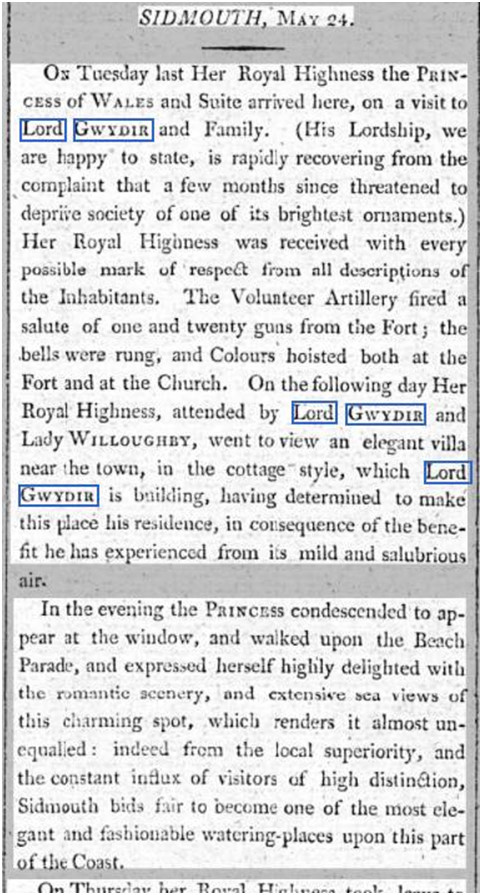
Sun
(London) 28th May 1806
1807
- J.Barwell Cator buys land at
Woodbastwick, Norfolk. This is the beginning of the gradual move away
from the
Beckenham estate (source: P.Manning, see her account on
www.bblhs.org.uk/download/i/mark_dl/u/4010072272/.../Cator%20Pre2.pdf)
1807 – Monks Orchard/Park Farm; is bought by Peter Burrell/Lord Gwydir. This property had been part of the Leigh’s Addington estates which was bought by Barlow Trecothick and the Addington estates were divided in sale by Barlow Trecothick’s nephew James. The patch of woodland is Monks Orchard Wood and this plan shows the leased property to John turner tenant in 1809.
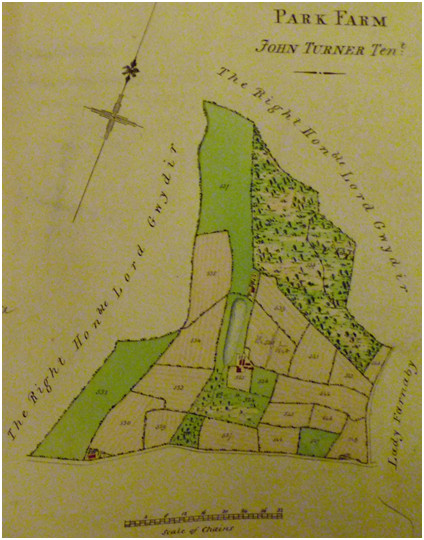
1808
- John Barwell Cator’s wife’s
relative Mr Aylmer Bourke Lambert has access to Barwell Cator's papers
inherited from Peter Collinson via John Cator at the mansion. Lambert's
letter
to James Edward Smith of the Linnaean Society in their archive is the
route
which leads to Collinson’s revelation about the date of the
building of
the
Beckenham Place/Stumps Hill mansion. Lambert made copies of the
catalogue which
became the property of Lewis Weston Dillwyn who printed the version
which we
can now access on the internet and reveals the first date of the
mansion at
Beckenham Place.
Lambert comments about J.Barwell Cator "who has just come into all his
uncles immense property" and "Cator has lately married a relative of
mine Miss Mahon, a niece to Lord Vigo"
Stayed
last week at Beckenham Park with
[John Barwell] Cator who has recently inherited the estates of his
uncle [John
Cator (1728-1806)], who was married to [Peter] Collinson's
[(1694-1768)]
daughter, [Mary]. Collinson's books and manuscripts there, including
last
edition of [Philip] Miller's "Dictionary" full of Collinson's
observations, intends to publish them. Received "fine China drawings"
from Lady de Clifford. Plans to send Smith his just finished
"suppl[ement]". (Linnaen Society)
1809
– A Burrell Estate map and book of
plans is printed (source: British Library) showing their estates to the
south
of Beckenham extending to West Wickham in the south, Bromley in the
east and
Elmers End in the west. There are various small outlying properties
owned by
the Burrells. The estate book shows tenants, properties, names of
fields and
pencilled in notes of crops grown.
This estate map along with
the 1833 Cator
estate map and 1838 Tithe map are the best sources of early 19th
Century property distribution.
Part
of the Burrell
Estate plan 1809 (High Street, Bromley Road and Kelsey)
Courtesy
of the
British Library
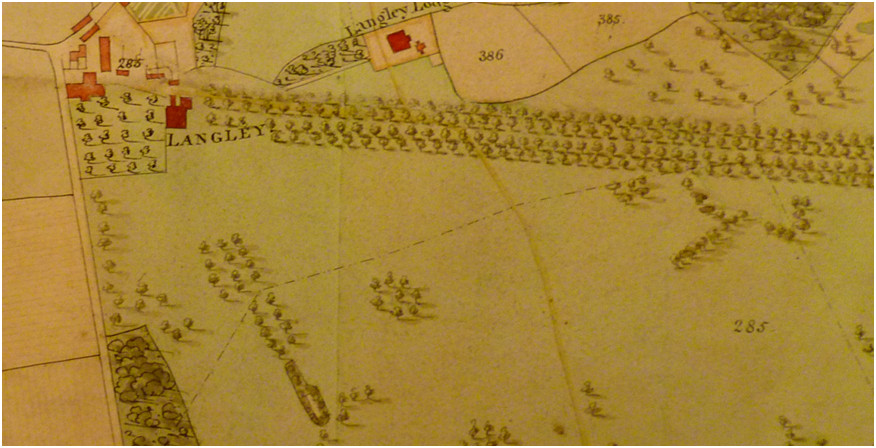
Langley
House or Place with Langley
Lodge 1809
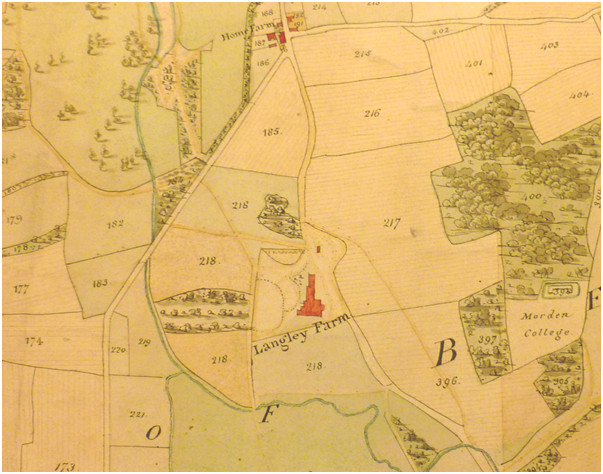
Langley
Farm and Home Farm (near
Chinese Garage) 1809
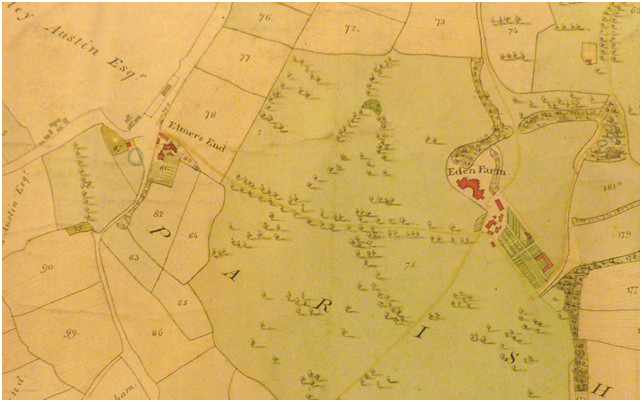
Eden
Farm (Bune Gate) and Elmers
End (Elmer Lodge) 1809
Kelsey
Lake, residences and mansions.
1809
1809
– Langley; Lindsey Meryck Peter
Burrell, second son of Peter Burrell/Lord Gwydir occupies Langley up
until the
time it is sold circa 1822. Lindsey and his wife Frances have 10
children
baptized at St.Georges and one child when they move to Hampshire in
1823.
Lindsey himself had been born in Paris while Peter Burrell IV was there
on a
legation with Lord Eden and others. This alters the known story of
Langley and
is more evidence that his father Lord Gwydir spent more time away from
Beckenham, some of it at Sidmouth, Devon due to his gout and his eldest
son,
Peter deputized as Lord Chamberlain (Hist.of Parliament and Ancestry)
1809 - J.Barwell Cator sells The Manor of Bensham or White Horse in Norwood and Croydon according to Lyson’s but the 1825 Act still lists extensive property in Addington, Croydon and Norwood? Very little has been discovered about the Cator property beyond Beckenham. Historians in some of those outlying areas are also unaware of details, for example at Leigh in Kent they were unaware of Cators owning farms there. See 1825.
1809 - The Croydon Canal opens. This shows a section from Sydenham to Norwood crossing Penge Common. Much of the route would subsequently be used by the railway leaving some small isolated stretches at Dacres Wood and Betts Park.
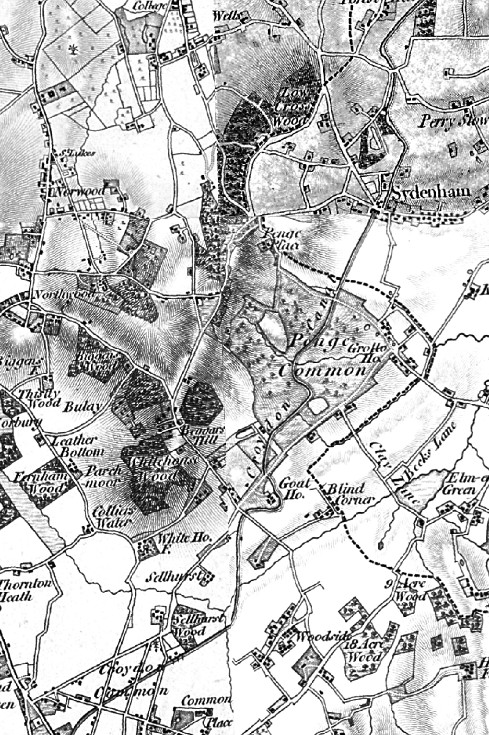
1810
– John Barwell Cator’s daughter
Elizabeth Diana Cator is born in Beckenham 27th
July
1812
- Mr. Lambert, a relative of John
Barwell Cator’s wife, visits Beckenham Place where he sees
Peter
Collinson’s
catalogue of plants and also comments on the grounds of Beckenham
Place.
This
view can be compared to
Collinson’s own view of Beckenham Place or Stumps Hill as it
was in
1762:
The
trees which survive of evident age
are native English Pedunculate Oaks, introduced Turkey and Red Oak,
Sweet
Chestnut (introduced by the Romans). Over time several oaks which may
have been
landscape boundary marks and field boundaries have died. Lack of tree
management may have led to loss of trees and some ancient trees have
been
removed either by human interference or storm damage as with the storm
of 1989.
1812
- J. Preston Neale produces a
print of the Beckenham Place Mansion in a book of country houses,
although the
pediment on top of the columns is not drawn accurately. It does depict
how it
perhaps should have been built. Preston Neale's work was published from
1812 to
1825 so different dates may be attributed to this print but it appears
in the
earliest edition. The book of prints has a description which may be of
questionable accuracy because the Place was not in existence before
1760 but
Neale describes the history of Beckenham Manor and Langley in a
hotch-potch of
facts from Hasted, Lysons and Ireland. Perhaps John Barwell Cator was
trying to
embellish the history.
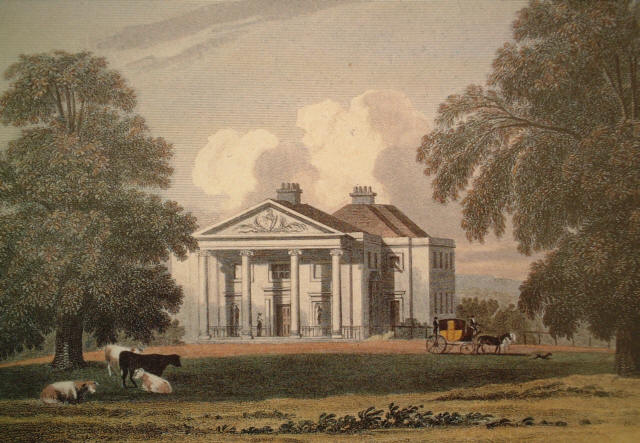
1812 - This print of Eden Farm is published and supports our evidence of the former house at Eden Farm which was originally Bune Gate on the 1769 Andrews map and also matches the footprint on the 1809 Burrell estate map. See 1822 for an image of the later house built for John Woolley.
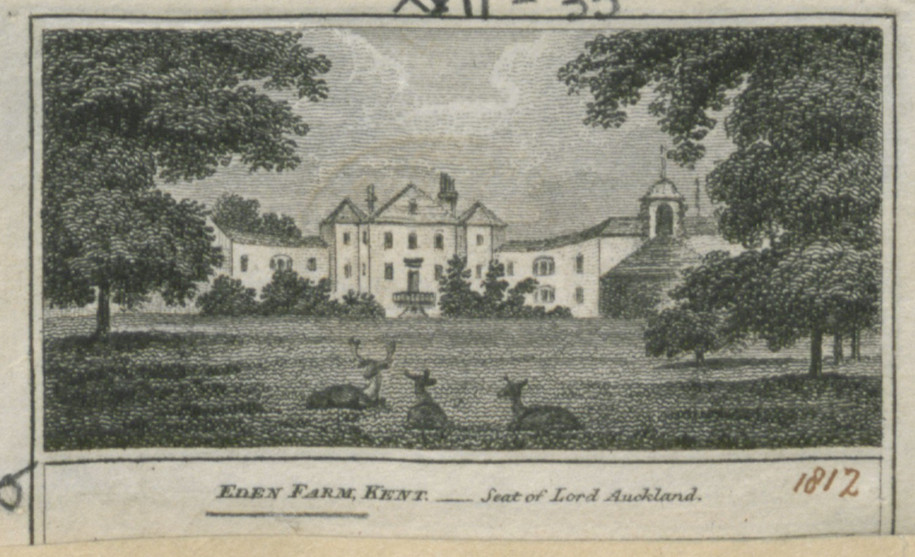
source; British Library
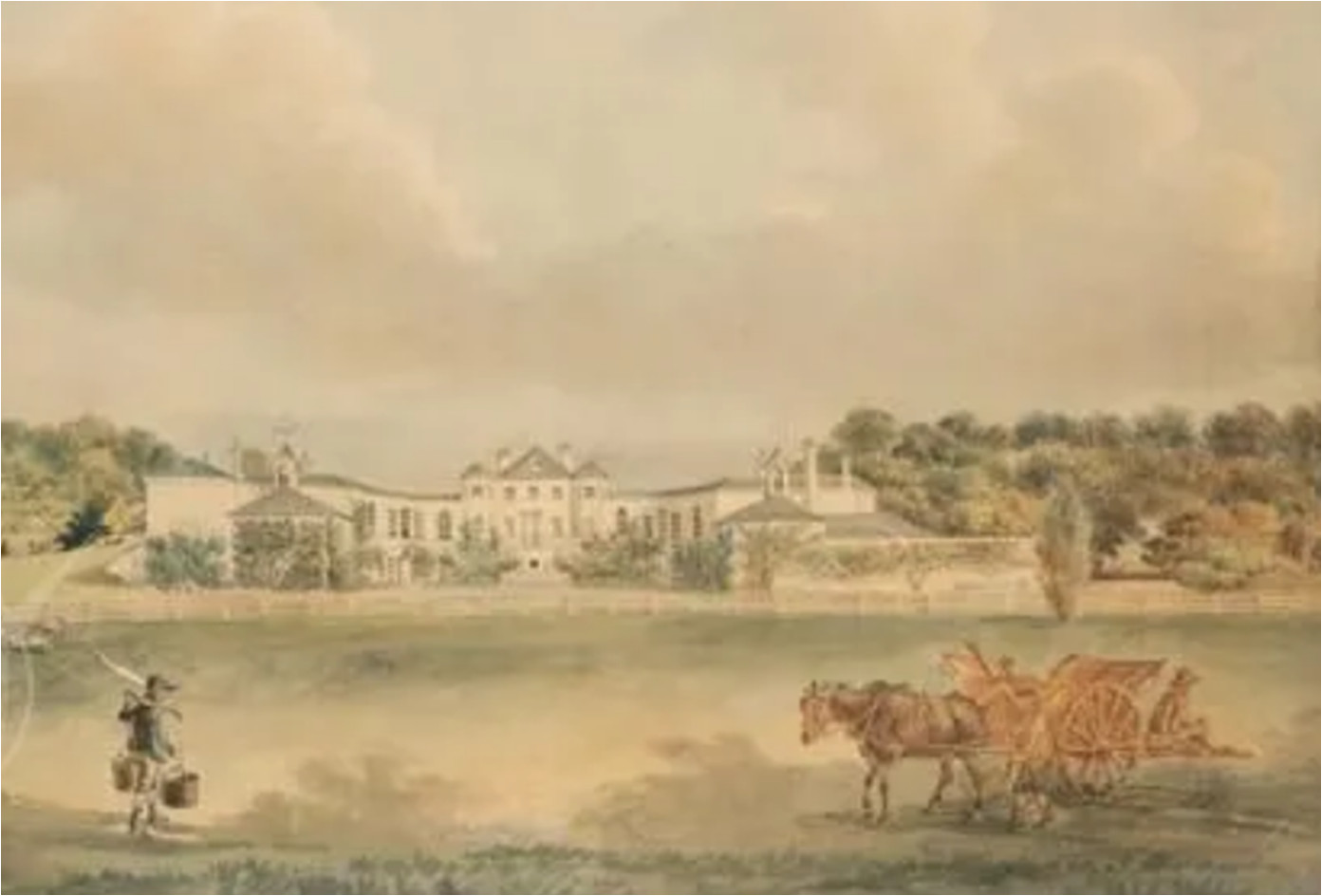
And this earlier illustration
Eden Park, Seat of Lord Auckland (William Eden) circa 1789
Painted by Peter la Cave, French School artist working from 1789 onwards
1812 - Penge Place; 7th April John Scott reputed 'Lord of the Manor' of Penge Common according to a notice posted by the Croydon Canal Company
1813 - Penge Place and Common; John Barwell Cator purchases Penge Place and Common by Articles of Agreement for £35,000. it will later be resold to another unrelated 'John Scott' who in turn sells it to the Crystal Palace Company.
1813
– Albemarle Cator (the first or
elder) is born at Beckenham, J.B.Cator’s eldest son who will
inherit
the
estates.
1813 – Morden College property in Beckenham; Langley Farm; The archivist of Morden College sent this statement; "Sir John Morden, as endowment for his College, bought the Manor of Old Court in 1699, and this included land at Beckenham, specifically Pightle Green, King’s Field, Shortlands Green, Langley Farm and Morden Field, and this land was exchanged for land in Lewisham with Lord Gwydir in 1813. Among the papers I took over from my predecessor is a photocopied plan, possibly from a large scale OS map, and I see that the land in question is bounded on the north by the Turnpike road from Wickham; on the northeast by Kelsey Park, and on the west by Langley Park and Langley Lodge lands. (source; Morden College archivist)"
However,
we believe that only the small patch between the Cocapanniers Woods was
Morden land.
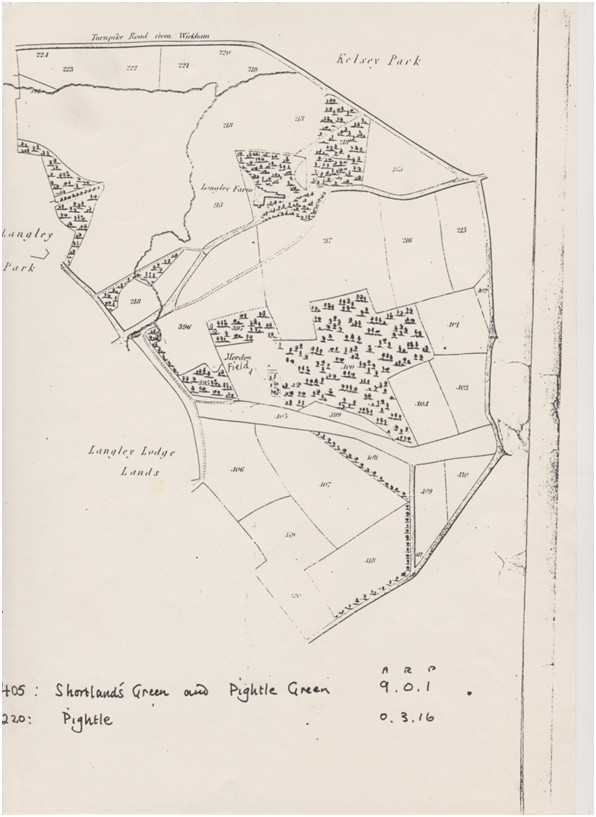
Morden
College archive map extract.
1815
- Miss E. (Emily) Eden writes from
Eden Farm; Miss
Eden to Lady
Buckinghamshire (Eleanor Eden married to Robert Lord Hobart)
EDEN FARM,
March 9 [1815].
MY DEAREST SISTER, As the Queen has been so uncivil and even spiteful
to me and
my sattin gown, as to put off the drawing-room, our three letters per
day upon
dress may now cease, and this is merely a letter of thanks for all the
trouble
you have taken with Wynne, Pontet, lace, notes, hoops, drapery, sattin,
carriers, feathers, jewels, etc., and which have unluckily, by this
strange and
unaccountable spitefulness of H.M., all proved useless. Poor Beckenham
is gone mad about the corn laws, and
have
revenged themselves on poor innocent harmless out-of-the-way George
(Eden, their brother), by
drawing
him on the walls hanging as comfortably as possible, and Mr. Cator on
another
gibbet opposite to him. Mr. Colvile is also hanging somewhere else....
Every
house and wall is covered with mottoes, and “No corn
laws” in every
direction.
Ever your affectionate,
E. EDEN.
The Cator mentioned was John Barwell Cator. Emily would have
resided in this Eden Farm mansion
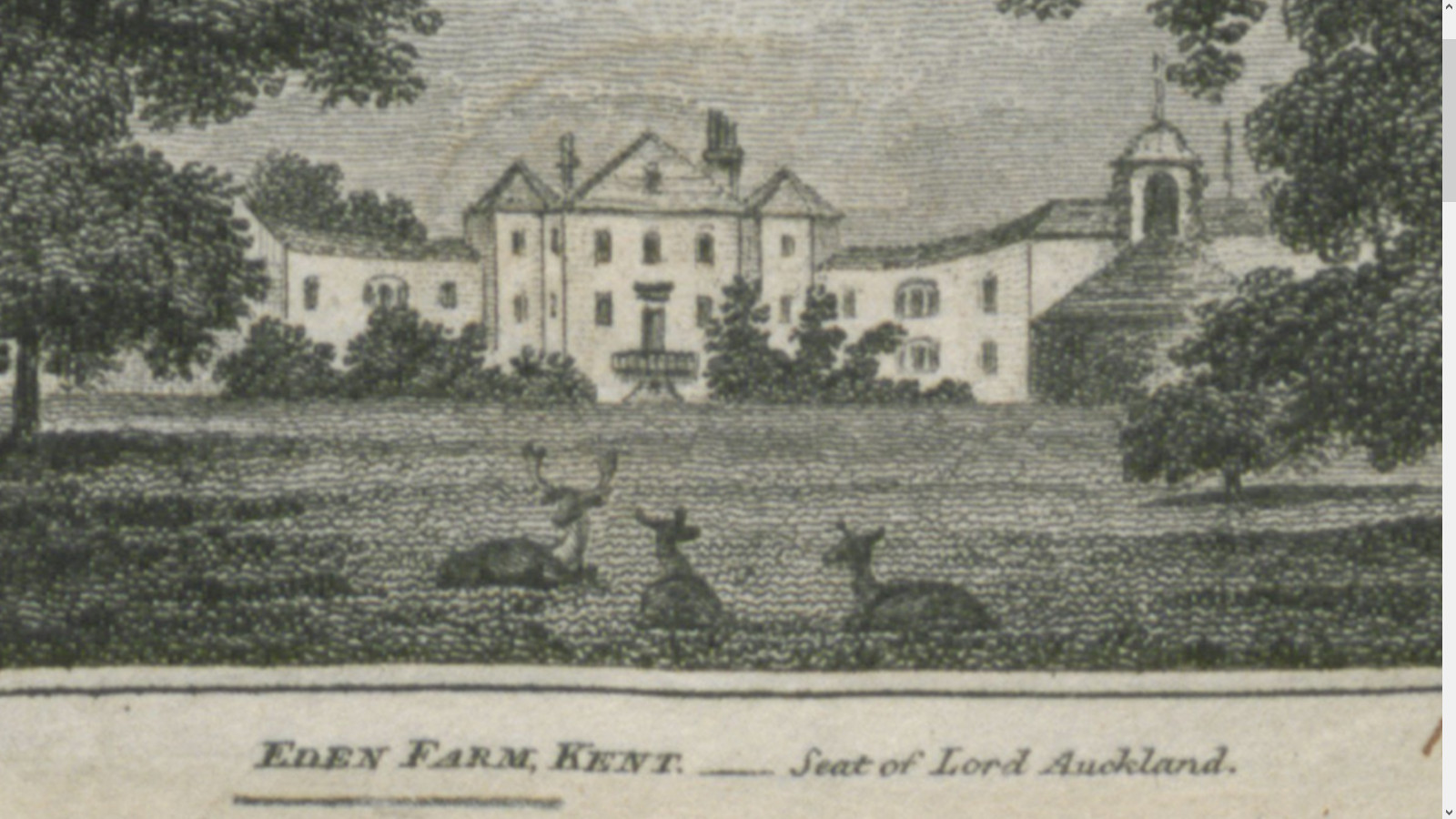
Eden Farm 1812 as occupied by Emily Eden and perhaps other siblings shortly after her father's death in 1814.
1815 - Penge (House unknown, Penge Place?); Occupants; Lord and Lady Selkirk. Lady Selkirk was sister to Andrew Colvile who occupied Langley Farm at this time. Another letter from Emily Eden mentions a house in penge and the death at Waterloo of William De Lancey plus details of his widow Magdelene De Lancey who wrote a book about the Battle of Waterloo which became a classic.
Miss Eden to Lady Buckinghamshire.
July 3, 1815.
We heard yesterday from the Selkirks[50] a certain account of poor Sir W. Delancey’s death,[51] and we heard it also from several other good authorities. The Selkirks have been in town every day in hopes of hearing either of or from Lady Delancey, but without success. Her situation is most dreadful, as he died at Waterloo, so she is not near any acquaintance she might have made at Brussels. She is but eighteen, and literally just out of the nursery. She has with her only a new maid, whom Lady Selkirk procured for her but three weeks ago. It appears very shocking that none of her relations should have gone to her on hearing of his wound, as she will now have every detail to manage for herself, and her return to Penge, which she quitted in such violent spirits not a month ago, will be dreadful. The Selkirks expect her every hour.
I have just been interrupted by the arrival of the Lansdowne children, who are come here for the afternoon to make Lady Lansdowne’s excuse for not coming to take leave before she goes out of town. The little girl[52] is the prettiest little thing I ever saw—the smallest child—looking like a fairy for all the world.
July 6, 1815.
We were all very sorry to hear of poor Comte Meerveldt’s[53] death, for her distress must be very great. Little Rodolphe will now be a great consolation to her. Lady Selkirk has had one very short note from poor Lady Delancey.[54] It was almost too composed to be comfortable to her friends. She said her husband had died at Waterloo, and was buried the morning she wrote, at Brussels, and she wished Lady Selkirk would have his picture done immediately by Heaphy,[55] as that was the only thing she could now live for. She made no complaint, except saying that she had had but one very happy week at Brussels, which was over, and that she was sure Lady Selkirk, at least, would feel for such a very wretched creature. She is expected at Penge to-morrow. There is an odd mixture of joy and sorrow in that house, as Lady K. Douglas[56] is married there to-day, which is rather astonishing, considering the state her family is in....
1816
– This map is said to be published
in 1816, probably surveyed earlier in the 1799 OS drawing on the right.
At 1 mile to
the
inch the lake is more of a curved canal shape than the kidney shape on
later
maps. See the 1833 estate map and the 1799 OS Survey drawing. As other
smaller
details are drawn in I assume the representation of the lake is
reasonably
accurate. Apparently map publishers were
using
OS data before the Ordnance Survey began to publish
their
own maps circa 1860.
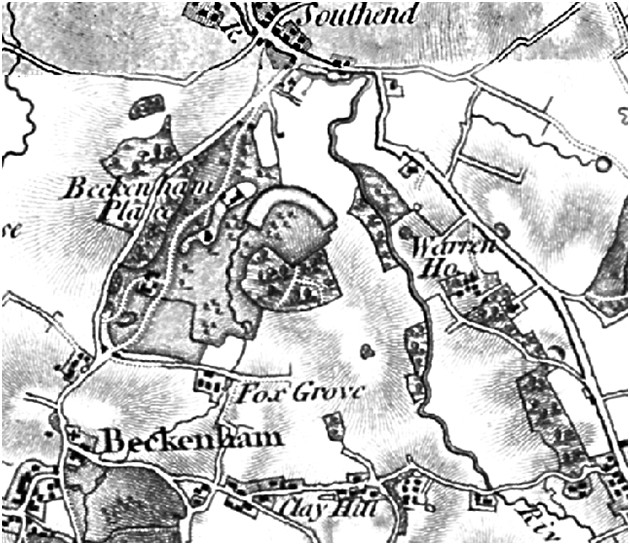
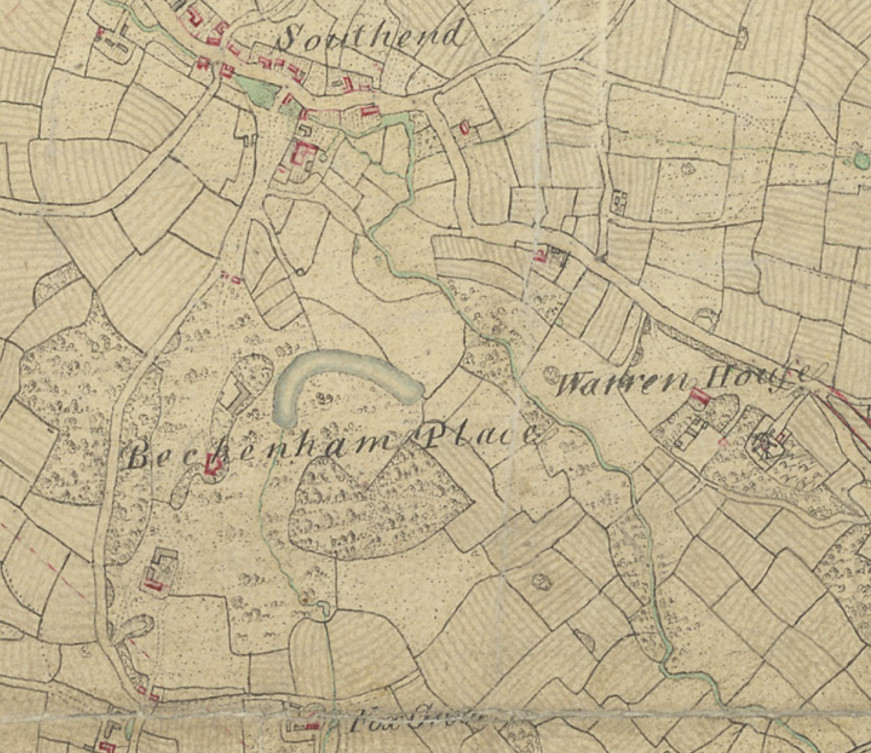
1817
–
Beckenham Place;
London Courier and Evening Gazette 09 June 1817. At
Mary-le-bone
church on
the 7th June 1817 by the Rev. Thomas Wellings of Church Linch, in the
county
and diocese of Worcester, John Wellings, Esq. of Welbeck Street, to
Mary,
second daughter of John Wedderburn, Esq. of Devonshire Street, Portland
Place.
After the ceremony the bride and bridegroom departed for Beckenham
Place, the
country residence of the bride's father. Indicating an early lease of
Beckenham
Place to a tenant. If accurate this is the first record of leasing of
the
house. We should mention that some confusions have taken
place between Beckenham Place and Beckenham Lodge?
1818
- Kent House Farm; Baring
has leased Kent House
Farm to Compton and some dispute has arisen over the lease. Details
unknown.
[C1818
C16].
Short
title:
Compton v
Baring.
Document
type:
Bill and
answer.
Plaintiffs:
Peter Alfred
Compton late of Hendon, Middlesex but now of Kent House Farm,
Beckenham, Kent,
esq.
Defendants:
Sir Thomas
Baring bart of Stratton Park, Hampshire and of Devonshire Place,
Portland
Place, Middlesex.
Subject:
lease
of Kent
House Farm.
SMP
(TNA)
1818
– Joseph Cator dies at Clockhouse.
On 25th March, the College of Arms authorised to John (Barwell) Cator
of
Beckenham and Woodbastwick the Cator Arms, an earlier form of which can
still
be seen over the pediment at the front of Beckenham Place.(source:
P.Manning).
Joseph’s wife Diana dies in 1829 in Beckenham and whether she
remained
at
Clockhouse is unknown. They are both buried in the family vault at
St.George’s.
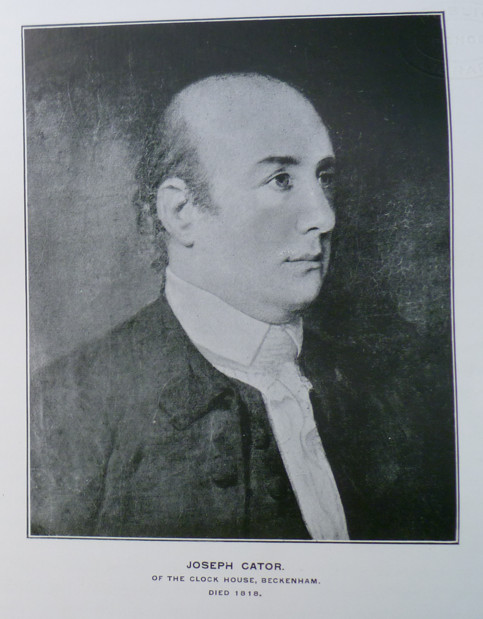
Joseph's will might be interpreted to be curious. He mentions his six (surviving) sons but by name only mentions John who is provided for by his Uncle's will, and two other sons who inherit his herediments along with his widow Diana. He refers to making provisions among his "aforementioned" sons are all provided for by earlier settlements. This branch of the Cators has risen to put the children through universities, The Army, Navy and Church which reflects Joseph's marriage into aristrocracy through Diana Bertie, related to the Willoughby D'Eresby's. Joseph's wealth had been substantially accumulated during his time with the East India Company in India.
1818 - Eden Farm; Emily Eden and Lord George Eden; correspondence; from a collection of letters on guttenberg.org.
These appear to explain the leaving date of the Edens from Eden Farm and put us on the trail of Mrs Wildman. It was common for properties to be leased and rented and this was for the remaining part of Eden's lease from Peter Burrell, Lord Gwydir. George Eden had an unexpired lease and although the Burrells sold the Freehold to Eden Farm in 1820 it was with a "sitting tenant", Mrs Wildman who later defaulted on her sub-lease. See 1820 and 1825. The subject isn't entirely unravelled between George Eden's disposal of the lease, the Burrell sale and the subsequent ownership under John Woolley.
Lord (George) Auckland to Miss
Eden.
BRUTON STREET,
Monday, November 1818.
MY DEAR EMILY, I have this moment
seen an agent of Mrs. Wildman, a rich Kentish widow, and she
has agreed to take Eden Farm on my own terms, which gives us a prospect of
being a little more settled and comfortable.
She is to have it for
seven years and pay £600 a year. And now I must look out for a house in town,
which you will find pretty near ready for you when you arrive. I am in a great
bustle and hurry, for we are all alive with this election, though with the
melancholy impression of poor Romilly’s death it is difficult to rouse people.
Hobhouse has behaved so ill
that it is right to try to beat him, but I fear that Lamb is too late. He will
certainly be low on the poll for the first week, but it is possible that
afterwards he may recover. In the meantime, people are very busy, and none of
our friends are sanguine. Your affectionate brother,
AD.
Lord Auckland to Miss
Eden.
[November] 1818.
MY DEAR EMILY, Lamb carried his
election to-day by 604, and made a sort of a speech saying that now he was
their member, and they were his constituents, and that they would soon learn to
be friends. He was a little hooted, but not much more than usual; but all our foolish
friends appeared to cheer him with cockades in their hats, and all was uproar
and riot and confusion and pelting and brickbats and mud, and it is lucky none
of them were very seriously hurt. They all arrived covered with dirt to the
west end of the town, and the mob at their heels, for they were too gallant not
to stop to be occasionally pelted.
I never saw such a scene. Your friend Graham looked as if he had
just come out from the pillory; Sefton, Morton, and twenty others in the same
plight.
Report says that one
servant is nearly killed; I hope it is not true. Ferguson had a blow on his
head, and Mr. Charlton another more serious one; but I hear of nothing worse.
It makes but an ugly triumph for our great victory. What a glorious
debate was yesterday’s!
You will live at No.
30 Lower Grosvenor Street, the only house I can get, small but convenient, and
I think we shall make it do well enough. Ever affectionately yours,
AD.
Miss Eden to Lady
Buckinghamshire.
NEWBY HALL [1818].
MY DEAREST SISTER, ...Mr. Ellis left
this place yesterday, so I could not give him your message. I think he enjoyed
the latter part of his visit here very much, as there was a very pleasant set
of gentlemen, and Mr. Douglas, who is more amusing than ever. We had besides
them, two Mr. Lascelles’s, one “a cunning hunter”
and the other very gentlemanlike and pleasant; Mr. Duncombe, a pretty little
London Dandy, rather clever in his way; Captain Cust, a soldierly sort of
person, and a kind of Lusus Naturae (is that sense do you
think?), because he is pleasant and well-looking though he is a Cust, and Mr.
Petre, very rich and very stupid, so that we had a very proper mixture of
character....
We are all hunting
mad in these parts, and I am afraid that when I come to Eastcombe I shall be a
great expense to you with my hunters and grooms. I have already made great
progress in the language of the art.
I have heard a new
name for the Miss Custs, in case you are tired of the Dusty Camels; by uniting
their names of Brownlow and Cust, they become Brown Locusts, which is a very
expressive title I think. I remain, ever yr. very affec. sister,
E. EDEN.
1820
- King George IV until 1830
1820
- Peter Burrell IV of Langley and
Kelsey and titled Lord Gwydyr dies and his Beckenham estates at Kelsey
and
Langley are shortly afterwards sold to new owners including the Hoare
Banking
family, Woolley, Grose-Smith and the Goodharts among others. (source:
Bromley
Historic Collections and British Library). These estates are mostly
south of
the Beckenham village whereas the Cator estates are mostly north of the
village. Burrell was MP for Boston, Lincolnshire and has an entry on
History of
Parliament online. It was said the Burrells rose to fame by not doing
anything
much i.e. Lord Gwydyr inherited one of his titles from a great uncle,
Merrik
Burrell, and a high position through his wife’s family. His
mother in
law was
Duchess of Ancaster, Mary Bertie nee Panton. Peter Burrell the
fifth’s
wife was
Baroness Willoughby de Eresby. The mainstream of the family later
changed its
name to Drummond-Burrell and then to Drummond-Willoughby. The title of
Baron
Gwydyr ended up with a grandson, Peter Robert Burrell of Stoke Park,
Suffolk
via Gwydir’s younger son Lindsey Burrell. Wikipedia and
History of
Parliament
are sources of information. Langley from circa 1807/9 had been occupied
by
Lindsey Burrell, Gwydir’s second son who had a family of 10
children
baptized
at St.George’s and one later when they moved to Hampshire,
later to
move to
Stoke Park in Suffolk.
The Langley Estate was given as a total of 3202 acres in 1820 when put up for sale. Langley Park itself was 423.1.17 the house consisting of on the principal storey “a lofty drawing room 40x30ft, a dining parlour, morning room, gentleman’s dressing room & water closet & on upper stories 6 bedchambers, 4 dressing rooms, a water closet and apartments for servants extensive offices & out-buildings, stabling for 28 horses, barns, granaries, forcing houses, and a melon ground along with a cold bath in the park. This latter ‘cold bath’ has been described or styled as The Roman Bath
Borrowman
recorded that; "on June 29th, 1820, and
in
October of the same year the whole of the Gwydir estates came under the
hammer.
The sale which lasted four days was herd at Garraway’s Coffee
House, Change
Alley, Cornhill, the auctioneers being Skinner, Tuchin and Forrest, and
the
solicitors Bray and Warren, of Great Russell Street, Bloomsbury. The
sale
comprised 3,202 acres in the parishes of Beckenham, Bromley, West
Wickham,
Hayes, Keston, Lewisham, Croydon and Addington, in 92 lots, and
included
Langley Park, Langley Farm, Langley Lodge, Kelsey Park and Eden Farm.
Langley
Park was put up on the first day, and is described as “
situate in a much
admired and fine sporting part of the County of “ Kent and
most justly
celebrated for an abundance of every sort of game, which “
has been carefully
preserved for many years, ornamented with a great variety ' of full
grown and
stately timber, pleasantly clumped and scattered, with “ a
grand avenue or
vista upwards of a mile in length and several beautiful “
groves.” This avenue
can still be seen extending from the summit of Pick- hurst Hill to the
mansion.
There was at that time a herd of deer in the park. The lot, known as
Langley
Park, included 423 acres 1r. 17p. The house contained on “
the principal storey
” “ a lofty noble drawing room 40 feet by 30
feet,” a dining parlour, morning
room, “ a gentleman’s dressing room and a water
closet ”, on the upper stories,
“ 6 bedchambers, four dressing rooms,” “
a water closet and proper apartments
for servants.” There were extensive domestic offices and
out-buildings with a
tennis-court (still standing) 105 feet by 38 feet, with a dressing-room
adjoining, stabling for 28 horses, bams, granaries, forcing-houses and
a melon
ground. Among other advertised attractions was “a cold bath
in the Park.” At
this time the mansion was occupied
by
the Hon. Lindsey Burrell. This lot realised £22,700, but was
probably bought
in. The estate was described as “ one of the completest
“domains of its extent
in the Kingdom; the neighbourhood is of the first “
respectability, and the
situation particularly desirable for a nobleman or “
gentleman fond of hunting
or shooting, being in the midst of every kind of “ field
sport."
See 1821/1825 etc. The sales took place over a few years as Eden Farm had been sold and the house rebuilt by 1822 and the 1838 Tithe map and returns shows landlords and occupants for Beckenham Parish.
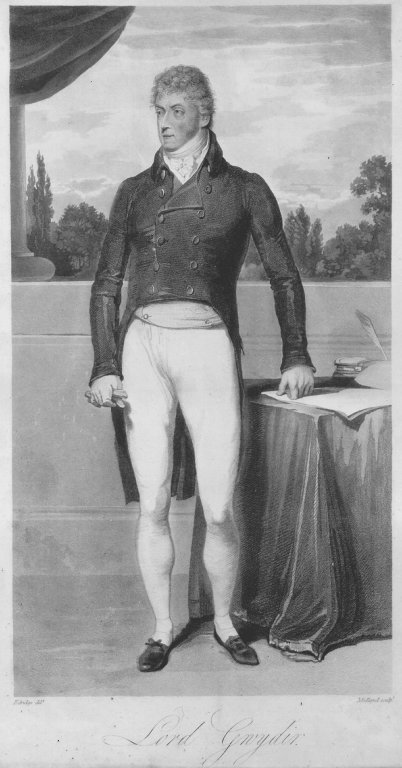
1820
(September) The Oakery, Clay Hill–
Burrell/Kelsey estate; Copy assignment of term of 1000 years 1) E W
Edgell 2)
Rt Hon Peter Robert Drummond, Lord Gwydyr [Gwydir] 3) Most Noble
Charles Duke
of Dorset and Jeffries Spranger of Lincoln's Inn, Middlesex, esq 4)
William
Bray of Great Russell Street, Bloomsbury, esq. Messuage or tenement
with stables,
barns, orchards, gardens, water, yard, passage and 8a called Crabbgrow
alias
Crabbgrove and 2a woodground and 1a arable or pasture lying in bottom
of lower
pasture of Upper Leas; also cottage and orchard, yard and backside, all
near
Clay Hill, Beckenham, Kent; also messuage or tenement called Tomlins at
Elmers
End, Beckenham, and 14a. Endorsed: 'to be reserved with Mr Wyatt
Edgell's Title
Deeds'
Peter
Robert Drummond here is in fact
Peter Burrell/Lord Gwydir’s son who adopted the name Drummond
on
marriage as
his wife came from a senior family and she had inherited the Baron
Willoughby
d’Eresby title. This is also instrumental in Peter
Burrell/Drummond
selling the
Beckenham estates. The Gwydir title later seems to have ended up with a
cousin
via a younger son of Peter Burrell IV.
With so many Peters and Peter Roberts in the family it
gets very
confusing.
Morning
Chronicle 18 October 1820
1820
- 31st October the sale of Burrell estates is advertised "Freehold
estate
Langley
Park, Langley Farm, Langley Lodge, Kelsey
Park and Eden Farm. Water Mill, three public houses, sundry farms,
lands and woods.
With
maps."
1821
– William Thornhill Cator is born
at Beckenham Place, the younger of John Barwell Cator's two sons. This
evidences that the Cators were still occupying the mansion at least for
some of
the time as Barwell spent some time in Ireland and Norfolk and some
children
were born in Ireland. See 1823 Anne Charlotte Cator.
1821
– The Census; May 29th;
This press cutting describes the process and states that at the
previous census
1811 there were a lot of absent males due to the Napoleonic War. The
population
of Beckenham was 1180 with figures broken down into males, females and
divided
up into various age groups. Those familiar with genealogy research will
know
that the first generally available national census is for 1841 but the
census
started in 1801. This 1821 Census records the household under the
family
surname with data for the male, female, children of the household.

1821 – Mary Elliot, servant to John Barwell Cator and his wife Elizabeth of Beckenham Place leaves a will; mentions Mrs Cator and two of their children. Various bequests of effects and sums of money.
1822 - Langley; Emmanuel Goodhart purchases Langley Park from the Burrell estate. Covenant to produce deeds. 12 November 1822 Lord Gwydir and Emanuel Goodhart of Langley Park, esq to Thomas Stow. See the 1838 tithe map and returns. 1821 Langley etc; Date:1821-1823 Langley mansion with land (366 acres) including cottages at Wickham Green, Gamekeeper's Lodge and Bath House, all in Beckenham, West Wickham and Hayes. Including conveyance by Peter Robert Drummond Lord Gwydyr and others to Emmanuel Goodhart of New Grove, Bromley, Middlesex 1822, with map annexed. Held At:Kent History and Library Centre Document Order #:U1435/T1 bdl 6
1825
– Burrell, Kelsey and Langley;
following the death of Lord Gwydir (Peter Burrell IV) in 1820 the
Burrells
centred their activities elsewhere in Lincolnshire and Sussex and the
Beckenham
Estates were sold in lots. There were it seems more than 70 lots, many
of them
small properties, but some large lots which can be seen from the
documents in
Bromley Collections and deduced from the 1838 Tithe map and returns.
1825
– Cator Estate; John Barwell Cator and other
trustees of the Cator estate acquire permission via a private Act of
Parliament
to lease or sell plots of land for development on the Beckenham
Estates. This
is the beginning of a long process of disposal of the Beckenham estates
which
leads to the ‘remainder’ becoming the Beckenham
Place public park.
John Cator's Will
had put
family trustees in place and restrictions on selling land. His will
stipulated
that his estate was for the use of John Barwell Cator with remainder to
his
heirs or assigns and the family were ‘remaindered’
in order of
seniority. He
also stipulated that leases should not exceed 21 years and that
Beckenham Place
would not be leased. No land was to be sold so an Act of Parliament was
required to permit J.Barwell Cator and the trustees to dispose of or
exchange
lands. This extract explains that sales from the estate have to be
matched by purchases
of new lands either close to the Beckenham and Kent holdings or near
Woodbastwick. John Barwell Cator is said to have sold land in Croydon
to enable
the purchase of more land in Norfolk:
“An
Act to enable John Cator, Esquire
to grant building leases of lands in the counties of Kent, Surrey,
Essex and
Hereford; and also for vesting in Trustees for sale part of the Estates
in said
Counties devised by the will of John Cator Esquire, deceased, and for
laying
out the money arising from such Sales respectively, under the Direction
of the
High Court of Chancery, in the Purchase of other estates, to be settled
to the
same Uses; and for other purposes. Schedule 1 includes particulars of
property
purchased prior to and after the death of Cator.”
The
intention was that the ‘estate’
remained intact for the family at least in value if not geographically
fixed.
The
petition on the Act was signed by
John Barwell Cator, William Cator, Bertie Cornelius Cator, Sarah Cator,
Thomas
Cator, Charles Cator and Peter Cator. These were the surviving children
of
Joseph Cator. It is interesting that this Act is not sought until after
the
death of Joseph Cator in 1818.
As well as defining the property the Act lists the tenants of the Cators' at the time of the Act. This can be compared to later records such as the 1838 Tithe map and returns as well as census records which become more reliable and detailed from 1851.
The
papers of Mother Mary Baptist
(formerly Bessie Taylor) for her 1967 thesis include the transcript of
the properties
covered by the Act. It illuminates the extent of the Cator properties
in
Beckenham and the section for “Additional
Information” will include
more
details from the Act. Pat Manning also acquired copies of the property
schedules in the act from the House of Lords archive. The schedules
list
fields, acreages, tenants and rents. Several locations can be
identified from
old Ordnance Survey maps, for example, the Addington properties are
located
around what is now New Addington at Lodge Lane and Castle Hill. Some
descriptions are vague and cannot be accurately located ie. Mansion in
the
Parish of Battersea with meadows (Probably Penge Place).
A
reason cited for the application or
petition for the Act was that there had been built development around
the edges
of the estate thereby make development of the estate advantageous. A
similar
reason was given by the Burrells and Raymonds in 1759 for seeking to
develop
parts of their estates probably around the edges of Bromley and
Beckenham
towns.
Briefly, the estate was in Beckenham (1108 acres purchased before
1806),
Carshalton (12 acres), Croydon (about 560 acres), Addington, Chelsham
and
Farleigh (over 1100 acres), Ross, Herefordshire (only 9 acres),
Chingford,
Loughton and Waltham Abbey (about 140 acres), Bromley (about 25 acres),
Lewisham (about 95 acres/ at Wricklemarsh and/or Sydenham), Chittenden
Farm at
Chiddingston and Hever in Kent (193 acres), Penge (55 acres before
Cator’s
death, 176 acres purchased after his death), Leigh Park Farm and Priory
Farm,
at Leigh, Kent (280 acres). Wricklemarsh isn’t separately
identified
and
whether it is included in the Lewisham figure or disposed of already is
unclear. Of note is the land in Penge acquired after John’s
death in
1806 which
Pat Manning attributes to Joseph Cator. References to the Cator
involvement in
Penge Common can be found and also involvement with the
Croydon
Canal company. I was surprised to see that land in Ross was only 9
acres
compared to the extent of the other estates.
John
Barwell Cator subsequently was
widely referred to as just 'John Cator' which leads to some confusion
over
estate affairs and attribution of some developments to the wrong
'John'. The
given names of the Cator 'landlords' alternate between
‘John’ and
‘Albemarle’
but John (Barwell) Cator was succeeded by his son Albemarle
(1813-1868), who's
first son John died before inheriting the estates so the second son
also named
Albemarle (1836-1906) inherited. His son John (1862-1944) followed but
he broke
tradition and had a son named Henry (1897-1965) who then returned to
tradition
having a son John (1926-1999) who's son Albemarle (1953-present) is the
current
holder of the remaining estates in Woodbastwick at time of writing
(2019).
1826
– Cator Estate; The Cators dispose
of some Cator property near Hever and Tonbridge. The British Press of
22nd July
carries an advertisement for the sale by auction of three farms listed
in
Cator's properties in the 1825 Act of Parliament. We only have the
information
in the Act, the advertisement for sale of Chittenden Farm in 1788 and
this
advertisement for sale of the three farms. Chittenden Farm near
Hever,
Leigh Park Farm and Priory Farm near Leigh (near Tonbridge, Kent).
Chittenden
Farm 193 acres, Leigh Park Farm 152 acres and Priory Farm 130 acres.
These acreages
match those recorded in the Act of Parliament and the fact that the Act
records
the intention to sell those properties for reinvestment elsewhere (ie
Woodbastwick, Norfolk).
1827 - Penge Common Enclosure Act; Commons all over the country had already been enclosed, including Sydenham and Croydon, when the Act for enclosure of Penge Common was passed in 1827. This was as a result of a petition by John (Barwell) Cator (nephew and heir of John Cator the younger). It took ten years to make the award to the various landowners. The first enclosure petition for Penge Common was made to Parliament fifty years earlier. Penge was exceptional both for the time it took and its late date. There had been much opposition from the Vestry (Parish Council?) and some latterly from the Lord of the Manor of Battersea, Earl Spencer. Dr B. Taylor shows that a large amount of land at both ends of Penge ‘Common’ had already been enclosed by non-parliamentary means before the act of 1827.
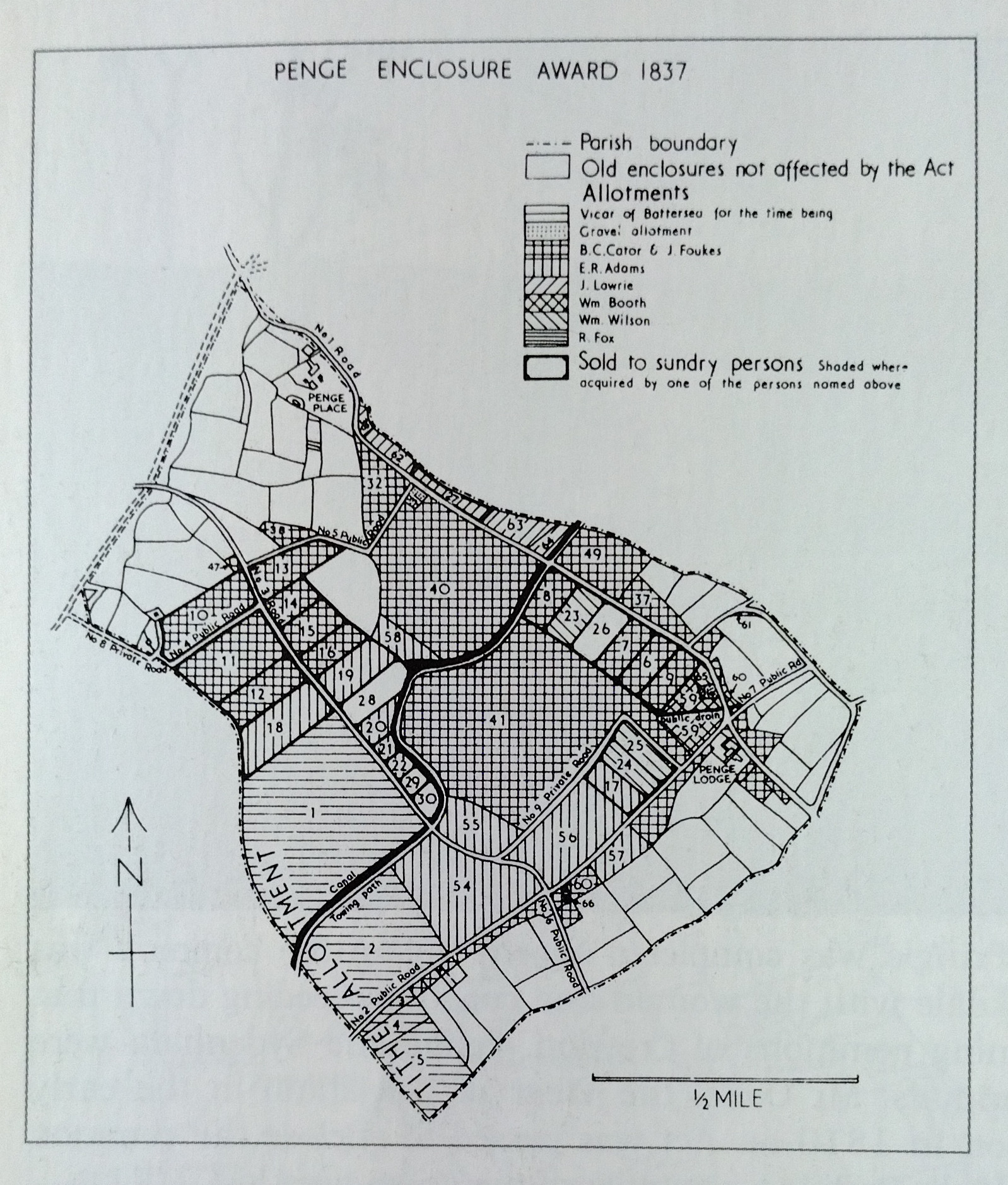
The dark line on the map is the old Croydon Canal route.
(BHC and David Johnson "Around Crystal Palace and Penge") The diagram appears to be wrongly dated 1837 but although the original act is passed in 1827 it is not settled until 1837 (source; Cator v Croydon Canal Company)
1827 - Eden Farm (Park); The catalogue for the 54th Royal Academy Exhibition 1827 (MDCCCXXVII) lists; item 925 A perspective drawing of a mansion lately erected for John Woolley Esq, Beckenham, Kent G.Robins (artist?)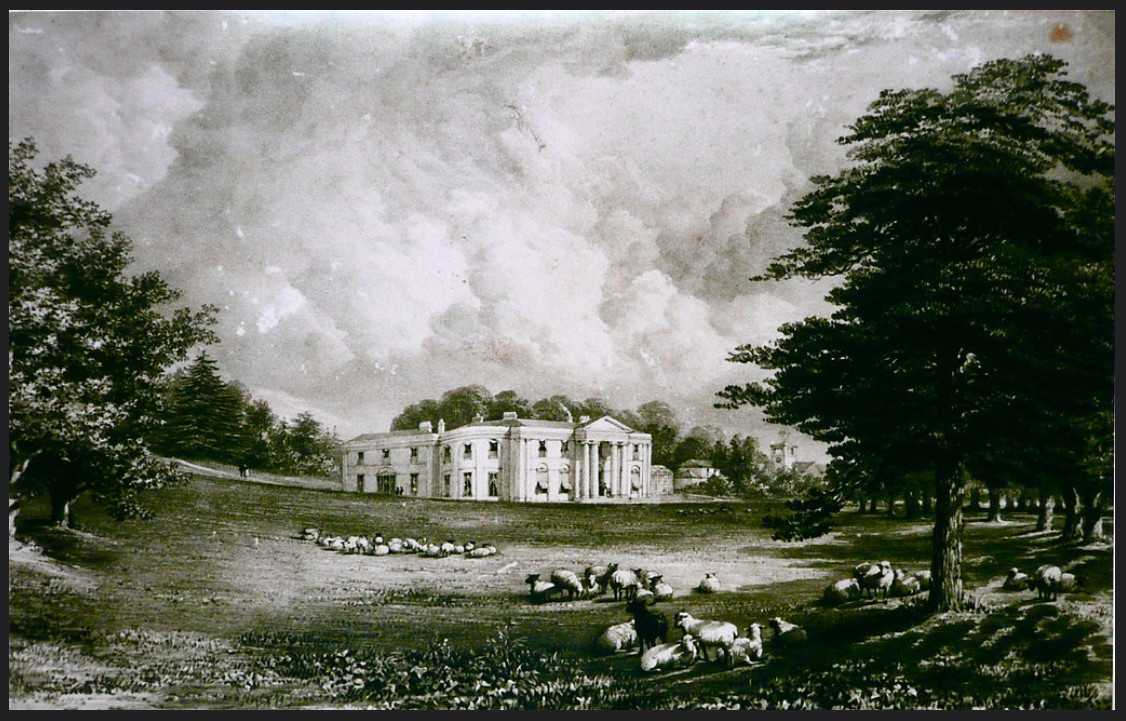
1827
– West Wickham Workhouse etc; The
Weekley Times (London) 14th January reports on a
theft

Evidence
regarding the workhouse at Wickham Green
is scant but this and a few other records shed some light on its
existence.
1827
– The Morning Post of 16 August
1827 records that the daughter of James West of Beckenham Place and
Bryanston
Square marries Charles Wyndham Rawdon in Beckenham Church. Evidence of
an early
lease of Beckenham
Place.
1828
– The Cators acquire Kent House
Farm from Alexander and Thomas Baring (National Archive and Lewisham
Local
Studies) Indenture regarding title to Kent House Farm. See 1691 for the
beginning of records in this bundle. The John
Cator mentioned is John Barwell Cator, nephew of John
Cator of
Beckenham
Place.
Indenture
of Lease and release dated 26 and 27 July 1828, Alexander Baring, Sir
Thos.
Baring, John Cator, Wm. Cator and Bertie C. Cator in trust for Ann
Loveday and
John. Brundrett.
image
Details
of field names and acreages of land on Kent
House Farm and Penge Common, with names of tenants.
Following
the Cator Private Act of Parliament of
1825 granting Cator the permission to sell building leases, this
purchase
follows some earlier sales of Norwood and Rockhills parts of the
estate. Kent
House adjoins other Cator property such as Clockhouse and the former
Beckenham
Manor land.
1828
– W.H.Ireland publishes his New
and Complete History of Kent drawing on previous publications by
Philipot,
Hasted and Lysons. He describes the Manor of Foxgrove becoming divided
in the
1700’s in three parts which we found to be Mary
Tilly’s will to
Timewell,
Bridges and Tolson Tilly’s widow, then Jones Raymond, the
Burrell’s and John
Cator. He describes Beckenham Place Park
being embellished with infinite taste by its affluent proprietor (John
Barwell
Cator).
1828
- London Evening Standard 29
September 1828 records David Inglis from Tunbridge Wells for (removed
to) Beckenham
Place. Newspaper small ads published changes of address and movements
of people
(the social media of the day).
1828
– Kent House Farm; acquired by John Barwell Cator et al from
the
Barings. The accompanying documents summarise the passage of Kent House
through
several previous owners.
1828
– Kelsey; after the Gwydir sale,
Edward Grose Smith had purchased a significant part of the Burrell
estates and
subsequently sold it off in sections.
Bromley
Collections 834/7a-b
Lease and release for £5,400 of
capital messuage in Kelsey Park, bailiff's house, lodge, and land (40a.
20r.
11p.), including land covered by water, late occ. Hon. Henry Windsor,
now occ.
Edward Grose Smith (abuttals given). Recitals 1794-1827; 28/29 May
18281. Duke
of Dorset and Jefferies Spranger
2. Lord Gwydyr
3. John Wooley, Charles William Hallett and Marmaduke Robinson
4. Greenway Robins
5. Edward Grose Smith
6. Frederick Lock of Arundel St., Middx, gent.
plan (endorsed)
John Woolley also acquires parts of Kelsey on the west side of Wickham Road totalling about 12 acres, presumably for development. The land is acquired from the Burrell estate and trustees so presumably did not pass through the ownership of Edward Grose Smith who had acquired other parts of Kelsey.
On
the 1838 Tithe John Woolley owns about 500 acres of property
in Beckenham.
1829 - Alexander D. Inglis recorded as tenant of Beckenham Place Mansion in the Morning Post 22 August 1829. Pat Manning reports that the Cator family believe J.Barwell Cator occupied the mansion up to 1841 but these other tenants cast some doubt on it. It’s entirely possible that J.Barwell Cator leased the mansion during periods when he was resident in Ireland or Woodbastwick, Norfolk.
1829
- Reverend William Rose of St.George’s dies, His will leaves
a
substantial sum of money to his daughters. (£1500 apiece)
1830
- Foxgrove Farm Manor house is
demolished and a new farm house built. We don’t have detailed
maps pre
1833 so
we can only compare footprints on maps from 1833, 1864 and later.
(source: Borrowman
and Rob Copeland)
1831 – The Kentish Weekly Post records a daughter born to the wife of Alexander Inglis at Beckenham Place. Tenants of the Cator's the Inglis’s leave by 1834.
1832 - Langley Lodge; The Morning Herald, 5th May London advertises Langley Lodge to let. Emanuel Goodhart is the landlord and the property is 'in hand' in the 1838 tithe presumably empty? By the 1851 census Emanuel Goodhart's son Charles is living at Langley Lodge with his family and servants. The reference to Repton's landscaping is authenticated to some degree by the installation of paladian columns to the Lodge and the landscape drawings in his Langley Red Book.
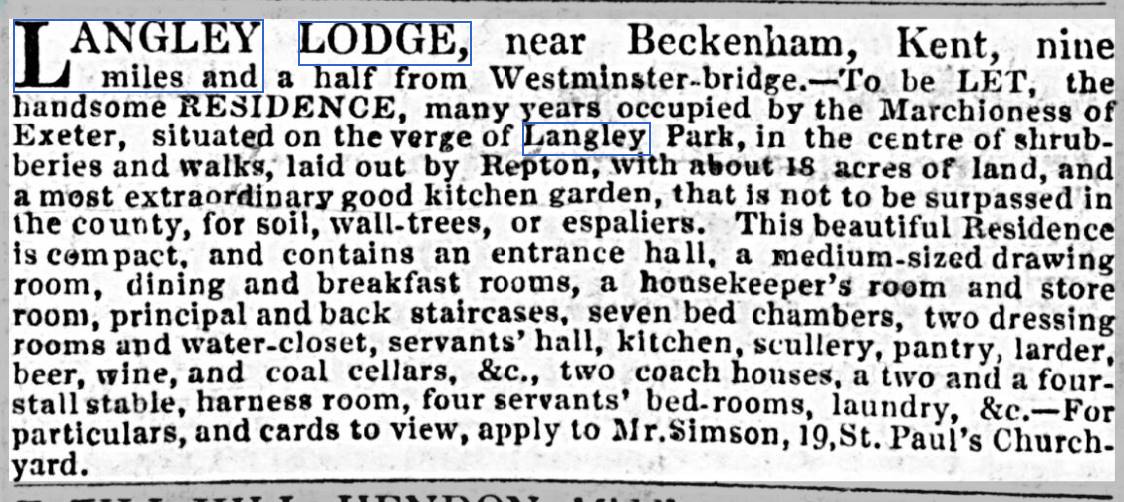
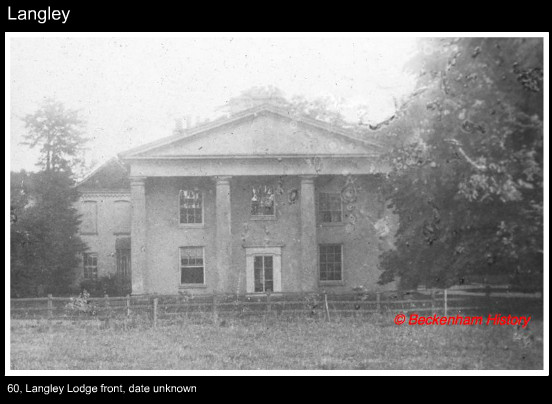
1832/33
– Kelsey; is occupied by the
Grose-Smiths. Edward and two sons Heathfield and Henly. Edward had
become an
attorney and solicitor for the Court of Chancery and his sons had
entered into
apprenticeships as clerks. They are variously registered in poll books
for the
City of London. Edward had married Mary Fielder Heathfield in 1792
hence the
name Heathfield of one of their sons.
1833
- An estate plan is produced: Map
entitled: 'Plan of an Estate belonging to John (Barwell) Cator Esq
situate in
the Parishes of Beckenham, Lewisham and Bromley in the County of Kent'.
It shows
roads, field boundaries, Southend, parish boundaries (with Croydon and
Penge)
and boundary with Lord Farnborough's lands. Scale is 5 1/2 cm: 1/4
mile.
Certified as 'Plan marked B3' in declaration of Thomas Henry Burroughes
and
John Cator (Bromley Library).
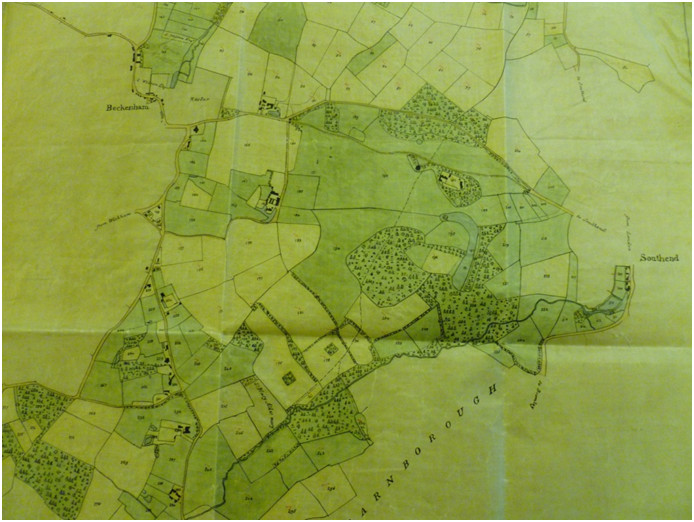
Reproduced
courtesy
of Bromley Historic Collections
This
extract from the map raises some
questions as a subsequent estate plan says that shaded areas are on
long leases
to tenants so probably the same is true of this one. It is frustrating
that any
accompanying documents are not with the map which would have given
field names
and leaseholders. I assume unnumbered fields or buildings are not Cator
property but illustrated for mapping detail, and perhaps seen as
potential
purchases? Although Barwell Cator was decamping to Norfolk the family
were
still dealing in this area as evidenced by documents concerning the
Croydon
Canal and Penge Common. Comparison with the Foxgrove plan and Beckenham
Manor
plan shows that field patterns changed and the River Pool was
straightened for
some of its course. Maybe some leaseholds can be identified from the
descriptions in the 1825 Act of Parliament document. The map is
orientated with
West at the top and does illustrate how the Cator land was mainly to
the north
of the village. Even so there are plots belonging to others. S.Wilson
Esq
having some of the north side of the High Street including plots which
had been
Cator’s on the 1776 Foxgrove plan and G.Austin has the area
around
Thayers Farm
north of Clockhouse. G. Austin is probably an heir of Francis Motley
Austin
found on the 1809 Burrell map. Lord Farnborough to the east of
Cator’s
land had
the estate around what is now Bromley Court Hotel.
1834 – Launcelot Holland is recorded as tenant of Beckenham Place in the South Eastern Gazette 21 January 1834 when his daughter marries Charles Manners Forster, son of John Forster of Southend. Launcelot Holland would later be tenant or occupant of Emanuel Goodhart's Langley Farm in the 1838 tithe and 1841 census living on independent means. Martha Cator, daughter of Peter Cator, marries Launcelot’s son Henry Holland in 1841 so there are family ties and associations.
1834 - Penge Place and Common etc.; John Barwell Cator and his trustees who had purchased Penge Place in 1813 put the property up for sale, advertised in the County Courier and London Chronicle etc. Penge Place occupied by Mr. Peters. Penge Farm. Whether this 'Peters' is the same or related to the Peters who took residence at Beckenham Place in 1835 is a question and if Penge Place is sold by the Cators then offering Peters the alternative of Beckenham Place is possible. see 1835 and 1838.
County Chronicle:
"Kent, Surrey, and Essex. Important and very valuable Estates at Norwood, Penge, Beckenham, Chingford and Sevenoaks.
Mr Hoggart begs leave to announce for Sale, in May next some of the most valuable Estates ever offered, the chief part within six miles of the metropolis, comprising in the whole about One Thousand Acres, a great portion of which upon that delightful spot Norwood, so distinguished for the beauty of landscape scenery and extensive prospects and adapted for the erection of villas. The property commences on the ridge of the fine road from Sydenham to Croydon, bounded on one side by the road from Penge Place to Beckenham, and intersected by the new road from Norwood over Penge Common is Addington and Croydon. It includes the beautiful villa, pleasure grounds gardens and rich verdant meadows called Penge Place, in the occupation of Peters Esq.; the ornamental cottage of Mr Rose; the residences, pleasure grounds and gardens of Mr Rose, jun., Mark Brown Esq., Mr. Miller, and Mr Weare; several rich meadows near Beckenham; a valuable Farm called Mayes, with farm buildings, several cottages and buildings, the Crooked Billet public house and land, various valuable allotments ornamented with fine timber, the coal wharf and buildings on Penge Common, various pieces of rich marsh land in Chingford Marsh, cottages and land at Loughton, and two valuable farms called Leigh Park, and the Priory Farm, near Sevenoaks and Tonbridge. Future advertisements will more particularly delineate the subdivision of this very valuable and interesting property.
62 Old Broad Street, April 1834"
Several properties mentioned and this solves to some extent the mystery of some of them. Leigh Park Farm and Priory Farm are near Leigh (Tonbridge) and Chiddingstone both in Kent which had appeared in the Cator list of properties in the 1825 Private Act.
Smaller properties in Essex which had been acquired by the late John Cator are also disposed of in this sale.
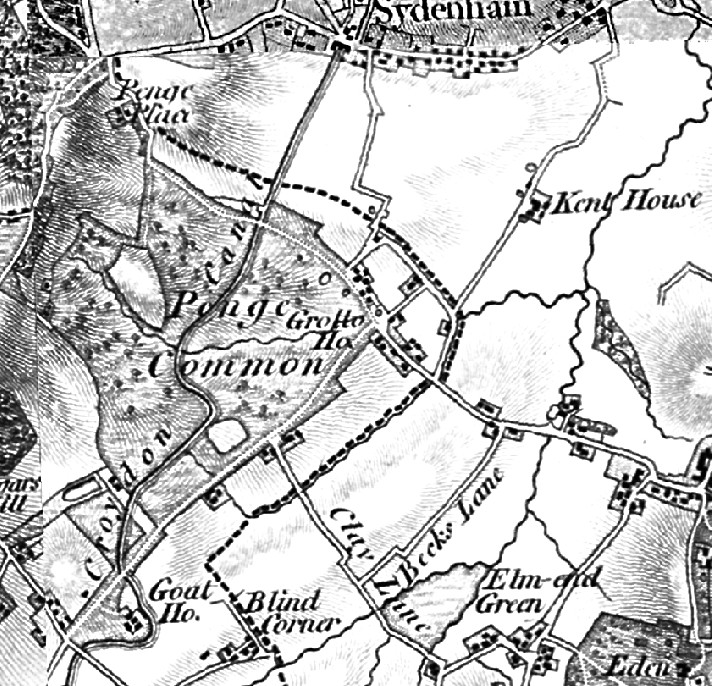
A map derived from Ordnance Survey data published in 1816. By the time of the 1838 Tithe the railway had replaced the canal. The first map on which the Croydon Canal appears.Penge Wharf (the coal wharf and buildings) and land is sold to John Lawrie of Sydenham Place
1835
-
Penge; An Act passed for the building of the railway from Croydon to
the London and Greenwich Railway following the route of the now defunct
Croydon Canal. The Canal Company had become insolvent circa 1822.
1835
– John Cator (1835-1859), eldest
son of Albemarle Cator the elder is born but will not survive to
inherit the
estates, he dies in 1859 of wounds received in the Crimea. His birth
date is
subject of some speculation as the family may have been in Ireland at
the time
of his birth. Two siblings were born in Ireland but his younger brother
Albemarle who does inherit, was born at Woodbastwick. This evidences
that the
Cators were mainly absent from Beckenham around this time. John Barwell
Cator,
the father/grandfather was also in Ireland very often at this time.
(source:
P.Manning and census evidence)
1835
- Mr Peters a banker is tenant at
Beckenham Place. Whether some shading of the estate map reflects his
lease is
unclear. William Peters is recorded on the 1838/40 tithe map and
returns and a Peters was resident at Penge Place in 1834 when John
Barwell Cator put it up for sale. Peters was succeeded at Beckenham
Place by Captain Walter Raleigh Gilbert,
R.H.A., no
dates available. Followed by R.H. Page who later changed his name to
Page‑Henderson.
Although census records note the occupants of the village there are not
addresses in the first records. Later census records give addresses and
eventually occupiers complete their own census returns. The 1838 Tithe
map
shows Beckenham Place divided into the leased house and grounds and
land under
Foxgrove Farm on the east side.
1835
– These details relate to sales of
parts of the Beckenham and Penge Cator estates. Bromley archive has
this
document relating to Penge Place and Farm which will become Crystal
Palace
Park: John (Barwell) Cator Albemarle Cator Thomas
Mason of
Linden grove, Bayswater, Middlesex, Surveyor (2) John Scott of
New
Broad
street, London, Esquire Property: Mansion House, stable and grounds
called
Penge Place, lately in the occupation of Henry Peters, Esquire. Also
Penge
Cottage, farmyard and stables, lately in the possession
of Joseph Rose. Also 93 acres, 3 roods and 24 perches
of land
in the
occupation of Peters, Rose and William Wilmot, all as tenants. Also
Upper Barn
Field, the Grove, part of Upper Wood, part of Hermitage Wood,
part
of
Windmill Hill Field, Three Gate Field, Holly, Rag Field, Six Acre
Field,
Shoulder of Mutton Field, Nine Acres, Five Acre Field, Coal Earth Field
and
Filbert Orchard. All in Penge, Battersea, Surrey. Terms: 1st parties
bargain
and sell to the 2nd party, to hold for a year, at the rent of a
peppercorn. (b) Attested Copy Conveyance Parties: (1) Bertie
Cornelius
Cator and John Foakes(2) John Cator(3) Albemarle Cator(4) Thomas
Allason (owner
of lots 5,6,23,24,25)(5) John Scott(6) George Grote Property: As above
Consideration: £11,750 14s 6dTerms: 1st and 2nd parties
release Penge
Place to
Scott, Grote as trustee
Also
in 1835 The Crooked Billet public
house, Penge Wharf and several other properties are offered for
freehold sale
in three newspapers. As the Crooked Billet and other Penge property had
been in
Cator possession it is almost certain these sales were by John Barwell
Cator.
Penge Wharf is recorded as being part of George Wythes property at a
later date
and it is known that George Wythes bought a lot of Cator property and
subsequently developed it. One reason why my view is that the Cators
were not
the development and planning activists as some believe.
Penge
Wharf is purchased by John Lawrie
of Sydenham Place. Lease and release was a form of land sale made to
avoid tax,
later made illegal. 14/15 October 1835(a) Lease
Parties: (1) Bertie Cornelius Cator, John Foakes, John Cator and
Albemarle
Cator
(2) John Lawrie of Sydenham Place, Kent, Esquire
Property: Wharf, warehouse, lately erected barn, garden and premises on
the
borders of the
Croydon Canal and known as Penge Wharf. Also
warehouse,
containing in
total
1 acre, 18 perches, adjoining meadow containing 3 roods and 15 perches
in the
occupation of William Walton. Also 2 further portions of land
in Penge,
containing
2 acres, 2 roods and 30 perches and 1 acres 35 perches.
Consideration: 5s paid by 2nd parties to 1st party
Terms: 1st parties bargain and sell to the 2nd party, to hold for a
year, at
the rent of a
peppercorn.
(b) Release
Parties: (1) Bertie Cornelius Cator and John Foakes (trustees)
(2) John Cator and Albemarle Cator
(3) John Lawrie
(4) William Thomas Longbourne of Gray's Inn, Middlesex, Gentleman
Property: As above
Consideration: £3408 7s 1d
Terms: Land is conveyed to Lawrie
Other details: Plan shows land sold and surrounding land owners.
Penge
Wharf on the Croydon Canal was becoming or had become redundant due to
the coming of the railways.
1835
- Kelsey sale by Edward Grose Smith to
Henry Merrick Hoare. Edward Grose Smith had bought it from the Gwydir
sale of
Langley and Kelsey. This 63 acres is just part of the overall Kelsey estate
accumulated
by the Burrells. Other parts to the south and west had been bought by John Woolley in 1820.
|
London
Borough of Bromley Archives |
|
|
Level |
Item |
|
Ref
No |
|
|
Title |
Contract
for sale and purchase for £8,000 of Kelsey Park; mansion
house,
offices, outbuildings, gardener's house, lodge, greenhouses, 2 pews in
Beckenham Church, gardens, land and water (63a) |
|
Date |
6
Jul 1835 |
|
Description |
Edward
Grose Smith |
|
Extent |
1
Item |
1836
- Albemarle Cator II (1836-1906) is
born at Woodbastwick, Norfolk. The family return to Ireland where
subsequent
siblings are born until about 1844 according to census evidence his
sister
Charlotte is born in 1838 in Ireland. With Albemarle’s
wife’s family
being in
Ireland it is possible they travelled back and forth if she felt more
comfortable going into labour near her family.
This
is also the year of a great storm,
from The Evening Chronicle 02 December 1836 "The storm of
Tuesday
morning raged here with great violence. In Langley Park above 100 trees
have
been uprooted. In Kelsey, Eden Farm and Beckenham Place forest trees of
the
largest dimensions are lying in all directions.
1837
- Queen Victoria until 1901
1837 – Cator estate sale, Shortlands House and Norwood/Penge Common John Barwell Cator and his trustees put some property up for sale in the County Chronicle, Surrey Herald and Weekly Advertiser for Kent 25 July 1837 page 2 col
170
acres
on Penge
Common and 15 acres more, Shortlands House and 56 acres with Lodge Farm
(Bromley/Shortlands borders) 75 acres, Norwood and Penge Common 40
acres, 50
acres and 42 acres, Oakery 9 acres (on Bromley Road), adj (Mr Scott) 23
acres,
adj 9 acres, adj 1 acre. (total 490 acres)
Shortlands
House with 100 acres is
owned by Mrs Palmer in the Tithe of the following year. 18 acres
sub-let.
Significantly
these are sales of
previously leased properties with sitting tenants in some cases.
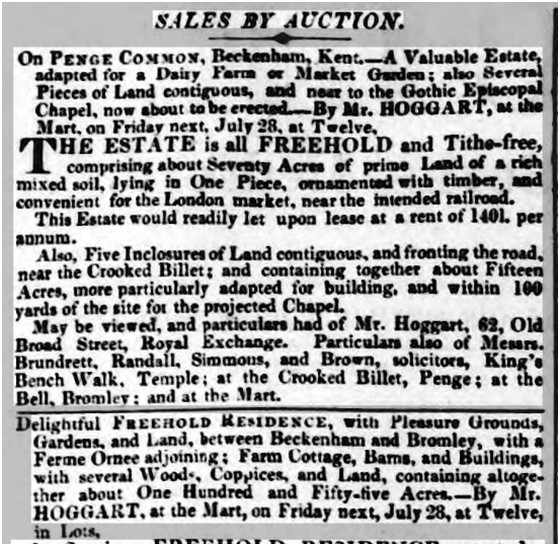
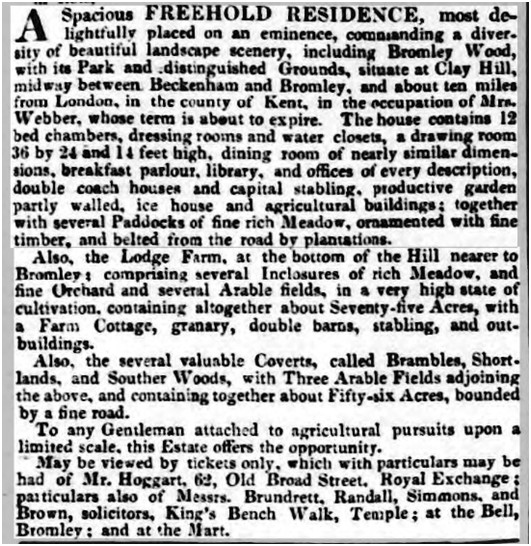
1837 -
Thayers Farm / Cator; 02/12/1837; Conveyance of Thayers Farm, Beckenham
between Sir John
Cholmeley, 6of Easton, Lincolnshire; William John Campion the younger,
of Itchen Abbots, Hampshire; Samual Forster, of Lincolns Inn,
Middlesex, esquire and Henry Forster, of Southend, Kent, Captain in the
Royal Artillary (1st part);
Henry Goodford, of Chiltern Cantels,
Somerset, esquire; Stephen Cholmeley, of Wainfleet, Lincolnshire,
esquire; the Reverend John Thomas Austen, of Aldworth, near Reading,
Berkshire, Clerk and Thomas Phillip Waite, of Louth, Lincolnshire,
esquire (2nd part);
The Reverend Richard Stewart Evelyn Forster, of Carlton, Lincolnshire,
Clerk and Catherine, his wife (3rd part),
and the Reverend John Brownrigge Collisson, now residing at Charmouth,
Dorset, Clerk and Sarah, his wife (4th part),
and Albemarle Cator, of Beckenham Place Park, Kent, esquire (5th part).
In
consideration of the sum of £2000 paid to the 1st parties and
£2000
paid to the 2nd parties, the property is conveyed to Cator. Includes a
map of the property. BHC 989/4/1/2
As Thayers Farm was part of the Thomas Motley properties descended to Francis Motley Austin the mention of John Thomas Austen seems coincidental and how the Forsters of Southend became involved is curious. But Francis Austin held extensive property extending into Lewisham so some complex bequests etc could esplain it.
1838
- The Tithe Map and returns for
Beckenham shows the landowners and occupants of the Parish. William
Peters is
already the tenant of Beckenham Place House and parts of the park,
71 acres.
But other parts of the park are occupied by the tenant of Foxgrove
Farm,
William Gibbons who is managing 274 acres. Michael Mathews who is
tenant of
Copers Cope Farm holds 534 acres, some of which extends to
Bell
Green.
Early maps and the Tithe map demonstrate that reorganization
and
renaming
of fields has occurred presumably as farming practices change with new
methods
such as crop rotation. The data from the source below allows us to add
up all
the acreages for each landowner, see who the landlords were and their
tenants.
A quick summary can be made of the share of the parish owned by each
landlord
ie the Cators; John (1060 acres), William (194 acres) and Albemarle (45
acres)
had between them about 1300 acres, John having the most. The total for
the
Parish is about 3900 acres. Hence, the Cators owned about one third of
the
Parish. By 1838 the former large landowner, Peter Burrell/Lord Gwydir
had died
and his estates sold to the Goodharts, Woolley and Hoare families as
well as
others. A fuller evaluation of the share of the parish owned by the
larger
landlords will be added soon. The total acreage for the parish is also
interesting when compared to the known acreage of Beckenham Manor in
1623 ie
193 acres. It can also be compared to rough estimates based on the
Domesday
Book for Beckenham which described 8 carucates estimated at 120 acres
each
being about 960 acres, plus unknown areas of woodland, waste, church
and crown
land.
Other
landlords and their
share/property:
Richard
Adams 83
acres,
Ambrose
Austin (who
is not adescendant of Francis Motley Austin so far as we can tell) 165
acres at
Elmers End Old and New Farms,
Albemarle
Cator 45
acres Thayers Farm occupied by William Inglis
John
Barwell Cator about
1300 acres inc.
Copers Cope Farm, Kent
House Farm, Foxgrove Farm, Beckenham Place, Rockhills and miscellaneous
properties.
Edward
Cranfield 168
acres, New Farm let to William Skinner
Edward
Adams 83 acres
Elmer Lodge
Emanuel
Goodhart 723
acres Langley Park,
Peter
Richard Hoare 61 acres
Kelsey Park and the old Beckenham Manor House,
John
Laurie 111
acres, Sydenham Park/Rockhill
Mrs.
Palmer 100
acres, Shortlands House, Clay Hill
John
Woolley 500
acres, including Kelsey and Eden Park. Most sub let and Woolley lives
at Beckenham Lodge with 28 acres 'in hand'.
Robert
Gibson 90
acres The Oakery, Clay Hill
Rev L.V.Harcourt (Glebe land) 50 acres.
Cornelius
Lea Wilson owned and occuped Village Place otherwise
known
as The Cedars with about 11 or 12 acres of mixed land and leased or let
properties around the High Street.
Various
other small
landowners make up the rest.
The
Tithe shows a
total acreage of about 3755 acres.
These
landlords
sub-let in many cases ie John Woolley was owner of Eden Park which was
leased
to Edward Lawford 329 acres. Woolley also leased Kelsey Cottage to
Herbert
Jenner. Woolley appears to be occupying Beckenham Lodge and adjoining
land as
it is shown ‘in hand’ on the tithe return. Peter
Richard Hoare holds
and occupies
Kelsey mansion and grounds. Henry Merryk Hoare holds the Manor House
and
grounds but it is leased to Matthew Fortescue. Just
south
of Kelsey Cottage was Lee Grove owned by William
Wright
but leased to William Whitmore.
The
Tithe map and returns are cross referenced with numbered plots. Some
but not all fields are named so identifying the plot against the tithe
has to
be done using the numbering system. Some areas are easier to identify
than
others ie Goodhart had Langley and Langley Farm, Adams had Elmer Farm
yard and
buildings (Elmers End), Ambrose Austin also had land around Elmers End
in some
cases which may have come down to him from Thomas Motley but he had a
tenant,
Paget and apparently lived in a small house in the village as an
agricultural
labourer.
(source;
https://www.kentarchaeology.org.uk/research/tithes/beckenham#02.htm)

Extract from the Tithe map.The village and Croydon Road
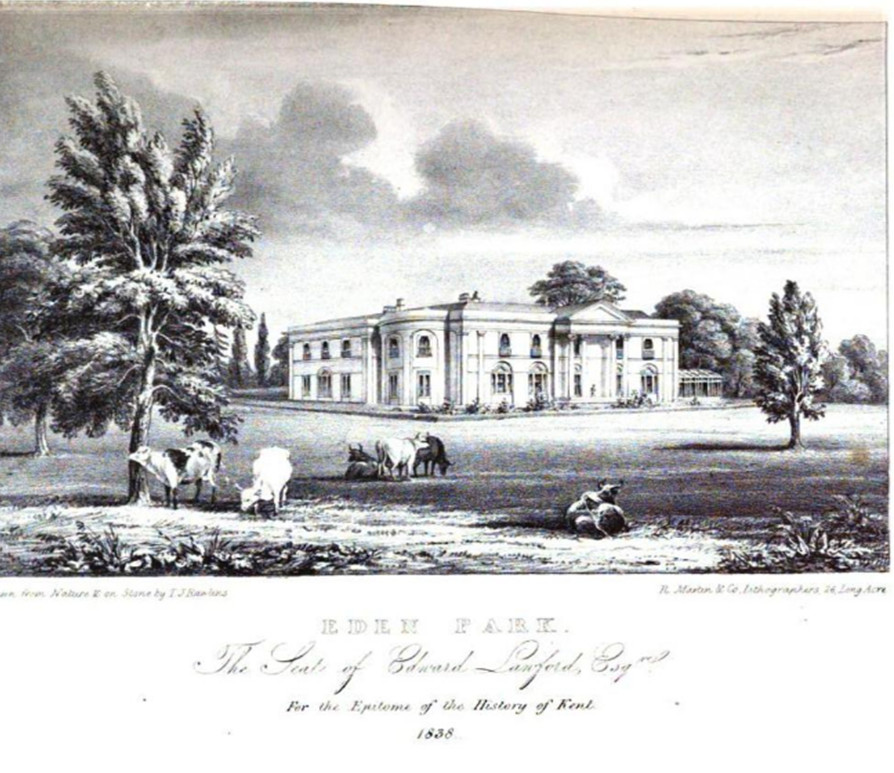
1838
– Clockhouse; Is shown on the
Tithe map return as belonging to John Barwell Cator and described as
unoccupied.
1838
– West Wickham Workhouse, Wickham
Green; Sale by the Bromley Union, 27th
October; The Surrey
and
Middlesex Standard advertises; Apparently a small
green of
common or Glebe land was situated between Langley estates and West
Wickham. It is described as Wickham Parish on the Burrell Langley map
implying it is Glebe land and a workhouse occupied some
unidentified building there. The description of 'New' workhouse
indicates a relatively recent build or rebuild. After Emanuel Goodhart
bought the building he either built a gatehouse there or
adapted
the workhouse building. The description in the sale particulars
adds detail.
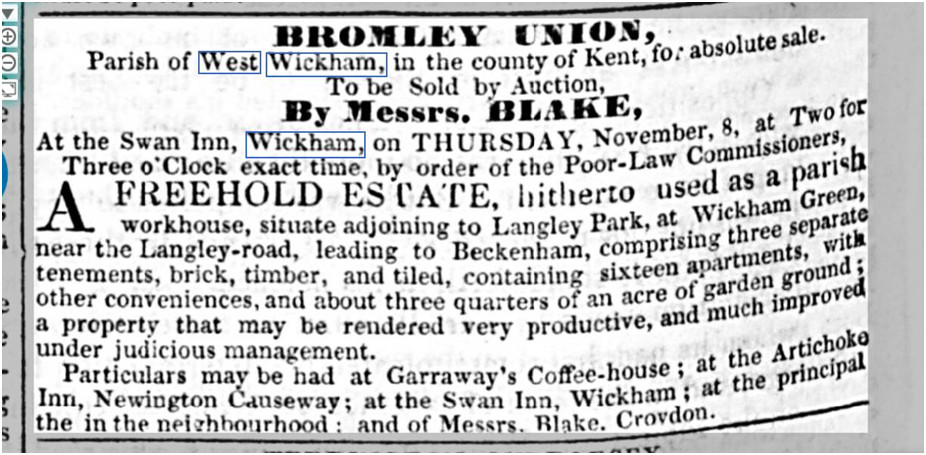
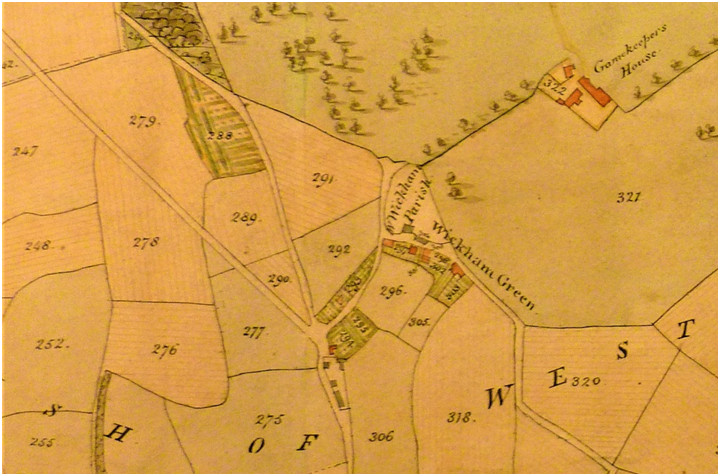
1839
– West Wickham Workhouse;
Conveyance
by Bromley Union to Emmanuel Goodhart of
Langley Park,
with
affidavit that the property was not manorial.
(Kent Archive ref U1435/T10)
1840
– John Woolley dies, buried at Norwood Cemetary on February
22nd. landowner of
substantial parts of the ex-Burrell estates such as Eden Park,
Beckenham Lodge,
Kelsey Cottage. Woolley had been a director of Atlas Insurance company
and
leaves
property in Beckenham and Norwood to his wife Grace for her lifetime
and to his
son in law William Gibbs and friend Henry Desborough. Although his will
requests burial in St.George's Beckenham he is buried at Norwood
Cemetary, one of the newer cemetaries around London. He was shown as
resident at Beckenham Lodge in 1839 on an electoral register and on the
Norwood burial register. source; Ancestry.co.uk
1841-51
– Beckenham Place; The 1841 and
1851 census show William Peters of Beckenham Place and in 1848 his
daughter
Marianne marries Captain Walter Raleigh Gilbert. Recorded in Western
Times 30th December 1848.
This
evidences the length of the Peters lease of the house which was
hitherto unknown. See 1835 which states that Walter Raleigh Gilbert
takes over
residence. Other press announcements evidence the Peter’s
residence at
Beckenham but also intimate a seasonal movement between Beckenham and
other
residences i.e. Brighton Gazette 03 April 1845 Mrs Peters and
family have
left Regency House for Beckenham Place and Sussex
Advertiser 28
March 1848
Mrs Peters has left Brunswick Terrace for Beckenham Place.
In
1841 Foxgrove Farm is shown as
occupied by William Gibbons, Farmer with family members and farm
labourers.
There is no census record of the Cators for Beckenham or Woodbastwick
as the
family is believed to be in Ireland. John Barwell Cator’s
wife’s family
was in
Ireland and though his son Albemarle was born in Beckenham, Albemarle
had
children born in Ireland by his wife who was born in Abbot Dangan,
Ireland. By
the 1851 census Albemarle had become established in Woodbastwick with
three
children upto the age of 7 born at Woodbastwick.
More extensive research into the census records from 1841 onwards can show occupations, residences and family structures. In 1841 the number of Agricultural Labourers is very high and the number of people in domestic service grows along with the building of large houses.
1841
- The Census record allows a great deal of data to be viewed. Clock
House; John Goddard, independent means occupies Clock House
with wife and 2 children and possibly step children with the surname
Morgan. By 1871 he resides at Elmer Lodge.
1845
– Eden Park; The Morning Chronicle
reports; Edward Lawford occupant of Eden
Park.
Lawford was also tenant/leaseholder in the 1838
tithe of
the Woolleys who owned Eden Park at this time.
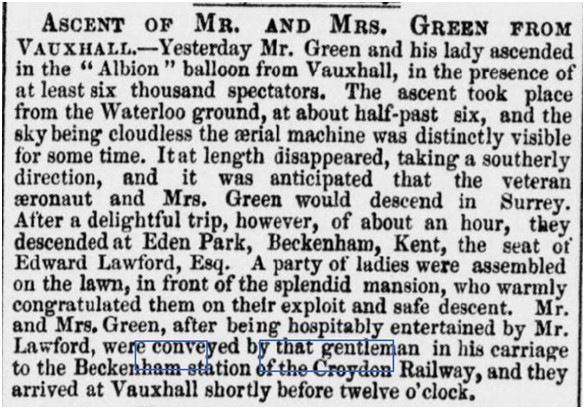
1841
– John Barwell Cator v. The
Croydon Canal Company; Cator (click link) sues the company
regarding a land purchase
relating to 1813.
1847 – Elizabeth Louisa Cator nee Mahon, wife of John Barwell Cator dies at Hessen in Germany. It is said that John Barwell Cator and Elizabeth were living in Germany to economise on living expenses having led an extravagant lifestyle. Whether true or not requires confirmation. John Cator recorded in the poll book below but it seems electors could be absentee voting by post?
1847 - Poll Book Electoral Register; John Dunkin Adams and Edward Richards Adams listed as resident at Elmer Lodge in a poll book. John Goddard at Clock House. Henry Latter is occupying John Cator's old residence at 5 Adelphi Terrace and holding some property interest in Beckenham?a
dash indicates votes cast and the 'returns' of voters seems less than
50 percent or maybe they cast their vote in another constituency for
which they qualified?
1850
– Kelsey Cottage; John Woolley
d.1840 had purchased substantial parts of the Burrell/Gwydir Kelsey
estate in
1820 and
built Kelsey Cottage. He had leased Eden Park to Edward Lawford.
Abstract
of title of Mrs Grace
Wooley, William Gibbs and Griffith Thomas,
gentleman, devisees
in trust
under the will of John Wooley, esquire to a mansion house, a messuage
called
Kelsey cottage and lands in Beckenham, Kent. Begins with lease and
release of
11/12 March 1824 and includes schedule of related deeds. (BHC ref
841/3/1/5)
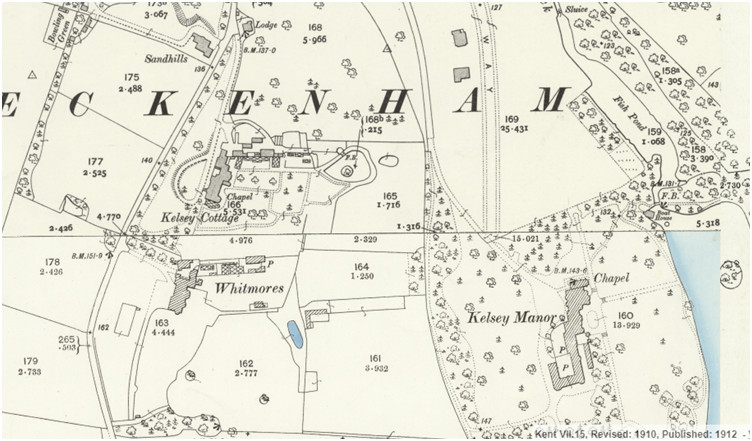
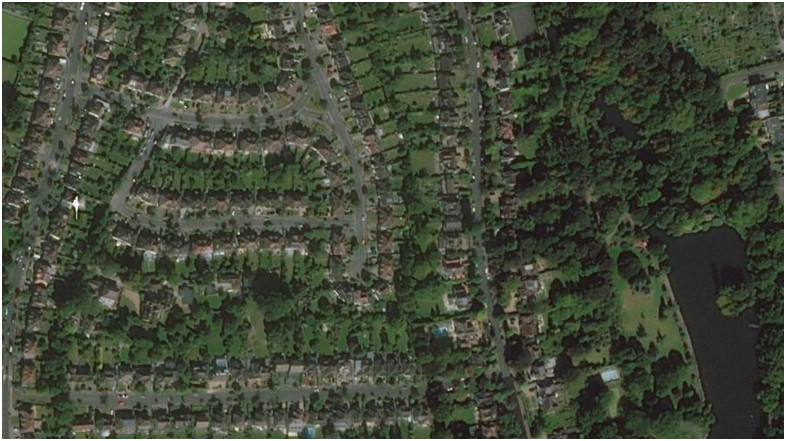
Kelsey
Cottage circa 1910 near Kelsey
Lane relative to Kelsey Manor. The house had some farmland attached.
These are
further examples of how properties were swept away with changing
ownership,
fashion and taste. With a satellite image of the same area.
1851
- April; Beckenham Manor House
(opposite St.George’s); Appears to be a lease as the property
reverts
to the
Hoare family. The Manor House and grounds become to the use of Henry
Fortescue.
Also the Manor House has a much reduced 'estate' as the bulk of the
Manor land
had been purchased by John Cator in 1773 reducing the land around the
Manor
House to 'grounds'. These had been assigned to Peter Burrell in
1757 in exchange for Woolseys Farm with Frederick St. John and by 1809
the Manor House is assigned to the Hoare family as shown on the Burrell
estate map.
Attested copy settlement of the Manor House Estate at Beckenham, Kent between Charles Hoare of Luscombe, near Dawlish, Devon, esquire and Henry Merrick Hoare of York Place, parish of St Marylebone, Middlesex and of Beckenham, esquire (1st part); Edward Tylee of Essex Street, The Strand, Middlesex, gentleman (2nd part); Henry Fortescue of Beckenham, esquire (3rd part) and Peter Richard Hoare of Fleet Street, London, esquire (4th part). Tylee assigns and the first parties confirm the property to Fortescue and Peter Hoare to the use of Fortescue for life then to Caroline, his wife, then to Francis, his son and in default of issue to Peter Hoare and his heirs. (Bromley Collections)
Some research may reveal a family relationship between Fortescue and Hoare?
1851
– William Peters occupies
Beckenham Place Park (since 1841 or earlier) shown in the census.
1851
to 1873 - Peter Cator is living at
The Hall, Bromley Road, Beckenham. He is recorded as managing the Cator
estate
locally after spending several years in Madras. (sources: census,
Manning and
BHS). The 1851 census shows Albemarle Cator, the figurehead of the
estates living
at Woodbastwick and all his children are born in Ireland or Norfolk.
The 1868
report of the Cator Estate shows that Peter Cator is renting
‘Beckenham
Hall’
from the estate along with a block of five cottages since 1864. There
is little
evidence to show that Peter Cator is managing the estate and maybe this
has
emerged anecdotally is a question.
1852
– Crystal Palace, site of; at
Penge Common and Rockhills. By
comparing
the Beckenham Manor map of 1623 (1768 copy) and later Ordnance Survey
maps
circa 1860 we can see that the ‘Penge Common’ part
of Beckenham Manor
now lies
at least partially within Crystal Palace Park. A little to
the
north of
the site of the
palace, and overlooking
the grounds, stood Rockhill, from 1852 the residence of Sir Joseph
Paxton, the
designer of the Crystal Palace, the Great Exhibition building of 1851,
of
Chatsworth conservatory and gardens, etc.
Site
of the Crystal Palace 1852.
The direction of view is unknown
1853 - Beckenham Parish; In 1853, in consequence of the appearance of cholera in this country, a committee was formed to combat the scourge. It is hardly to the credit of Beckenham that the Relieving Officer reported that he considered the condition of the Parish was “the most dirty of the Parishes within his “ range.” (Borrowman 1910)
1853 – Rob Copeland records in his Manors of Beckenham that occupation of Foxgrove Farm passes from William Gibbons to his son Henry Gibbons. Under lease from the Cator estate as the farm is in Cator ownership in the 1838 Tithe. But the 1857 electoral roll lists William Gibbons in occupation. The 1851 census shows William as head and Henry as farm bailiff, perhaps William is retired. The 1861 census shows Henry as head of the household. From an OS map of about that time we might deduce where the Foxgrove Farm and Beckenham Place boundaries met and again the Tithe map and returns allow for fields to be placed under either property. On the OS map parkland was shaded and other fields in plain white.
1854 - Crystal Palace completed? at Sydenham Hill/Penge Common. (first column raised in 1852 - Borrowman 1910)
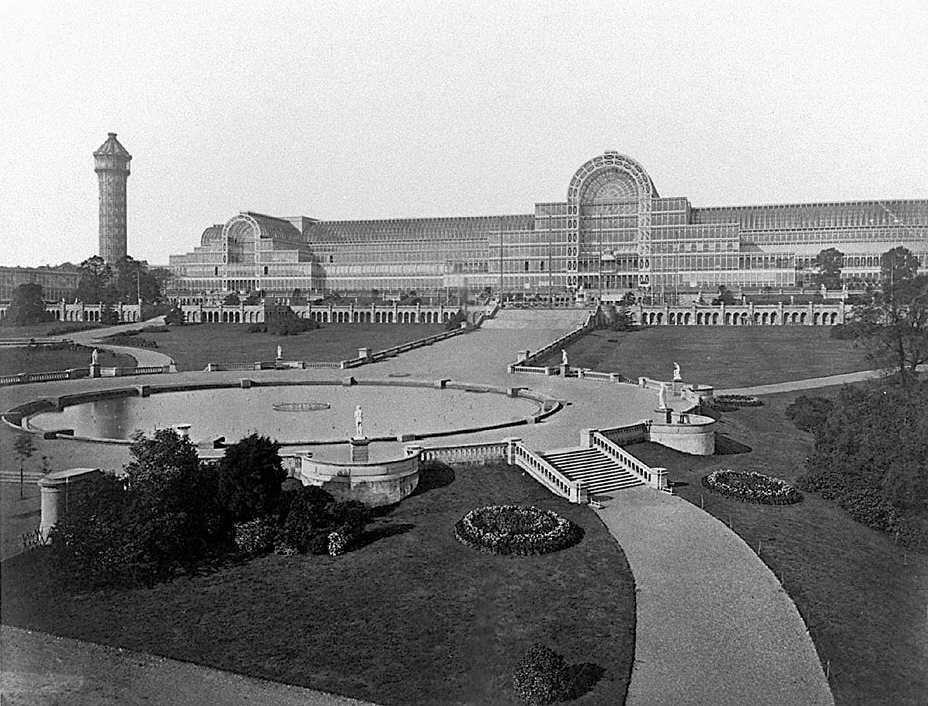
1854 - Eden Park; Related to possible sale and division of the estate? This plan splits the Eden Park Estate into four numbered sections. Plan reference 1954/2 is a larger scale of section No. 2 of this plan. There is a smaller scale map of the area in the corner of the page. Names of the neighbouring land owners are given as: Edward Richard Adams; John Cator; Ambrese Austin; John Blake; Herbert Wathen; P.R.Hoare Brid's [Exors]Sarah PooleS.C.WilsonJohn BaxterPeter Richard HoareIsabella HoareGeorge HankeyJohn MarshalEmmanuel Goodhart. (BHC) see 1866
1855 The Mid Kent Railway: The Mid Kent Railway was formed on 23 July 1855 to construct a 4.75-mile line between the South Eastern Railway (SER) at Lewisham and the Farnborough Extension of the West End of London and Crystal Palace Railway (WEL&CPR) at Beckenham, later renamed Beckenham Junction. The intention then was to extend this line to Croydon at a later date. The line opened 1 January 1857 and was operated by the SER under a ten-year agreement.
|
Title |
Deed |
|
Date |
30
August 1855 |
|
Description |
Lease
for 70yrs of messuages and land in Penge, Surrey (abuttals given); plan
-. |
|
Extent |
1
Item |
|
Format |
Maps
and Plans |
|
Access
Status |
Open |
Elmer
Lodge on the
1868 OS map, names truncated to Elm Lodge probably due to a mapping
error
Elmers
End, Elmer or
Elm Lodge on the 1809 Burrell estate map.
1809
Burrell lease to
G.W.Dickes
Tithe
map 1838
The
road layout
changes between all of these maps but the former lodge footprint is
similar in
1809 and 1838
1856 - Kelsey and Beckenham Manor House; Henry Merrick Hoare who had acquired Kelsey mansion in 1835 dies without a direct heir and Peter Richard Hoare, a nephew inherits. Henry's brother Peter Richard had occupied Kelsey as shown on the 1841 census. He died in 1850 and his wife Arabella took over as head of the household. Peter Richard junior is shown as resident of Kelsey in 1861 but recorded in Devon in 1871. Since the family had at least three residences including the banking house in Fleet Street then they were probably mobile. Peter Richard junior had been born in Monmouthshire.
1857
- John Clairmont Abrams is in
occupation at the Beckenham Place mansion. (Pat Manning source) from an
electoral roll.
1858
- John Barwell Cator dies at
Woodbastwick Hall, Norfolk and the estates are inherited by his son
Albermarle
(1813-1868). Albermarle will eventually be succeeded by his 2nd son
also named
Albemarle. Pat Manning records that J.B.Cator and his wife lived in
Germany for
some time to save money. Though he had great wealth the restrictions on
disposing
of the net worth of the estate seem to have caught up with him and
there are
several opinions that he was extravagant. His effects are valued at
under
£35,000 but this may be just personal assets apart from
estates left in
trust.
It requires deeper investigation.
1858
- South
Eastern
Railway: Service between London, Bromley and
Southboro' Road. Refers also to Sunday train restrictions imposed by
Mr. Cator
of Beckenham. Which Mr Cator needs confirming but about this time John
Barwell
Cator is succeeded by his son Albemarle Cator.
1861 - Robert Henry Page a Merchant and Russia Brokerand family reside in the Beckenham Place mansion (source U.K.census) but the 1868 report on the estate shows that a lease has been granted to Sir John Kirkland from 1860 until 1881. Kirkland had other property at Blackfen, Sidcup. See 1871
1861 - The Census; information gleaned from the census returns; The public houses, George, Coach and Horses, Three Tuns and Bricklayers Arms are recorded and the Rising Sun at Elmers End (became William IV?). Occupants of Rockhills, Joseph Paxton, (additions to be listed)Kelsey Park; Isabella Hoare, Landed Proprietor and Head. Peter Hoare, son, Magistrate and Banker.
Langley
Park ; Colvile. Langley Lodge; Charles Goodhart.
1862 Mid Kent Railway Addiscombe Line.Although the company later abandoned its intention of building a line to Croydon, an extension to "Croydon (Addiscombe Road)" from New Beckenham through Elmers End was completed in 1862 which was also leased to the SER on completion. This extension led to the re-siting of New Beckenham Station which found itself on a junction or loop line.
1862
– The birth of John Cator
(1862-1944), son of Albemarle Cator II (the younger) who will inherit
the Cator
estates in 1906. He will subsequently be responsible for selling off
the
Beckenham estates and dividing other property between family members
who are
trustees. Possibly as part of the dissemination of large family estates
that
took place post World War 1.
1863-73
– Copers Cope Farm leased to T.(Thomas?)
Covell by the Cator Estate and as Covell also has the lease on Kent
House Farm
it looks like he may be farming Kent House and Copers Cope Farm
together
because in the 1871 Census “Coper Cope House” is
occupied by William
Edwards
who is an Accountant and Liquidator.
1864
– Cator Estate; November, a map of
the Beckenham Estate of Albemarle Cator is printed. The original may be
lost
but it exists in at least two copies. It excludes the site of Old Manor
House
opposite the church as that is part of the Burrell estate since 1759.
One copy
annotated ‘updated to 1889’ is in Bromley Historic
Collections.
Recently (2022)
another copy of the map has been brought to our attention by Richard
Mason. The
‘Mason’ copy is more like the original than the BHC
copy, not coloured
although
annotated that certain areas shoudlcoloured to show leases. But this
copy is
dated 1864 without the ‘updated to 1889’ caption.
Hopefully some good
quality
images will be hosted on the BBLHS website.
Some
closer studies of the two versions
seem to show that some roads planned in 1864 have been installed by
1889. For
example Albemarle Road is just a dotted line on the 1864 but well
defined on
the 1889 and the Beckenham Place Park private road is not on the 1864
map but
drawn in on the 1889. Thayers Farm adjacent to Clockhouse had been
acquired and
is attached to Clockhouse with census records naming occupants. More
investigation is ongoing and the map adds to the story of the evolution
of the
Cator Estate, development of New Beckenham and surrounding areas. Both
maps
show a proposed road extending Westgate Road into Summerhouse Wood,
Beckenham
Place Park and illustrate the intention of the Cators to build on or
sell/lease
the land. A house called “Foxgrove” is already
built by 1864 on the
site of
what is today Foxgrove Avenue. Kings Hall Road is not drawn in but the
old
station approach went from Lennard Road to the original position of New
Beckenham Station. Beckenham Hill Road and Southend Road were called
Beckenham
Lane and Stumps Hill at this time. In the Copers Cope Road area another
planned
road which would have extended Lawn Road across what became sports
fields is
planned in 1864 but never laid down. However now that the sportsfields
are
coming under new ownership development is being allowed on a piecemeal
basis
even though a Metropolitan Open Land designation has been applied.
Several
other roads are drawn in but unnamed so presumably still in the
planning stage
and subject to amendment e.g. Copers Cope junction with Worsley Bridge
Road is
moved from the position indicated on the map.
The
legend stating ‘revised upto 1889’
indicating that this is an amended later publication along with the
indication
of colour coding of the 1864 map does imply that other versions do or
did exist.
The 1889 version is also recorded as being part of documents lodged
with a
commissioner for oaths in 1906. Bromley Historic Collections/Museum
also
records a framed map dated April 1893 with colouring or the purposes of
letting. All these maps are being investigated further.
1864
map courtesty Richard Mason
extract
of 1889 updated map
As
one copy of the map is annotated
"updated to 1889" and with the 1906 reference I list it there in the
timeline as well. (Bromley Library Historic Collections and Richard
Mason)
1864 - Albemarle Cator exchanges some land, probably Glebe land, unidentified 2 plots? Perhaps aided by the fact that the Cators held the advowson of the church and two Cators held position as Rector although not at this date. Church Warden Goodhart was landlord of Langley at this time.
| Reference: | MAF 11/78/2616 and 2617 |
|---|---|
| Description: |
Order of exchange of lands. Place: Beckenham, Kent. Parties: A(Albemarle) Cator and Rector and Churchwardens of Parish of Beckenham |
| Date: | 1864 Dec 16 |
| ef No | 989/4/2/2 |
| Acc No | 989 BOX 2 |
| Title | Office copy of order of exchange of lands |
| Description | Office copy of order of exchange of lands from the Inclosure Commissioners for England and Wales, who declare that property shall be exchanged between the Reverend Frederick Stene Courtenay Chalmers, Rector, Charles Emmanual Goodhart and Reginald Fowden (Churchwardens of Beckenham), and Albemarle Cator. Includes map showing the road from Beckenham to Penge, the clockhouse and 2 parcels of meadow land. |
| Date | 16/12/1864 |
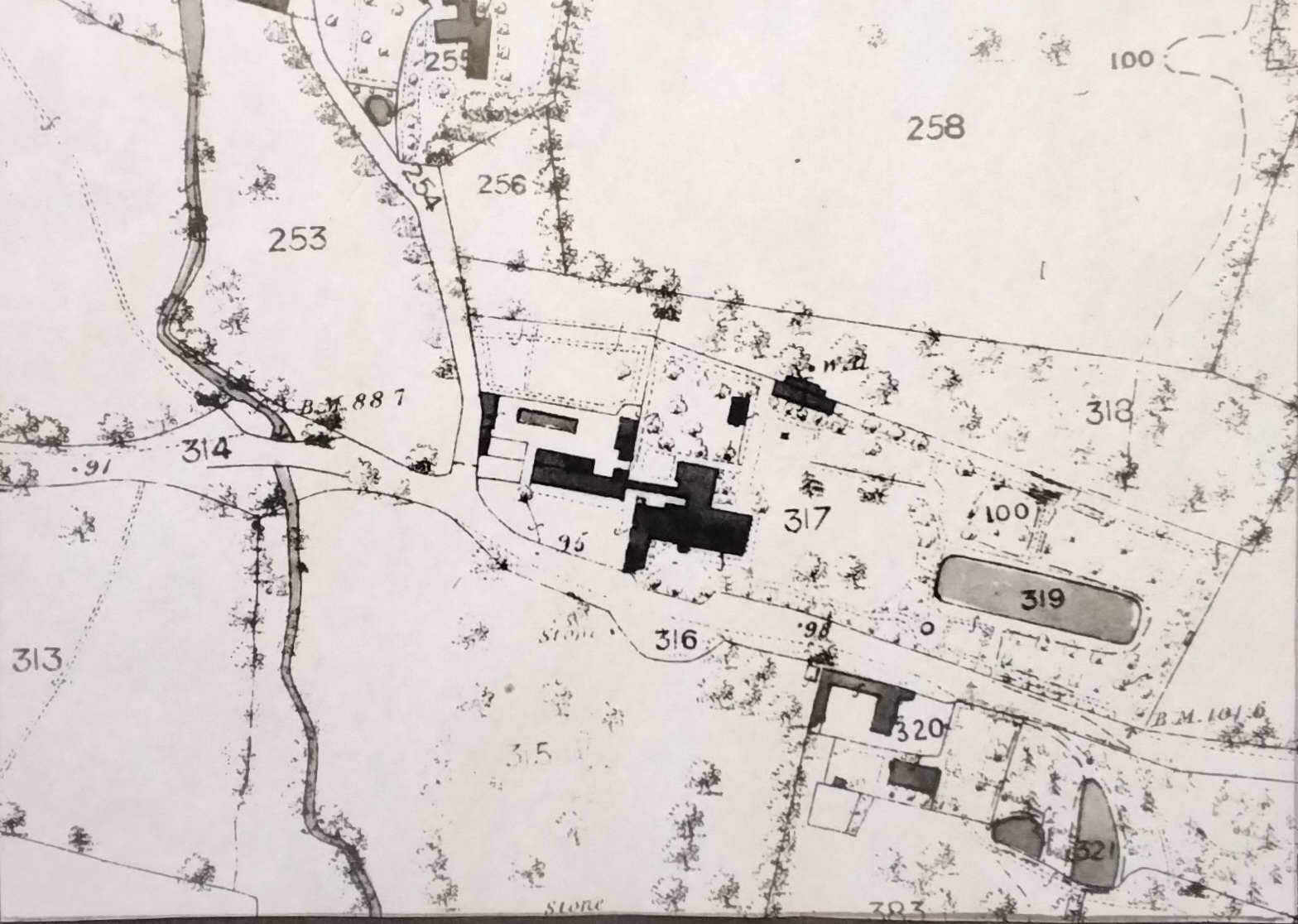
1865 - On
August 6th, 1865, the Parish Church, which had been closed in the
previous year
in order that the old-fashioned pews might be removed, was re-opened.
1865
- Charles Oliver Frederick Cator,
son of the Rev Thomas and Louisa Cator of Kirk Smeaton, came to live in
one of
the first villas to be built at Stumps Hill. He helped his Uncle Peter
Cator
with the Beckenham estates and was a keen student of meteorology
credited with
the invention of the leverage anemometer. Peter lived with his wife,
Martha and
younger daughter, Diana, at The Hall in Bromley Rd. He was one of the
founder
members of the Beckenham Cricket Club at Foxgrove Rd. and was in the
chair at a
dinner at the Three Tuns on 1.5.1866 in celebration. Their first match
was
between Marrieds and Singles on 19.5.1866. He was interested in the
seating
plan of St George’s church and in 1868 he presented the
church with a
new east
window. (source; Manning)
1866 - In the early part of the year the Beckenham Cricket Club was formed, the first secretary being A. C. Wathen, of Beckenham Lodge. The club had permission from Mr. Peter Hoare to use the private cricket ground at Kelsey for their first season, but shortly after the formation of the club the ground in Foxgrove Road was leased and play has continued there ever since. (Borrowman).
Peter Richard Hoare had inherited Kelsey from his uncle Henry Merrick Hoare who died without male issue in 1856.
1866 - The Beckenham Place Mansion occupier is still given as Robert Henry Page Esq. (source: a directory found be E.Inman)
1866 - Eden Farm; Plan related to sale and division of the estate? Plan is entitled "Plan of South Eden Park Estate in the Parish of Beckenham, County of Kent; Containing 105.0.34 of valuable freehold building land eminently suited to first class villa residences being richly furnished with ornamental timber etc.". The plan has the land in this area (which is a larger scale version of the southern area in plan reference 1954/1) split into lots labelled with the size of the plot (in acres, roods and perches). The plan also marks proposed roads. There is a smaller scale map of the area in the corner of the page. Surveyor: Joseph Fogerty. Names of the neighbouring land owners are also given: Emanuel Goodhart Lewes Loyd Junr. W.R.Mace Isabella Hoare John Marshall George Hankey.(BHC)
1867 - This press cutting from the Maidstone Journal and Kentish Advertiser of 22nd April 1867 describes several aspects of Beckenham at the time and some residents of the larger properties.
"BECKENHAMA
report on the condition of the
Beckenham estate is commissioned by the Cators and is archived in
Bromley
Historic Collections, it includes such detail as 5 brick fields,
building and
agricultural leases and describes Beckenham Place as ideal building
land but it
is on lease until 1881 which may partly contribute to its conservation
toward
becoming a public park much later on?
1868
– The Parish of Beckenham installs
boundary posts, some of which can be found across the park. See 1884
for
Lewisham boundary posts. (dates need confirmation).
1868
- Kenthouse Farm; Thomas Covell is
shown as occupant in a poll book. The Covells were in the
meat
trade.
Edwin Covell will occupy Beckenham Place for a time from 1885
and
have
butcher's shops in the area.
1868
- Stone Farm sale by Goodhart? The
farm had been leased to William Rogers Junior in the 1838 Tithe map. Stone Farm had also been
moved from its original base by the Burrells. Originally
the farmhouse was about half way along Wickham Road (see 1766 and the
Foxgrove
Manor map). The farm was acquired by Burrell from Cator in land
exchanges in
1793. The original farmstead buildings were absorbed into the Kelsey
parkland
and a new farm building called Home Farm erected, then renamed Stone
Farm probably
when the Burrell Gwydir estate was sold and Goodhart acquired the
freehold. The
fields of the farm were situated on the east side of Wickham Road.
|
Ref
No |
|
|
Title |
Sale
Particulars |
|
Date |
1
July 1868 |
|
Description |
Stone
Farm, Beckenham, a farm house situated opposite the Langley Park
Estate, land adjoining the farm house and the grounds of Eden Cottage,
Burrell Cottage and Chichester Lodge, Beckenham, Lower Pickhurst Green
Farm and Pickhurst Green Farm and Thrift Field, Hayes. |
1869 - Albemarle Cator exchanges some land; St.Mary Aldermanbury had held some land in the Shortlands area which had been bought with a legacy in 1627, probably leased to local landowners for rent income. (TNA)
| Reference: | MAF 11/78/3542 |
|---|---|
| Description: |
Order of exchange of lands. Place: Beckenham, Kent. Parties: Churchwardens and Overseers of St Mary, Aldermary, London and A Cator |
| Date: | 1869 Mar 27 |
Also, see this description of the endowment to St.Mary Aldermanbury.
1869/71
– The Beckenham Place mansion
occupier is Sir
John Kirkland,
Bart. J.P.
an army agent who had taken the lease on Beckenham Place in 1861.
Kirkland apparently was on good relations with Queen Victoria and
Prince Albert
and received gifts from them but he dies in January 1871 prior to the
census
and buried at St.George's with his wife Louisa who died in 1870. He is
associated with Blackfen and is referred to on a relevant website. A
press
advert gave an indication of Kirklands activities at Beckenham Place as
it
lists furniture, farm stock and produce to be sold after his death.
Kirkland
had died before his lease on Beckenham Place was due to expire in 1881.
The
1871 Census records his son also named John, a retired Major General in
the
army. A register of wills for 1871 shows that this latter John Kirkland
also
had to administer the probate of his sister’s death from
1869. It appears
Kirkland has either surrendered his
lease or sub let because in 1874 another tenant is listed at Beckenham
Place in
a local directory.
1870
- The first publication of the
Ordnance Survey maps shows very little built development around
Beckenham Place
park. Field
patterns from the Foxgrove and Beckenham manor plans may be detected.
The
Ordnance Survey maps of the 1860's and 1890's in the British Library
and
National Library of Scotland illustrate the mainly rural nature of the
estates
at Beckenham and Blackheath. An internet search for 'NLS Kent VII'
should
access the full map from which the extract below is taken. We might
assume that
John Barwell Cator made changes to the estate as the lake is of a quite
different outline to the 1799 Ordnance Survey drawing and comparing the
two
maps shows the difference in the footprint of the house ie with a
portico on
this map, without on the 1799 drawing.
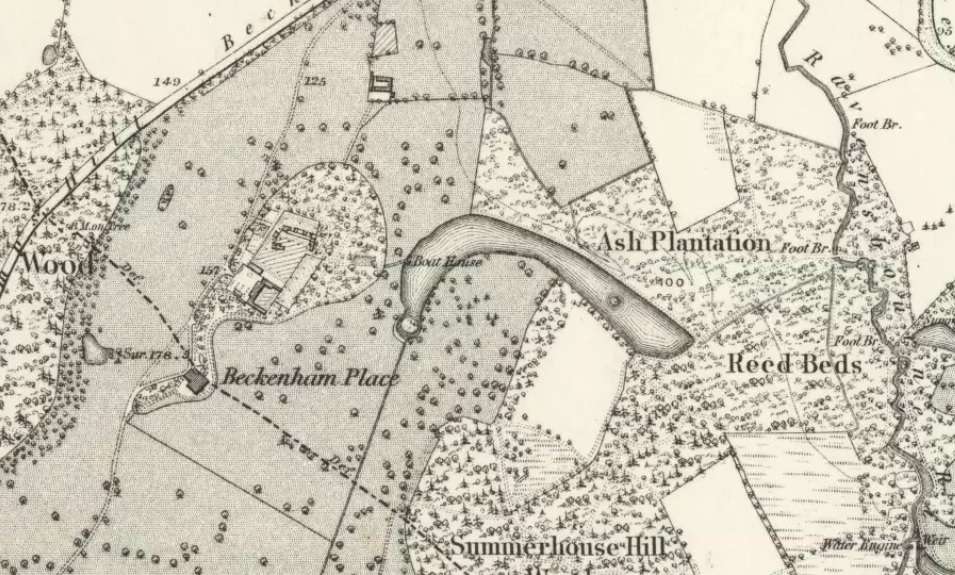
OS
map Kent Sheet VII – National
Library of Scotland (their website has access to many digitized maps)
1871
- John Kirkland the younger is the Beckenham Place mansion occupant
in the 1871 census with son, aunt and servants. Albemarle Cator and
family are
resident at Trewsbury House, Coates, Gloucestershire which they favour
over
Woodbastwick which is also leased to other occupants. The lease must
have been
vacated as a press advert puts the lease up for sale.
1871
- Beckenham Lodge (site of Barclays
Bank, near the War Memorial) was occupied by Edwin Covell age 35 with
his large
family. Thomas Covell, age 43 (perhaps Brother) occupies Kent House
Farm with
600 acres employing 20 men and 6 boys.(census record).
1871 – The Rectory; occupied by Frederick Chalmers, Rector of Beckenham (St.George’s).
1871 -
Elmer Lodge occupied by John Goddard, retired Actuary.
1873 - Peter Cator, youngest son of Joseph Cator, dies. He had lived at The Hall, Bromley Road, Beckenham and is credited with administering the Beckenham estates for some time. By the 1881 census The Hall is one of the Cator properties leased, in this case to Henry Phillipps a merchant who came from Padstow.
As Peter Cator had held a post in Madras this obituary was published but the writer has confused some 'Cator' family events. It was Peter's uncle John Cator of Beckenham Place who amassed the fortune and he didn't lend money to George III but did negotiate lending to Prince Regent and his two brothers but the loan wasn't finalised (see other timeline entries). Also the "Crown Land" mentioned was in fact the Beckenham Manor land belonging to Viscount Bolingbroke, Frederick St. John who sold it to John Cator but had already taken secured loans on the property thereby involving John Cator in lengthy court proceedings to straighten out the situation while St. John effectively avoided any liability for fraudulently taking money from Cator. This is in entries circa 1773 to 1780 in this timeline. It may not have been Peter Cator who objected to the railway running but his brother John Barwell Cator who was primary heir to the estates until his death in 1858 or John Barwell Cator's son Albemarle Cator who became next primary heir. There is great complexity regarding the Cator property involving several family members as trustees and the mention of 'a nephew' is believed to be the confusion that John Cator d.1806 did leave immense wealth to his nephew John Barwell Cator (Peter's brother). Perhaps the distance from Beckenham to Madras led to several confusions?
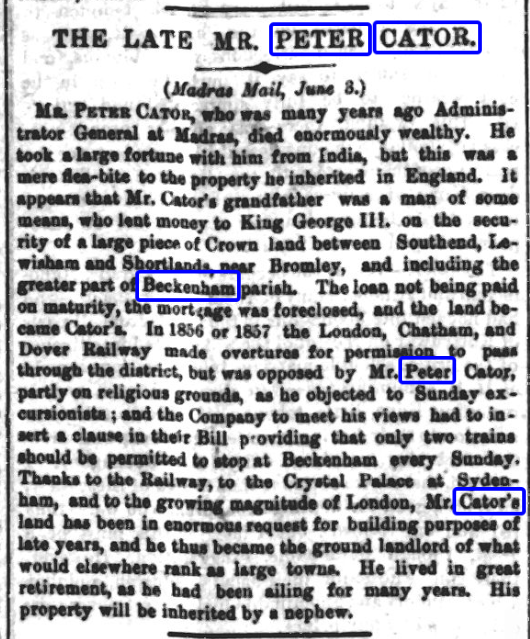
1873 - Return of Landowners 1873 Beckenham
| Return of Landowners 1873 Beckenham | A.R.P. | Value £.s.d. | |||
| Acres | Roods | Perches | |||
| Nickall Harry | 11 | 2 | 9 | £152.0.0 | |
| Marshall Mrs | 14 | 2 | 27 | £370.0.0 | |
| Harris Charles W | 14 | 3 | 21 | £295.0.0 | (Beckenham) |
| Cator Rev William | 16 | 38 | £180.0.0 | ||
| Austen Rev J F | 17 | 3 | 22 | £11.14.0 | |
| May Richard | 23 | 3 | 2 | £50.0.0 | |
| Sydney Stanley | 25 | 2 | 12 | £130.0.0 | (Beckenham) |
| Walthen Hulbert | 29 | 3 | 34 | £244.10.0 | |
| Brown Miss D | 34 | 2 | 3 | £3727.2.0 | |
| Ogle Ann exors | 35 | 1 | 31 | £590.0.0 | |
| Wilson Cornelius L | 37 | 20 | £2237.0.0 | ||
| Wilkinson Conrad | 59 | 20 | £1036.15.0 | ||
| Kirkland Sir J Exors | 142 | 1 | 37 | £275.0.0 | |
| Chumley Mr Ttee547.10s of | 143 | 2 | 38 | £1359.5.0 | |
| White F le Grix | 178 | 3 | 35 | £634.0.0 | (Beckenham) |
| Hoare Peter | 201 | 1 | 18 | £2301.15.0 | |
| Goodhart H Trustees of | 262 | 1 | 31 | £547.10.0 | |
| Mace William R | 274 | 3 | 21 | £1696.16.0 | (Beckenham) |
| Goodhart Charles E | 727 | 6 | £2057.10.0 | ||
| Cator Albermarle of Woodbastwick | 1085 | 2 | 0 | £28016.12.0 | |
| Cox Mr | 1 | 0 | £75.0.0 | ||
| Groves William | 1 | 0 | £120.0.0 | ||
| Whiteman Mrs | 1 | 1 | 0 | £605.0.0 | |
| Wilkinson Miss | 1 | 2 | 0 | £84.0.0 | |
| Carey Edward | 2 | 0 | £122.0.0 | ||
| Durage Inex | 2 | 0 | £135.0.0 | ||
| Luck Edward J | 2 | 0 | £173.0.0 | ||
| Cator Peter (exors of) | 2 | 2 | 33 | £135.0.0 | |
| Craik George H | 3 | 2 | 0 | £213.10.0 | |
| Harcourt Benjamin | 4 | 2 | 16 | £205.0.0 | (Beckenham) |
| Hooker & Rayner | 4 | 2 | 0 | £392.0.0 | |
| Austin J | 5 | 0 | £250.0.0 | ||
| Tapp A M | 5 | 0 | £220.0.0 | ||
| Girdwood Alexander | 6 | 0 | £145.0.0 | ||
| Parish of Beckenham | 8 | 33 | £165.5.0 | ||
| 3373 | 45 | 507 | |||
| 3387.42 | 14.41875 | 12.675 |
1874‑6
Joseph Fell Christie, occupant
of Beckenham Place is listed in the 1875 Bromley Directory.
1875
– This record relates to at least
some of the disposal of the southern part of Beckenham Place Park,
being on the
north side of Foxgrove Road:
Bromley
Library archive: Agreement
between Albemarle Cator of Woodbastock (Woodbastwick) Hall, Norfolk,
esquire
(1st part) and William Henry Maltby of Beckenham, Kent, builder (2nd
part) in
relation to 2 pieces of ground on the north and south sides of Foxgrove
Road,
Beckenham. Cator agrees to let the property to Maltby for 90 years at
the annual
rent of £10 per year for the first year and £40
thereafter. Maltby is
to build
a dwelling House. Includes a map of the premises and draft form of
lease.
A
large house in a large site was built called
‘Foxgrove’, not to be confused with Foxgrove Farm.
Foxgrove Avenue is
now on
the site but that house is on the 1864 Cator estate map indicating that
Maltby’s site is on parts of Foxgrove Road.
1876
- Charles
Oliver Frederick Cator,1837-
1876 Inventor of the Leverage Anemometer. Author of various papers on
meteorology. Son of the late Lady Louisa Cator and
Rev.
Thomas Cator. Succeeded to the entire management of
the Cator Estate in 1873, when his uncle,
Peter Cator died.
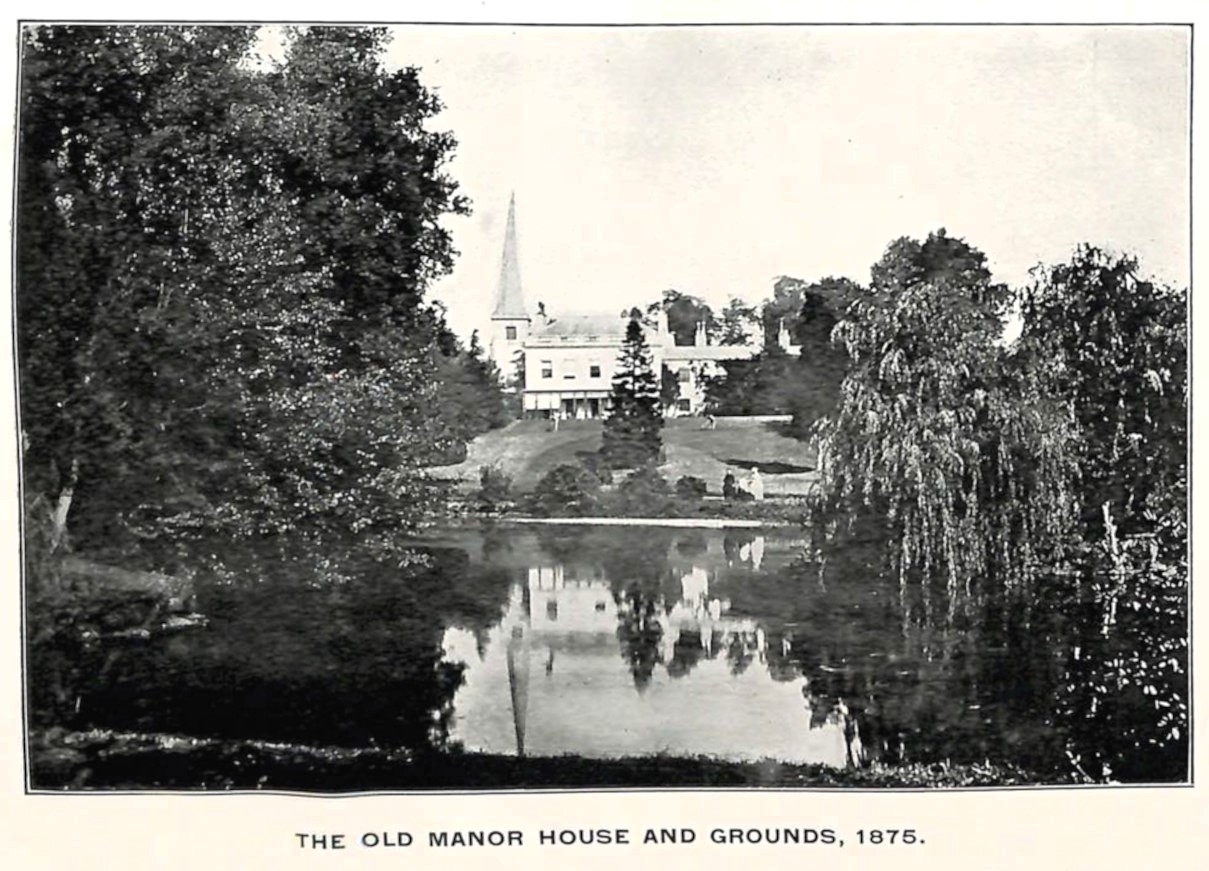
1876 - On December 10th, 1876, Charles C. F. Cator died after a short illness, much regretted by all classes throughout the parish. He was the son of the late Lady Louisa and the Rev. Thomas Cator, Rector of Kirk Smeaton, in Yorkshire. In the early part of the year 1865, he came to reside at Beckenham, and assisted his uncle, the late Peter Cator, in the management of the Cator estates. His principal study was meteorology, and he was the inventor of the leverage anemometer. He resided in one of the first villas erected at the summit of Stump’s Hill.
1877‑8 No one is listed as in occupation of the Beckenham Place mansion as Sir John Kirkland had died before his lease expires in 1881 and his son has surrendered the lease.
1878 - The Village Flood; A flood of the Beck inundates parts of the High Street around what is now Thornton's Corner. It would have stretched from Kelsey Park downstream toward The Drive but been confined by the rise up the High Street toward the George Inn, by the hill up to the church and the hill at Court Downs Road. Later floods are recorded and no doubt there had been more floods in the past but the less dense built up area probably avoided too much building on the flood plain of the river. For example The Manor House was on the hill by the Church as was the Rectory, Other buildings were on the higher ground up the High Street including the George, the Three Tuns, Village Place etc.
Borrowman wrote in 1910; "On April nth, 1878, as we have stated elsewhere, the piece of water in the old Manor House grounds overflowed in consequence of the great floods, and aoout 120 feet of the w'all at the bottom of Church Hill gave way, and the lower part of the village was flooded. In consequence of the same inundation the traffic on the Mid-Kent Railway was stopped, and the bridge over the road at Southend was broken down."
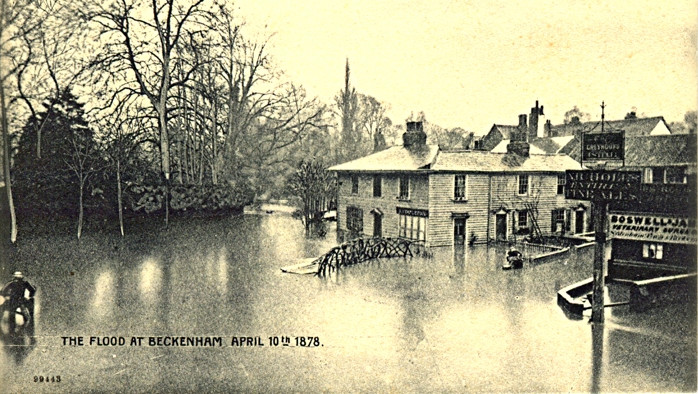
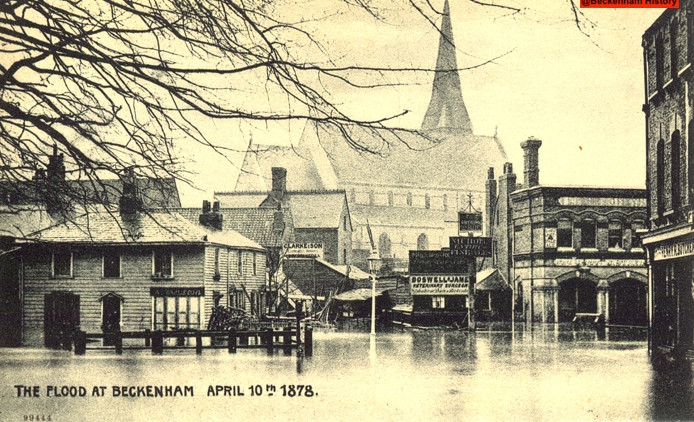
This section of a map from circa 1870 shows the lake in the old Manor House grounds and how the Beck crossed the road junction before the river was conduited from Kelsey Park through to The Drive. The Manor House lake was filled in for property development
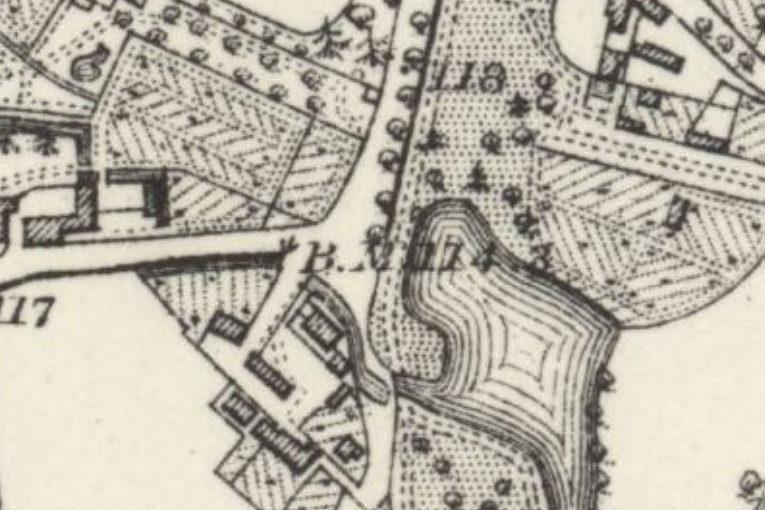
Map
published 1870-74 but not necessarily keeping up with the pace of
development in the village.
1878 - Church Buillding; "The year 1878 showed great activity in Church building in Beckenham. On June nth, the foundation stone of the permanent Church of St. Barnabas was laid by the Right Hon. Earl Nelson, and on the 22nd of the same month, Holy Trinity Church in the Lennard Road was consecrated by the Bishop of Dover. This Church was built from designs of Messrs. Daukes, by Francis Peek, in memory of his parents, and the ground was given by the late Albemarle Cator, the Lord of the Manor. The building is capable of accommodating between 800 and 1,000 people." (Borrowman 1910)
1878
– Foxgrove Farm demolished
(source: RHCopeland)
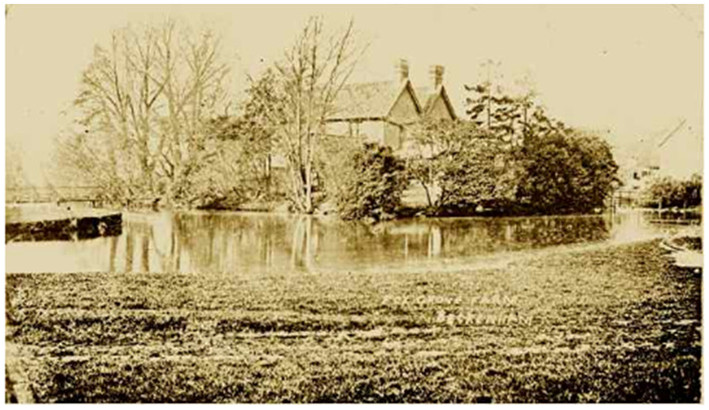
Foxgrove Farm shortly before demolition
1879
- Spencer Brunton and his family
are in occupation of the mansion. The Brunton children made a story
book
Christmas card depicting a royal family visit, maybe this harks back to
the
Kirkland residency or is just children’s imagination. This
page from
the book
depicts a move into the mansion. But by 1881 they are in the census as
living
at Brook Street, London with their 6 children and a string of about 10
servants
including a butler and two footmen. Spencer was a member of the London
Stock
Exchange but by 1891 his wife had filed for divorce. An earlier 1871
census
shows they had lived in Copers Cope Road at a house called The Ferns
with a
daughter and only 3 servants. The six children were born in quick
succession.
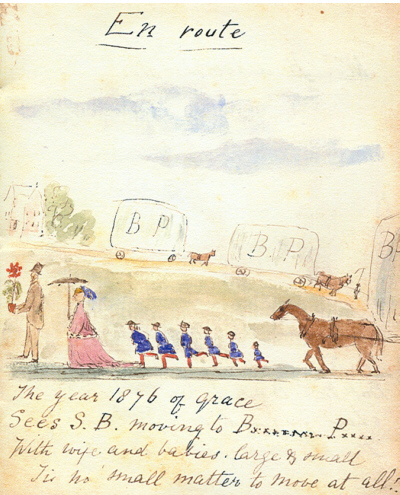
1881
- The mansion is occupied by Owen Henley aged 32 and family, a
gardener - so we might assume he is acting as gardener/caretaker.
Unless of
course the official tenant is just absent and recorded at another
address?
In the census for this year Albemarle Cator is recorded as being at
Trewsbury
House, Coates, Cirencester with his wife, 12 children and a string of
servants.
Spencer Brunton had moved to Brook Street, Westminster. We find Owen
Henley
previously listed in 1871 aged 22 unmarried living in St.
George’s
Villas,
Beckenham as a domestic gardener,
But
1881 is also the year for this
event in June:
This
article was discovered by one of
our ‘eagle–eyed Friends’ in the Local
Studies library in Bromley. It is
from
The Beckenham Journal. JUNE 1881.
BAZAAR
AT BECKENHAM PLACE.
On
Saturday and Monday last, the 25th
and 27th June (1881), a grand bazaar was held in Beckenham Place, which
was
kindly lent for the purpose by Albemarle Cator Esq., the object being
to aid in
defraying the debt remaining on the Building Fund of St James' Church,
School,
and Working Men's Club, Elmer's End. The idea of the bazaar had been
originated
and carried into effect by a number of ladies desirous of assisting the
church,
whose efforts had been made quite apart from those of the Building
Committee.
They had secured influential patronage, H.R.H. Princess Mary Adelaide,
Duchess
of Teck, who had kindly promised to honour the bazaar with her
presence, and to
perform the opening ceremony, and of Viscount Lewisham, M.P., and Lady
Lewisham, Major-General Lord Chelmsford, G C B and Lady Chelmsford,
Right Hon.
Lord Forbes, Hon. Lady Inglis, Hon. Mary Thesiger, Sir Charles Mills,
Sir
Edward Scott, Bart and Lady Scott, Co1. Sir John Farnaby Lennard,
Bart., and
Lady Lennard, Lady Cave, Lewis Loyd, Esq., and Mrs. Loyd, Mrs. George
Lillie
Craik, and Albemarle Cator, Esq. Great anxiety had been manifested to
make the
bazaar a success, the ladies who consented to take stalls,
pledging
themselves
to provide stock to the value of at least £100, a
sum which was
unquestionably
for exceeded in nearly every case. Consequently there was no lack for
those who
came, to use the words of Marzials' popular song, "With their pockets
full
o' money," to exercise their liberality in a good cause.
At
Beckenham Place excellent
arrangements had been made for accommodating the large number of
visitors
expected, and all that was necessary to render the occasion completely
successful was fine weather. Unhappily Saturday proved unpropitious in
this
respect for rain fell during the greater part of the morning, at times
very
heavily, so that by two o'clock, the hour fixed for opening the
grounds, every place
was thoroughly wet. This misfortune necessitated the alterations of
some of the
arrangements by rendering any proceeding in the open air impossible.
Thanks,
however, to the care of those who had the arrangements in hand, no
inconvenience was felt beyond that occasioned by the crowding of the
rooms.
Shortly
after three o'clock, Princess
Mary arrived, accompanied by her daughter, Princess May, and her little
son,
Prince Randolph, and attended by the Honorable Mary Thesiger. The
Princess was
received at the entrance of the fine old mansion by the Rev. A. Barber,
Incumbent
of St. James', Lady Inglis, Lord Chelmsford, G.C.B., Albemarle
Cator,
Esq.,
Mrs. A. Cator, and Rev. W. Cator. Having declared the bazaar open, the
Princess
proceeded to inspect the stalls. In the apartment on the left of the
entrance
hall were three stalls, the first held by Lady Inglis, the Misses
Inglis, and
Miss Buckworth; the second by Mrs. Barber, Mrs. PascalI,
Mrs.Strickland, and
Miss Isaacson; and the third by Mrs. Wallace and family, assisted by
Mrs.
Phillips. Each of these stalls was well stocked with the
thousand-and-one
articles always provided for such occasions, Lady Inglis’
being
arranged as
effectively, perhaps, as ,any in the bazaar. Mrs. Barber's stall, the
goods on
which were valued at upwards of £250, contained a number of
contributions from
working men and women, who had devoted their spare time of
some months
past to
their production. A room on the other side of the building contained
stalls
kept by Mrs. and Miss Kirby, and by Mrs. W. C. Jones, Mrs. Green, and
Miss
Smart. The latter stall was stocked to a large extent with fancy
stationery and
kindred articles, amongst them being some beautiful views taken by
instantaneous
photography. There was also a collection of New Zealand native spears
and other
arms, which soon secured purchasers. A spacious apartment, arranged in
a most
enticing manner, was devoted to refreshments, which were dispensed by a
number
of ladies under the direction of Mrs. Cameron and Mrs. Bicknell.
Further
provision in the way of creature comforts was made by Mr. Cameron, who
had
furnished a first-rate cold collation. The most attractive stall, at
any rate
in appearance, was that for flowers and fruit, which occupied a room by
itself,
presided over by Mrs. Radcliffe, Mrs. Blundell, Mrs. Newcombe, Miss
Burleigh,
and Miss Jones. These ladies had furnished themselves with a stock of
choice
flowers and fruit, which they had arranged so artistically that it was
not at
all surprising to find that the Duchess of Teck spent some little time
there -
indeed there was no department more worthy of a visit than this.
Upstairs, Dr.
Phillips had a number of microscopes, with some most interesting and
instructive slides, on view; while Mr. Bloken was in charge of a Fine
Art
Collection, which preferred no claim to be considered "aesthetical."
Another item calling for notice is that sketches of the new church of
St.
James, which has been designed by Mr. .A. R. Stenning and will be a
very
handsome structure, were on view.
Her
Royal Highness, having completed
her tour of the stalls and made several purchases, proceeded to a
concert room,
where some of the pupils of the Royal Normal College and Academy of
Music for
the Blind, Upper Norwood, were about to give selection of music. Mr. F.
J.
Campbell, the Principal, having been introduced to the Princess, who
referred
to the affection entertained for him by his late pupil, Prince
Alexander of
Hesse, the following pieces were performed, by Her Royal Highness'
request
:-Humerous glee, "Humpty Dumpty sat on a wall" (Caldicott); song,
"Die beiden Grandieri" (Schumann), Mr J. Prydie; trio," O
Memory" (Leslie), Miss A. Campbell, Miss A. Carson, and Mr A. Hughes;
piano solo, " Silver Spring," by W. Mason, a lad aged 14; and the
humorous glee, "Little Jack Horner" (Caldicott.) All these pieces
were performed with that skill and effect for which the
members of the
College
are justly renowned, and they secured the hearty applause of the
Duchess.
Her
Royal Highness left soon
afterwards, to the strains of the "National Anthem."
During
the afternoon a very large
number of persons visited the bazaar. A brisk trade was carried on at
the
different stalls, and there were several canvasers for subscriptions
towards
articles to be drawn for. A second selection of music was given by the
Blind
College, and the Band of the Royal Artillery, which was present under
the
conductorship of the Band Master, Mr. Albert Mansfield, also
provided
some
most enjoyable music.
In
the evening a Promenade Concert was
given under the direction of Mr F. T. Newcombe at which the following
ladies
and gentleman took part:-Mrs. PascalI, Mrs. Newcombe, Mrs. Radcliffe,
Misses
Brown, Miss Wigan, (an exceedingly good performer), Miss
Burleigh, Mr.
M.
Beaumont, Mr. Sternhardt, Mr. Weber, Mr. A. H. Neuffert.
On
Monday there was a very large
attendance. The proceedings were enlivened by the band of the Duke of
York's
School. The total receipts of the two days amounts to over
£750, which
sum,
after paying all expenses, provides the Ladies Committee sufficient to
pay off
the debt on the building fund, and a balance of £50 for other
purposes.
1880
- This passage was taken from The
Beckenham Journal and Penge and Sydenham Advertiser, JUNE 1880. Copies
of these
journals are in the Local Studies library in the Central Library in
Bromley.
The
area referred to is not clear, the
Friends would be please to hear ideas on the location mentioned.
Perhaps Cator
Park, Kings Hall Road?
‘NOTES
BY THE WAY’.
We
have mentioned that a proposal has been
made on behalf of Mr. Albermarle Cator to let on lease 42 acres of land
for 99
years to the Local Board, to be appropriated as a recreation ground.
The exact
terms and covenants are not stated, but we believe they are liberal.
The Board
have applied for a statement of the conditions, and are favourably
disposed to
its consideration. The main difficulty is that which meets the Board at
every
point-that however moderate the terms, there will be some cost
incurred, and
with the many claims upon the rates for the execution of absolutely
necessary
works, there is much hesitation in entering upon others, however
desirable,
that will lay the slightest burden on the ratepayers. The ways and
means are
always approached with caution, and discussed with anxious care. It
will always
be the case that in a scattered district the expenses will be heavy and
appear
out of proportion when compared with compact and covered districts. We
observe
that about one-fifth of the amount collected is spent upon lighting and
upon watering
and repairing the roads, and these items of expense would not be
greatly
increased if the houses were much more numerous. The rating value of
the
neighbourhood in such case would be increased, and the expenses would
appear
lighter. We feel bound to say so much, when such a proposal is before
the Local
Board; but, at the same time, we should deeply regret if such a
favourable
opportunity of obtaining a recreation ground of' suitable
extent and
in
perpetuity is lost. The opportunity may never occur again, if allowed
to pass
away. We are aware another pressing matter is before the Board; that of
obtaining a burial ground. We think that the leading ratepayers ought
to
assist, and there is one way of doing so that at once occurs to us. If
the
Cricket Club would unite in any way, the case might be met. No doubt
the money
required for laying out the grounds for such a purpose might be
borrowed upon a
long term, so that it really would be little more than the interest
that would
fall upon the ratepayers. We trust that the proposal of Mr Cator will
not only
be a liberal, but a generous one, and that the Board will be
strengthened by
the public approval to enter upon the undertaking.
1882
– A lease on a site called Hawthorndeans abutting Southend
Road for
90 years, presumed to have been made freehold at a later date. A large
house on
a sizeable plot.
1883
– About this time a Beckenham
directory records that the installation of the West Kent sewer caused
the
drying up of the moat around Foxgrove Farm. This area supplied the
water for
Beckenham Place’s lake so I’m concluding it was
this that was the main
cause of
the lake subsequently drying up.
1884?
– The Boundary posts are
installed between Beckenham and Lewisham parishes. Robert Borrowman's
book from
1910 records the ceremony of Beating the Bounds from parish records,
but that
the parish boundaries had become lost or forgotten so a sum of money
was made
available and cast iron boundary posts installed to mark the parish
boundaries.
Several of these posts are in Beckenham Place Park marked 'Beckenham'
along
with some marked 'Lewisham'. The parish, or now Borough, boundary has
since
been moved. Some posts are near old oak trees which for many years or
even
centuries were used as boundary markers. Some old maps record 'boundary
mark on
tree'. One interesting speculation or story is that the Beckenham
parish
boundary is strangely shaped as a body was found near Crystal Palace
but no
parish claimed it for burial apart from Beckenham so the boundary was
drawn to
where the body was discovered. Now boundaries are more 'political' and
determined by the Boundaries Commission.
One
curiosity is perhaps that Foxgrove
Manor seems to have been partly in Beckenham Parish and a small part in
Lewisham Parish as well as Bromley Parish. As Borrowman records that
the Parish
boundaries were forgotten perhaps the ancient parish boundary was more
to the
north than it was fixed in 1884. The Cator estate plan revised to 1889
shows a
disputed boundary near the mansion. It would be interesting to see if
these
historic markers survive the park remodelling.
1885 - A Beckenham directory published by Thornton’s contains a brief history and informative data. Despite much of the information being presumably correct and quoted from sources I use in this account, some information is mixed up.
For
example in the passage below
Beckenham Place was not the home of Piercy Brett, he lived at
Clockhouse. And
as I state in this history, Beckenham Place was in Foxgrove Manor and
not in
the 1773 Beckenham Manor property. Kent House was not an ancient seat
of the Lethieulliers as they only possessed for about three generations
and were probably absentee landlords for some of this time. This
directory describes the water
for the
moat of Foxgrove being lost when the West Kent main sewer was
installed.
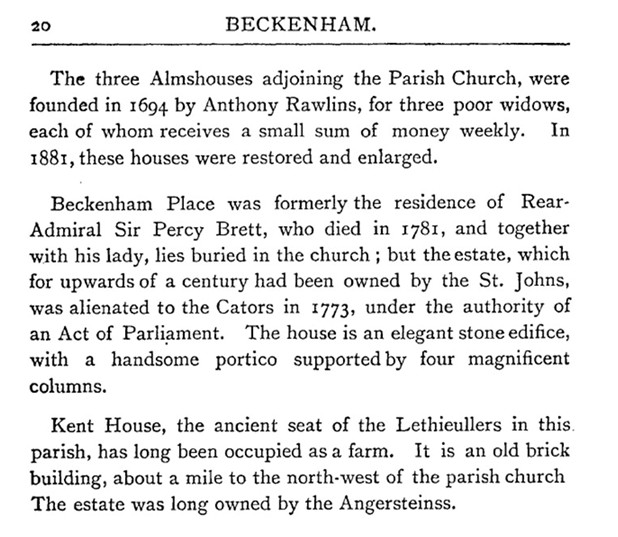
1885‑93
Edwin Covell lives in
theBeckenham Place mansion, a butcher’s proprietor/meat
salesman. An
1885
directory has an advertisement for his business and the 1887 Beckenham
Directory
shows him as at Beckenham Place. The Bromley Record reports his death
in May
1893 and his obituary states “he was the largest importer of
foreign
cattle,
farmed extensive land in and around Beckenham” Another Covell
family
occupies
Kent House Farm as farmers presumably also as leaseholders. The Covells
are
recorded on the 1891 census along with several servants. Study of the
census
records reveals the number of people ‘in service’
and ‘living in’ in
the large
villas of the viscinity.
1885
- Killed, along with five others,
including another family member, James Fisher, when a boiler exploded
at Mid
Kent Brickworks, Worsley Bridge Road, Beckenham.
Inquest Bromley Record March 1885, Mid Kent Brickwork Cottages,
Beckenham
1889
– We should revisit the 1864 Cator
Estate Plan annotated as ‘revised up to 1889’ as
the plan shows areas
leased in
several cases to developers. Although this is the plan which shows an
intention
to have a road through Summerhouse Wood the plan predates the coming of
the
railway, its route is not even indicated on the plan but the map might
be the
basis for planning the railway which is authorized by an Act of
Parliament in
1889. The recent discovery (2022) of another Cator Estate map dated
1864
provided byRichard Mason can be compared to the 1889 amended map. Some
roads
planned in 1864 are installed but with amended routes in some cases ie
Copers
Cope Road junction with Worsley Bridge Road is moved.
Looking at the areas outside Beckenham Place Park on the map it shows that very little development has taken place in Beckenham, Lewisham and Bromley. The OS map shows development near to Beckenham village, mainly large Victorian villas. The census returns for the period illustrate large households often with servants occupying coach houses, some houses used as schools, and often accommodating what is referred to as ‘professionals’. Of course there are some artisan housing areas of terraced property near the village centre. The records of the estates of the Wythes and Hoare families illustrate the nature of property leasing and development. Again searching online catalogues of Bromley Historic Collections is informative.
Comparing
the estate map with the nearest OS map it appears that a lot of house
building has not been recorded on the estate map other than shown as
leased to developers. Hence comparison with the OS 25 inch map is
recommended.
The
legend of this map states that land
coloured pink is on long lease to leaseholders and that roads made and
now
being made coloured brown whereas intended roads are outlined. The
landlord
reserves the right to alter omit or substitute other roads. What is now
The
Avenue is called Mote Road (after the moated Foxgrove Farm/Manor).
Leased
property can be seen in the southern corner of what was the original
park. This
is perhaps the cusp upon which the existence of the current public park
is
turned. Copers Cope Road, Brackley, Worsley Bridge, Park Road seem to
bear the
brunt of development over the next years. The small area next to the
Beckenham
Place mansion is shown as disputed parish boundary.
Estate
Plan updated
to 1889 – Courtesy of Bromley Historic Collections
Regretably
so far no key to the field
numbering has been found.
1889
- An Act of Parliament authorises
building of the Nunhead to Shortlands railway which runs via Beckenham
Hill
station to Ravensbourne station across the park. It states that
Albermarle
Cator is to be compensated for lands purchased etc. Negotiations began
as early
as 1884. The Cators had obtained parliamentary approval to develop
their
Beckenham estates for housing in the 1825 Act and the 1865 estate plans
show an
intended road slicing right through Summerhouse Hill Wood, a proposal
which
fortunately never materialised. In 1879 discussions took place between
the
Cators, neighbouring landowners and the London, Chatham and Dover
Railway
concerning a proposal to build a railway along the Ravensbourne valley
in order
to encourage speculative builders to construct houses in the area. This
came to
nought, as did a bill brought before Parliament in 1884. However in
March 1889,
an agreement was signed between Albemarle Cator of Woodbastwick Hall,
Norfolk,
Sir John Farnaby of Wickham Court and representatives of the London,
Chatham
& Dover Railway, which paved the way later the same year for
the
passing of
an Act authorising the construction of the Shortlands and Nunhead
Railway.The
landowners contributed land as well as finance whilst the L.C.D.R.
guaranteed
to operate the line once it was constructed. Records in Bromley Library
note
the Forsters and a Mr Redman as being promoters of the bill to
authorise the
railway with compensations and land purchases from Albemarle Cator
(jnr.).
05/07/1889
Agreement between Alfred
George Renshaw, of The Hall, Southend, Kent, esquire and William
Stewart
Forster, of 28 Lincolns Inn Fields, esquire, promoters of the Bill
relating to
the Incorporation of the Shortlands and Nunhead Railway Company (1st
part) and
Albemarle Cator, of Woodbastwick Hall, Norfolk, esquire (2nd part). It
is
agreed between the parties that if the Bill is passed in to law to
authorise
the construction of the railway, then the Company erect stations at
Ravensbourne and Beckenham Hill and will pay compensation to Cator.
Cator will
sell property to the Company as required. (source: Bromley local
studies)
The
attraction for the railway company
was that it offered an alternative route to that through the Penge
tunnel, an
important role it provides to this day. Maximum charges per mile were
set at
3d, 2d & 1d for first, second and third class passengers, 4d
for
horses, 1d
for cats and dogs and 5d or 4d for carts and carriages depending on
whether
they had two or four wheels. Five stations were to be provided on sites
selected by the landowners, each well staffed and provided with all
comforts
for both lady and gentleman passengers despite the fact that when they
first
opened they were surrounded by fields with hardly a dwelling within
sight! As
the landowners provided the lions share of the resources the precise
route of
the line was dictated by them, not by the operational needs of the
railway
company. The result is that the line winds its way along the valley
carefully
avoiding major features, such as the former lake in Beckenham Place
Park as can
be seen from the sketch plan which shows the original field boundaries.
The
railway company was very happy with
their new route, which cost £265,000 and opened for business
on 1st
July 1892.
Under a new Act passed in 1896, they assumed complete control of the
Shortlands
& Nunhead Co exactly five years after it opened. Ravensbourne
Avenue, Crab
Hill, Downs Hill and Farnaby Road owe their existence to the building
of the
line, as does the gully, which forms the present entrance to the park
from Crab
Hill. This was said to be the source of much of the gravel used in the
construction. Many of the trees, which still shield the line, are the
successors of those originally planted to screen it from the expected
housing
development. This house building never took place, but evidence of the
Cators'
expectations can still be seen today.
The
width of the bridge, now connecting
nothing but two parts of the park, suggests that it was originally
designed to
take considerable traffic. It contrasts markedly with the two earlier
ones
nearby in Westgate and Downs Bridge Roads, which are much narrower as
they were
probably intended solely to provide farm access. Despite several
changes of
ownership the railway service through the park continues substantially
unchanged. Ravensbourne station lost its goods yard in the 1960s and in
1986
the booking office was badly damaged by fire. It has been rebuilt in a
sympathetic style and the remains of the porter’s
accommodation can
still be
seen in its basement by peering through a gap in the wall. Beckenham
Hill
station is basically unchanged apart from the loss of the down side
canopy
which was removed in 1968. We believe there was also a goods depot at
one time.
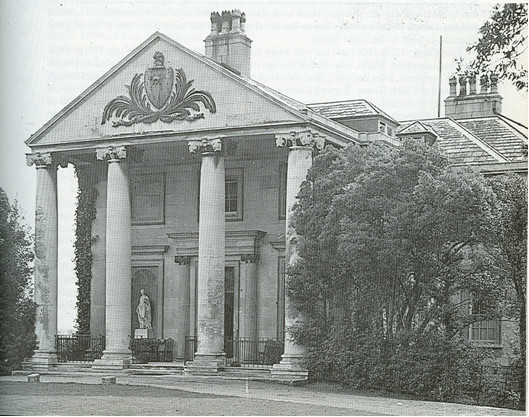
Beckenham
Place circa
1892 – if accurately dated this photo shows the roof dormers
installed
prior to
the house being used as a school or sanatorium.

An earlier undated photo shows a roof without dormer windows, note the
shrubs
and ivy on the south wall
1891
– Eden Park (Farm); The Norwood News report shows that Eden
Park
had
been
left vacant for 17 years and subjected to vandalism. OS maps
show
that the main building has been demolished shortly afterwards and only
the outbuildings/farmstead remain. The house that John
Woolley
had built in 1820 had become a white elephant in that short
time.
1894 - The Beckenham Place mansion occupier is listed as Mrs Covell, her husband Edwin has recently died in May 1893. E. Covell is also recorded as the tenant in the documents concerned with the authorisation of the construction of the Shortlands Nunhead railway through the estate. See also 1885
1894 OS map https://maps.nls.uk/geo/explore/#zoom=16&lat=51.3990&lon=-0.0231&layers=6&b=11895‑99 No one listed as in occupation of Beckenham Place.
1897 - On Sunday
afternoon, June 6th, 1897, a terrific thunder-storm
visited
Beckenham, accompanied by torrential rain, the basements of several
houses were
flooded and the roads in places rendered impassable. (Borrowman)
1900 to 2000 (Beckenham Place unless otherwise stated)
The population of Beckenham is steadily increasing along with built development but it is still a relatively green suburb before increased building phases during the 1920's and 30's. The census/censi of 1901 and 1911 show more detail and the number of people in service is substantial. The 1921 census recently released is unfortunately no as 'open source' as earlier ones as the distribution is monopolized via a genealogy website.
Of course the advent of two world wars will have a physical impact on Beckenham whereas earlier conflicts were substantially away from home since the Civil War of the 17th Century.
The recently (2024) appended text of Borrowman's "Beckenham Past and Present" 1910 can be consulted for relevant turn of the century content. (see Introduction/ Contents) but some caution is required regarding information Borrowman gleaned from others.1901
– The Bromley Record reports that
Beckenham Place mansion is to be leased as a school and states
“the
news has
given considerable satisfaction in the locality it being felt that the
estate
is now, at any rate for the time being, safe from the all-devouring
speculative
builder”. The mansion had been vacant for seven years.
1901 - King Edward VII until 1910
1900-1902; Memorial in St. Georges; South
African Campaign; WEST
PORCH. [south
wall—tinier west window).
TO
THE GLORY OE GOD AND IN MEMORY OF
LANCE
CORPORAL HENRY CHARLES BALDWIN 1ST OXFORDSHIRE LIGHT
INFANTRY
PRIVATE
HORACE J. BOND
2ND BATTALION EAST
SURREY. REGIMENT
LANCE CORPORAL SIDNEY CARR 13TH
MIDDLESEX VOLUNTEER RIFLE CORPS (QUEENS WESTMINSTERS)
BOMBARDIER
ALBERT GEORGE HERBERT
ROYAL
GARRISON ARTILLERY (14TH COY) (WESTERN DIVISION)
TROOPER
ROBERT LANGLANDS
SOUTH
AFRICAN CONSTABULARY
SERGEANT
WILLIAM HENRY PAINTING
34TH IMPERIAL YEOMANRY
PRIVATE
WILLIAM TAYLOR QUEENS
OWN (ROYAL WEST KENT REGIMENT)
SERGEANT
WALTER FELIX BUDGETT
GORDON HIGHLANDERS (VOLUNTEER COMPANY)
“Duke et decorum est pro patria rnori” W. Lovelock. (Borrowman 1910)
1902
- Beckenham Place is listed as
Craven College School. It had always been difficult, especially as the
area
became increasingly urban, to find tenants for Beckenham Place
sufficiently
wealthy to rent both the house and the whole of the surrounding park.
At the
turn of the century there was still a pheasantry in Summerhouse Hill
Wood and a
photograph of the participants at the last shoot together with their
bag used
to hang in the mansion. The local hunt last met in Beckenham in 1905,
by which
time the house was occupied by a private boys school called Craven
College. An
advertisement for which copied from Thornton's 1902 Beckenham Directory
by kind
permission of Bromley Library, is reproduced below.
The
advertisement implies that the
College was founded in the 1830s, but nothing is known of its early
history or
whether its name is derived from a place or a person. Immediately
before coming
to Beckenham it was only in Highgate for a few years, occupying a house
in
Millfield Lane on the north-east corner of Hampstead Heath. (E.Inman)
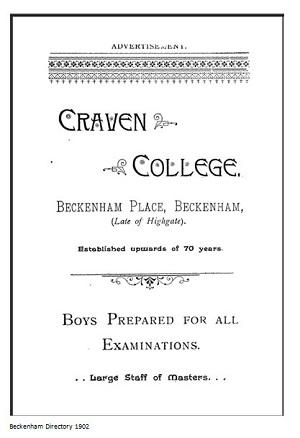
The College occupied Beckenham Place from approximately 1900 to 1905
under the
headmastership of J. Hartley French. It then moved to Elmer Lodge at
Elmers
End, possibly because of the loss of sports facilities due to the lease
of the
park to the newly formed Foxgrove Golf Club.
Elmer
Lodge was built in 1856 on the
site of a 17th century predecessor and still exists today,
substantially
unchanged externally apart from the loss of its conservatory. Today it
is a
mosque after many years existing as a public house called appropriately
‘The
Elmer Lodge’
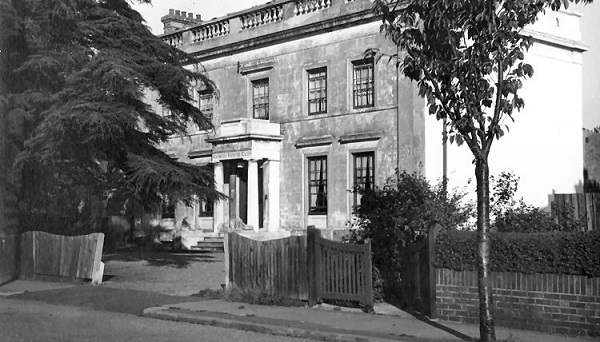
Elmer
Lodge
J. Hartley French was succeeded as headmaster by Mr W.T. Carlin who
held the
post initially assisted by a Mr E M Verall, until the demise of the
College at
the outbreak of the 1914‑18 war. The existence of the former college
was
commemorated by the nearby 1930s shopping parade, known as "College
Parade" until comparatively recently.
1906
to 1933 - Beckenham
Place; From
1906 until 1933
Beckenham Place was the home of the Norwood Sanatorium which
specialised in the
voluntary treatment of wealthy(?) alcoholics and drug addicts. It was
founded
by a Dr Frances Hare, a retired Inspector of Hospitals for the
Australian State
of Queensland. The occupations of the patients in the 1911 census
return is
perhaps informative i.e. Medical practitioners and a chemist, a retired
army
officer, private means and an artist.
The
reason for the name is probably
because the sanatorium previously occupied a building at Crystal
Palace,
strictly speaking Upper Norwood, now called The Alma public house. The
faint
inscription 'Sans Souci’ still to be seen over the front door
of the
mansion is
believed to date back to this sanatorium period or was imported with
the
stonework from Wricklemarsh in the late 18th or
early 19th
century.
The
Conveyance of the park to the LCC
in 1928 states that a lease was taken out on the Mansion on 1st
of
May 1906 for 21 years by Margaret Piper Rickman and later in 1925 the
Norwood
Sanatorium Limited took out or extended the lease for 7 years which
would put
the expiry into 1934. The implication here may be that Margaret Rickman
sub-let
or was acting on behalf of the Sanatorium.
Eric
Inman relates: The sanatorium
opened its doors on September 25th 1905 with 13 patients, a number
which peaked
at 232 in 1913. The average length of stay was six to eight weeks and
the
inclusive weekly charges pre‑war were £7.17s.6d a week,
falling to
£7.7s.0d
after six weeks. This included medical attendance, medicines, board and
lodging, games and ordinary services all provided in luxurious
surroundings, as
can be seen from the four interior pictures which are included by kind
permission of Bromley Libraries.
The
billiard and smoking rooms were
reserved for gentlemen. The room to the left of the front door is
thought to be
the billiard room. That room was occupied by the Friends of Beckenham
Place
Park Visitor Centre from 2000 to 2019. The
drawing room was for the sole use of ladies, except when afternoon tea
was
taken there or gentlemen were invited for music or evening games. These
could
not last long as ‘lights out’ was at 10.30pm.
The
sanatorium advertises its amenities
as including, lawns for croquet, tennis and bowls. The home farm
supplied fresh
milk, new laid eggs and chickens for the table, whilst the hothouses
and
vegetable gardens provided fresh fruit and vegetables, including
grapes,
peaches and tomatoes.
Dr
Hare retired in 1925 and died three
years later at his home, 'Oakland's', 15 The Avenue, Beckenham. Kelly's
Directory lists his successors as being Dr George (1926‑7), Dr Barham
(1931)
and Dr Given (1933). A Dr Walter Masters, who is not listed in the
surviving
editions of Kellys, is, in a detailed biography, described as taking
over from
Dr Hare before 1928 and moving the business to Chislehurst, because of
a lack
of space.
Doctor
Hare authored several books on
the treatment of addiction. We have accessed the 1911 census records
which we
reproduce here for illustration of the numbers of staff and patients
present at
Beckenham Place.
 )
)
An
interior of the
mansion when a sanatorium
1906 - Albemarle Cator (II or jnr.) dies and is succeeded by his son
John Cator
(1862-1944). It is under this John Cator that we presume that Beckenham
Place
Park was sold to the London County Council. The various leases and
sales of
other land is too complicated and lengthy to attempt to fully relate
here. A
reminder that Pat Manning's book covers the Cator family in some detail
and
researching the various online archive catalogues is informative.
Looking at
the online catalogue of Bromley Local Studies also reveals some basic
details
of land sales and development. The estate plan of 1833 is annotated as
being
part of the Will documents of Albemarle Cator.
Estate
Plan
annotation – Courtesy of Bromley Historic Collections
1906
- The Eden Park Polo Club is
disbanded but the Crystal Palace Polo Club move into their ground (to
be
identified). https://en.wikisource.org/wiki/Page:VCH_Kent_1.djvu/595
1907
– Beckenham Place Stables: a lease
for 21 years taken out by Philip George Collins and others and extended
by one
year to expire in 1927. The interaction between the Sanatorium, Golf
Course and
Stables is still unclear as the occupancies run alongside each other.
The Home
Farm is leased at a later date, see 1918 and maybe 1911 if I can find
the
census return.
1907
- The Foxgrove Golf Club is
established on the grounds of the estate. A lease is taken out for 21
years
with a ‘variation’ dated 1913 which might have
related to the building
of the
clubhouse. This implies that the golf club occupancy expires in 1928.
The
"Foxgrove Club" Edwardian building is built circa 1912 by club
members. From 1933 to 2016 it is a private social club. In 2017 it is
occupied
by caretaker tenants.
The
Creation of the Golf Course
A group of Beckenham residents formed the Foxgrove Golf Club and in March of the same year leased most of Beckenham Place Park, apart from the woods and the immediate surroundings of the home farm, for a period of 21 years. Little time was lost in building a club house and laying out the greens, for in October of the same year the first monthly medal meetings were held for both ladies and gentlemen. Shortly afterwards a commemorative dinner was held in the new clubhouse, which over fifty members attended. (source: Eric Inman)
1909
- Lord Gwydir; Although the
Gwydir family severed their
connection with Beckenham in 1820, when, on the death of the first Lord
Gwydir,
the Burrell estates were sold, it is fitting that mention should be
made of the
death of the fourth Lord Gwydir, which took place at Ipswich, in April,
1909, within
twenty- four days of his entry into his 100th year. He was able to
boast that
he had been present at the coronation of three British Sovereigns, and
lived in
the reigns of five, and that he had also lived during the time that
thirty
Ministries held office.(Borrowman)
1910 – Robert Borrowman publishes his ‘Beckenham Past and Present’ drawing on his local knowledge and the works of Philipott, Hasted and Ireland as well as material he could access in Beckenham Parish records. We must 'sort' the material of Borrowman, filtering material we have found to be erroneous from that which Borrowman is the only reliable source. He reiterates earlier accounts about Beckenham, the origin of Beckenham Place to 1773 and Cator’s purchase of Beckenham Manor from Bolingbroke. It seems he is not aware of the prior sale of the old Manor House or of the problems Cator has gaining full occupation of Beckenham Manor until 1780. Nor of the fact that Beckenham Place is in the Manor of Foxgrove. Nevertheless, his book has interesting information about the Parish. Borrowman admits that information about the early history of Beckenham is ‘meagre’. Borrowman does reveal to us other historians of Kent such as Lambarde, Kilburne and Harris, but they throw no further light on my research.
We
have now (2024) included the scanned copy of
Borrowman accessed via the Contents listing.
1911
– The 1911 Census is made
available and we can tell who was occupying the various buildings in
Beckenham
Place and elsewhere. The Mansion was the aforementioned sanatorium
which came
under Beckenham district. The Stables, Garden Cottage and North gate
Lodge,
under Lewisham district, were occupied by golf course groundsmen and
gardeners.
It would appear that the Stables only had two families in residence
whereas
later as a public park the stables had 5
‘Homesteads’ for park workers
and
families. In 1911 the Gamekeepers Cottage had a couple living there, we
take
this to mean the cottage that was in Summerhouse Wood. No mention of
occupants
of Home Farm in this census apparently or not yet traced.
1913 – Langley; 6th January – Langley House which had been adopted as the Clubhouse for Langley Park Golf Club burnt down. This building has replaced the earlier house shown in the 1779 Hasted print. The Burrells undertook some rebuilding circa 1790.
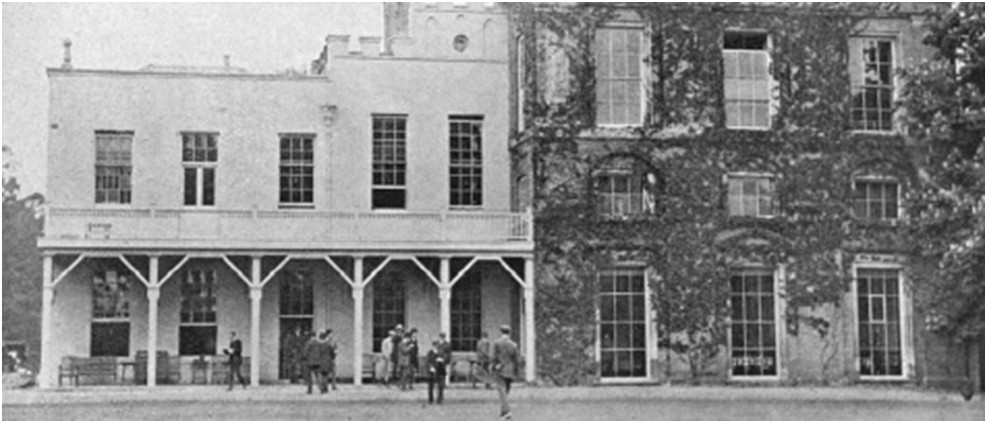

Some
questions regarding Langley
House and Lodge remain unanswered as some accounts say the house was a
POW camp
during WWII but aerial pictures attributed to 1945 show the House and
the Lodge
had been removed. We cannot say how or when the house or houses were
built or
altered, some say circa 1790 under Lord Gwydir (Peter Burrell IV) and
maybe some papers will emerge from archives revealing some
detail
eventually. Humphrey Repton had produced plans for relandscaping the
grounds in
the late 18th
Century but these do not appear to have been
carried
out in full but some features of the earlier grounds had been
abandoned if not relandscaped ie see our account of the Roman
Bathhouse and long ponds in the earlier 1735 onwards house.
1920
– Several conveyances of sites
either on the private road, Beckenham Place Park or on Southend Road
which were
part of Cator’s parkland. One in 1921 on Foxgrove Road
adjoining the
private
road, a house called Foxgrove which had been build in 1880’s?
1920
– Several conveyances of sites
either on the private road, Beckenham Place Park or on Southend Road
which were
part of Cator’s parkland. One in 1921 on Foxgrove Road
adjoining the
private
road, a house called Foxgrove which had been build in 1880’s?
1927
- The London County Council
decides to acquire Beckenham Place park from the Cator Estate. The
minutes of
the LCC record that there is a need for public open space for the
housing
estates of Downham and Bellingham which are being developed. A
transcript of
the minutes can be found later on. Of course the LCC did not see the
Local
Authority boundaries which bisected the park as overly important. The
price was
£47,000 although the later conveyance states
£43,000. At some point the
Mansion
and Homesteads have living accommodation provided for park staff. The
Garden
Cottage and the Gatehouse lodge also are lived in by staff. Seven
'cottages'
and maybe 2 apartments in the Mansion. Over time managers, supervisors,
gardeners and groundsmen are accommodated there with their families.
Maintenance and security are provided by on-site staff. Large areas of
woodland
are fenced to protect it with a balance of areas of protection with
areas of
free access. The condition of the lake is not clearly known but the
1930's map
below shows the lake has been reduced in size. To the east of the
railway the
land is described as a gravel pit, reed beds and an athletics ground.
Thomas
Cook's had the athletics ground for a period of time but it later
became the
Catford Sports and Social Club for council employees. The gravel pit
and reed
beds are believed to have been used for wartime bomb rubble or as one
source
describes for spoil from the building of housing estates. Anyone having
more
information please contact us. Old family photos or similar information
welcome. Apart from the reason that the LCC saw a need for open space,
the
landed gentry had been finding it difficult to maintain estates after
WWI and
maybe this was an incentive for the Cator Estate to dispose of the
park.
1928
– The date of the conveyance of
Beckenham Place from the Cator Estate, John Cator of Woodbastwick Hall,
Norfolk, the vendor and the estate trustees to the purchaser, the
London County
Council dated 24th January. The LCC cites the
Open Spaces
Act 1906
as amended by the LCC General Powers Act 1926. The purchase price of
£43,000 is
made up of two parts, £16,000 under the Open Spaces Act and
£27,000
under the
General Purposes Act. It should be a matter of record that the southern
part of
the eastern side of the railway which we call Summerhouse Field must
have been
acquired at a later date as at one time this was Thomas Cooks Sports
Ground and
became the Catford (Lewisham) Council sports ground at a date to be
discovered.
It is described as an Athletics ground on the map accompanying the
conveyance.
Some areas of Beckenham Place parkland had been either partially sold
or leased
over a period of time from the late 19th Century
to early 20th
Century. Whereas it would once have extended to Foxgrove Road in the
south and
to Southend Road/Beckenham Hill Road in the west, properties were
disposed of
along the latter roads on the west and the private road
‘Beckenham
Place Park’
was inserted into the landscape for large properties, only 1 of which
survives,
St. Margaret’s. The others have been redeveloped into smaller
plots
over time.
For example a house called Dura Den is now a close of several smaller
houses.
Stumphill
Wood is mostly outside of the
park conveyance seemingly following the boundary between Beckenham
Manor and
Foxgrove Manor. Whether this has anything to do with the
Cator’s ‘Lord
of the
Manor’ rights is subject to debate and research. The Land Act
of the
early 20th
Century redefined some of these priveledges. It is still shown as an
area of
woodland on both sides of Beckenham Hill Road and Southend Road though
some
large houses are on the west side mostly in Lewisham Parish or Borough.
The
farm, stables and lodges of the
park had been leased and rented for several years prior to the LCC
purchase. An
area bordering Old Bromley Road on which now stands the ......Club, old
abandoned changing rooms and the childrens playground is not included
in the
park purchase and must have been acquired at a later date or separately.
Some
questions arise from the 1928
Conveyance map such as a building on Crab Hill on the site of later
changing
rooms for football pitches, a smaller hut close by. The path up from
the Crab
Hill entrance is more of an access into a gravel pit and it mush be
assumed
that the later Prisoner of War Camp had something to do with
alterations in
this area as well as any changes to do with public access to the park.
The fate
of the cottage or gamekeepers hut in the woodland which was even still
showing on
A-Z maps into the 1980’s is unclear but is now a few bricks
at
foundation level
if you are lucky enough to find them.
The
map explains the old water course
to the lake in that there is a drain along Westgate Road following
round into
Beckenham Place Park (private road) and then turning into the park
toward the
lake. The lake had been reduced in size by approximately half by the
time of
the conveyance. Earlier maps show springs and ponds in this area and it
is to
be assumed that the spring is put into the drain in Westgate Road quite
close
to the school, which once had a pond on the site of its playground. The
dryness
of the stream or drain may be attributable to drying up of the spring
or
diversion of water into sewers. This can be compared to the drying up
of
Foxgrove Farm mote due to the West Kent Sewer installation and drying
up of
some ponds and drains on the west side of Stumpshill in the region of
Braeside.
Diversion of rain run-off from roofs and hard standing into drains
rather than
into the topsoil and groundwater can all contribute to drying up of the
underlying clay and Blackheath (Harwich Formation) Beds. The fact that
water
for the new lake is drawn up from a borehole some depth below the
surface
indicates the dryness of the ground nearer the surface.
1930
– Eden Lodge; was constructed on part of the
Eden
Park estate now part of Harvington open space. Some
remains
of the foundations are visible in woodland.
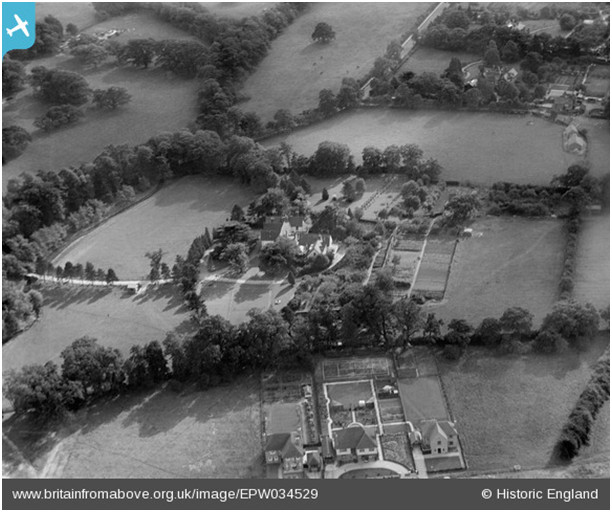
1931
- The Home Farm in Beckenham Place
Park is vacated and demolished. Below is one of two paintings produced
by a
lady who lived at the farm when she was a young girl. There are some
references
to fresh milk, new laid eggs and chickens being supplied to the
sanatorium in
the 1920s from a home farm, no trace of which now exists other than in
some
aerial views of the park taken in 1996 the
‘footprint’ of the building
can be
seen clearly in the grass as 'crop marks'. Maybe at least two
farmhouses were
destroyed in the original creation of Beckenham Place Park and perhaps
a new
one built to supply John Cator in his mansion. It could be that Home
Farm was
in existence when Cator bought the land as the Rocque map shows
buildings
between the site of the mansion and Flower House. Some buildings shown
on early
maps appear to have been swept away in the creation of the park. Home
farm was
just inside the north gate. This was not demolished until 1931.
Groundwork
associated with the 2018 landscape work may have covered over the
evidence of
the farmstead, only time will tell.
If
one studies the Roque map it might
be deduced that there was a house already in this position and a farm
in the
vicinity of Home Farm. As map making was inaccurate before the Ordnance
Survey
then exact positions cannot be identified.
One
of the early farms was on the
opposite side of the road to the mansion, just outside the present
southern
gate to the park on a site now occupied by modern houses. Rocque's 1745
map
also shows a building and gardens opposite the position of the present
mansion,
though whether this was a farm, outbuildings or gardens belonging to
the
previous house is not clear.It consisted of a picturesque huddle of
buildings,
which had obviously grown up over the years and is well depicted in
this
watercolour made in the early 1920s/30s by an unknown lady artist.
Reproduced
by courtesy of Miss I Krombach, who spent some of her childhood at the
farm and
is probably the artist.
The Home Farm lost much of its land when the private golf course was
constructed, originally consisting of 9 holes. The purchase of the park
by the
LCC and the departure of the sanatorium to Chislehurst deprived the
farm of its
reason for existence. Its final occupants from 1931‑33 were the
Krombach
family, in residence when the farm was leased by United Dairies to
stable its
horses. It was demolished soon after they left and the site
incorporated into
the now public golf course.(source E.Inman) The position of Home Farm
shown on
an 1860 OS map. Home Farm just below the Lodge.
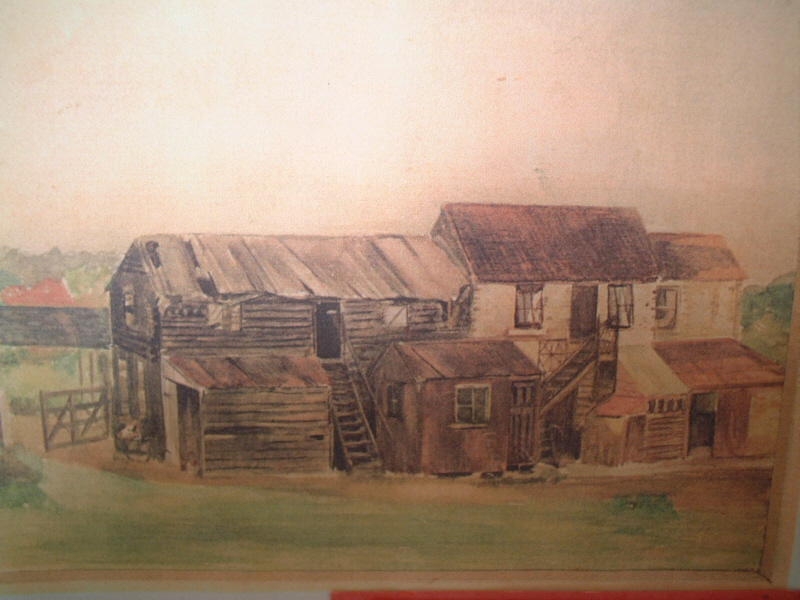
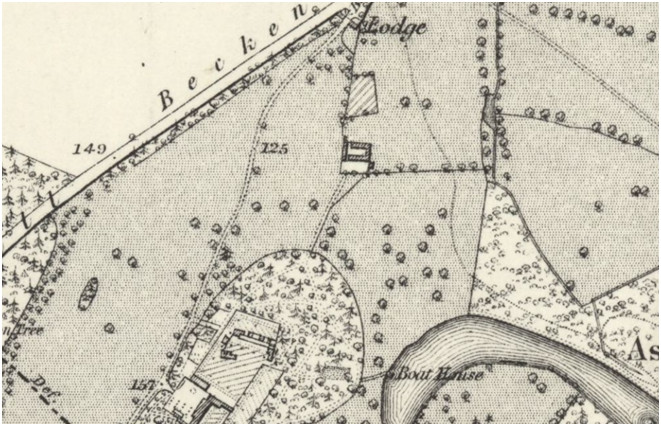
Home
Farm or Beckenham Place Park Farm
depicted by a young girl who lived there (Miss I. Krombach?). map; National
Library of Scotland (nls kent vii)
1933
- The Beckenham Place Golf Course
becomes public and at one time the busiest in Europe, see 2016 for
history and closure.
1935
– Beckenham Place; An avenue of Oak
trees is planted along the drive in the park to mark the Silver Jubilee
of
George V’s reign. (source; anecdotal evidence).
Among
the changes which are thought to
have take place after the purchase of the park from the Cator estate
are:
removal of some outbuildings and greenhouses around the kitchen garden,
conversion of the kitchen garden into formal gardens and tennis courts,
removal
of the game keepers cottage and pheasantry in the woodland. Conversion
of the
homesteads including the installation of Crittal type windows and
installation
of sheds for park management equipment. Essentially before English
Heritage
property listing features which might otherwise have been preserved
were lost.
But in the light of more recent decay due to neglect then the situation
is
about the same.
1939/45 – WWII: Other accounts recount the events of WWII but
an
Italian
Prisioner of War 'Summerhouse' Camp was constructed on Crab Hill in
Beckenham
Place Park and an anti aircraft gun and barrage balloon emplacements
were installed,
although later the AA batteries were positioned around London as
falling
shrapnel was causing more damage to ground infrastructure than it was
to enemy
aircraft. Sheep grazing and growing of some crops for the war effort is
introduced. Curiously enough the nearer one comes to the present day
the more
difficult it becomes to find out what happened to the mansion and park
although
maps of bomb sites now show that many fell in Beckenham generally.
These
recollections of Derek Bates who
was aged 6 or 7 at the end of WWII and lived in the stable yard
homesteads in
the park because his father was part of the park staff although he
joined the
RAF during the war. Derek recalls a V1 falling on the golf course in
front of
the mansion. In a memoir written primarily for his family but a copy
donated to
the Friends of Beckenham Place Park he recounts the windows and roof of
their
cottage being damaged and repaired, collecting bits of V1 and the army
taking
away parts of the rocket. Disappointedly he recalls his mother giving
his
shrapnel collection to the army. He also recalls seeing a V1 destroy
housing
nearby which must be the record below.
Nearby
residents recall a bomb crater
just off of Worsley Bridge Road and Greycot Road. The area experienced
several
bomb hits, V1's and V11's. Bomb strikes were mapped quite
comprehensively.
This
entry recalls a V1 strike near the
park: “The Flying bomb exploded In Beckenham Hill
Road. 1-11 ,2-16
Highland
Croft,1-23 and 2-50 Braeside.184,186,188 Beckenham Hill Road, 37b
Beckenham
Hill Road, 31-37Southend Road, 42-80 Southend Road, Ada Lewis House
Southend
Road. Were damaged.”
An
anti–aircraft gun and later a
barrage balloon were sited near the mansion, with the operators of the
latter
being based in a wooden hut to one side of the mansion forecourt. (A
recent
park visitor, who had been stationed with the AA battery, informed us
it was
only here for a short time as the tactic was changed from having single
weapons
stationed locally, to having a larger battery at West Wickham). It has
been
said that Anti Aircraft fire injured or killed more civilians than it
did enemy
aircraft. Sheep were grazed on the golf course, but whether this
displaced or
supplemented the golf is something else it would be interesting to know.
Part
of the park was dug up to grow
potatoes and other vegetables particularly during the latter part of
the war,
when it was used as a prisoner of war camp. It housed Italian prisoners
and
according to one Italian book entitled ‘Prigionieri Italiani
in Gran
Bretagna
(1940-47) was Camp No 233, known as Summerhouse Camp, Ravensbourne,
Bromley,
Kent. Probably some of the bumps in the ground may owe their origins to
this
period and not to some more distant times as some believe. Some of the
paths
through the woods also owe something to the efforts of the prisoners,
as well
as stonework and path-laying in some local houses.
A consultants report produced for the Heritage Lottery Fund bid found
that
several high explosive bombs fell in the park but no damage to
buildings is
recorded. Several websites show maps of bomb and rocket explosion
sites. No
deaths were reported for those in the park.
Another
camp on
Worsley
Bridge Road accommodated German navy POW's according to local
residents. Again,
this camp narrowly avoided being hit by bombs which fell nearby.
The
camp was on a sports ground which once belonged to Cornhill Assurance
Company
close to the Lower Sydenham Industrial estate and nearby housing.
Currently the
site belongs to Sydenham High School. The photographs on
historicengland.org are mostly dated 1946 and 1947. Prefabs can be seen
constructed on what appear to be bombsites after rubble was cleared.
The
photographs tempt me to believe that some records or anecdotal evidence
must be incorrect or the dates on photographs are suspect.
Some
photos show parts of POW camps start as a collection of bell tents
presumably later replaced by huts as the need to accommodate more POWs
increased. When trying to match bomb sites with photos there is very
little evidence of craters so presumably the rate of clean up
was
quite fast. Today we can trace relatively new constructions
on
these sites compared to the surrounding 'original' houses. Bear in mind
that in most cases houses built late 19th/eary 20th Century
were
the first houses built on the majority of the areas which had been
agricultural land.

This image from Google Earth Historic imagery shows the Beckenham Place
Park POW
camp (Summerhouse Camp) on Crab Hill and the other image from
historicengland.org which shows additional structures in
Summerhouse Field.
1945 – Beckenham Place; From here until 1990 very little is
known apart
from
the fact that the LCC/GLC managed the park and golf course and kept it
maintained to a high standard with staff and wardens. Derek Bates is
again a
source of some information relating how his father spoke with visitors
to the
gardens giving horticultural advice. Some photos from his family album
show how
the park was well maintained. Several records are in the London
Metropolitan
Archive regarding maintenance work at Beckenham Placer performed by the
LCC.
I
personally recall how busy the golf
course was, with a long queue of cars waiting for the park to open with
eager
golfers. It was almost impossible to get a game at weekends and usually
very
busy during the week. For many years the golf course brought plenty of
money
into the coffers of Lewisham Council after 1970’s but very
little money
was
spent on the infrasture of the park. Regretably few records are easy to
acquire
but at the Public Enquiry recent accounts showed a income of over
£230,000 but
somehow all of it was spent or absorbed into general
“parks” budgets
obscuring
any accurate profit and loss accounting.
1959
– Langley Roman Bath; this is from
the archive of G.W.Tookey; (The Roman
Bath and a few other features in a ruinous state are all
that
remain of
the Langley estate which passed through the ownership of the Stiles,
Raymonds,
Burrells and Goodharts).
T.114
THE LANGLEY PARK BATHS
These baths are situated on Langley Park Golf Course in a hollow about
one
quarter of a mile to the south of the Beckenham Girls’
Grammar School
buildings. The larger bath is open and comprises a brick lined basin
about
twelve feet wide and fifty feet long. The smaller bath is in a brick
building
and comprises a small plunge bath about four feet wide and nine feet
long the
depth of the water cannot now be gauged with accuracy owing to the
amount of
debris in the baths, but there was at one time without doubt several
feet of
water in the big bath and at least two or three feet of water in the
small
bath.
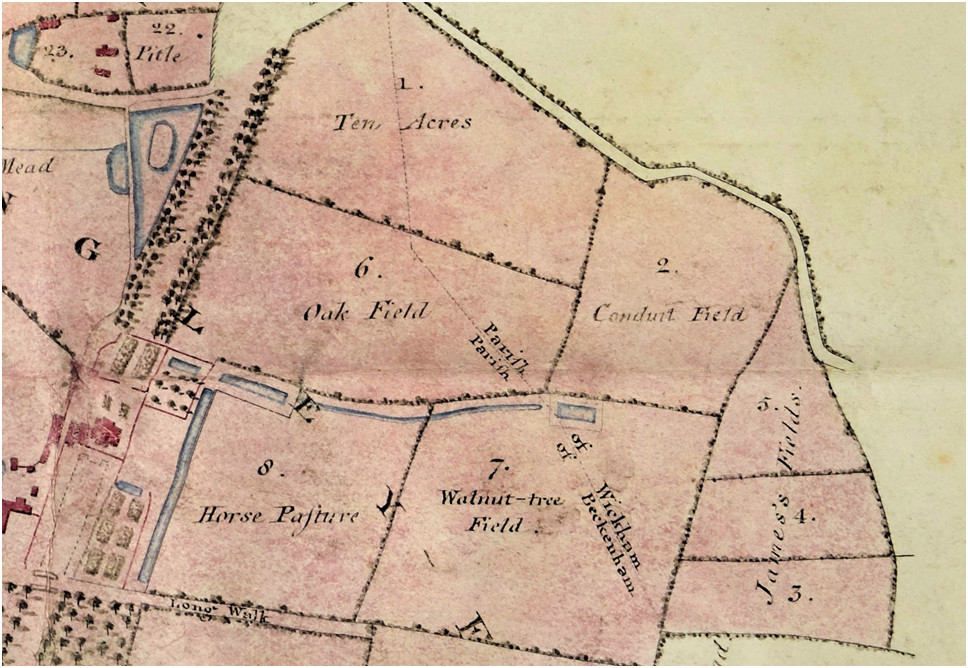
Early
maps show the field to the
east of the site as "Conduit Field" which indicates that the springs
of water which rise out of the ground there were piped down to the
Langley
mansion which stood on the site now These springs are not now serving
as a means
of water supply to any house, but they still keep the baths filled with
fresh
clear and cold water, although the general appearance of the baths has
for many
years now been spoilt by the sad state of ruin into which they have
fallen,
largely as a result of the destructive work of children playing there
and
throwing everything movable into the water and also as a result of the
side
walls of the large bath caving in.
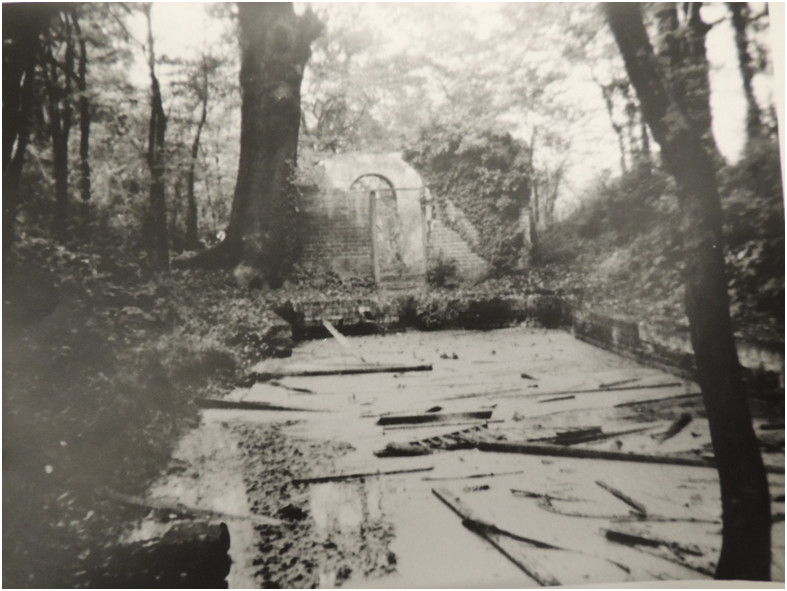
There is a photograph (No.963) which was taken some time in the late
nineteenth
century showing the large bath in a reasonable state of upkeep,
although it can
be seen that the sides are already slightly bowed inwards due to the
pressure
of the surrounding soil, much of which would have been excavated from
the bath
when it was constructed. The building at the north end, in which the
small bath
is situated, is beginning to show signs of lack of repair with one
light out of
the window over the doorway. The tree at the corner of the building has
already
reached an uncomfortable size for its position.
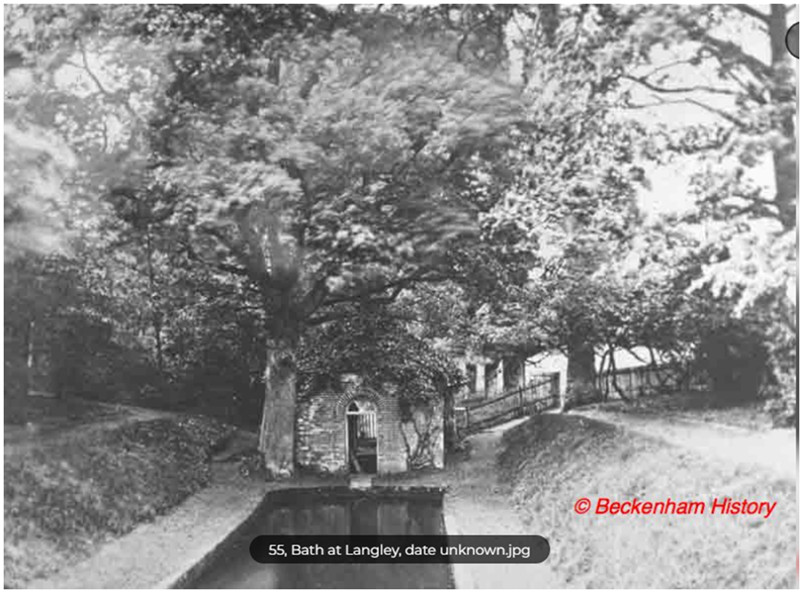
The
original of the picture is in
Virginia U.S.A in the possession of Mr. Leander McCormick-Goodhart
whose father
was the last owner in residence at Langley. A copy of the photograph
was
supplied by him in 1954.
The small bath is shown in the photograph taken in 1952 (No.820) after
it had
been cleaned out to a certain depth by F.A.Watts and G.W.Tookey of the
Beckenham Historical Association. The clearness of the water can be
seen and
there was an abundant supply coming in at the time. The conduit at the
south
end of the bath connects with the large bath, and the outlet at the
other end
goes to form a stream running through the park towards the site of the
house.
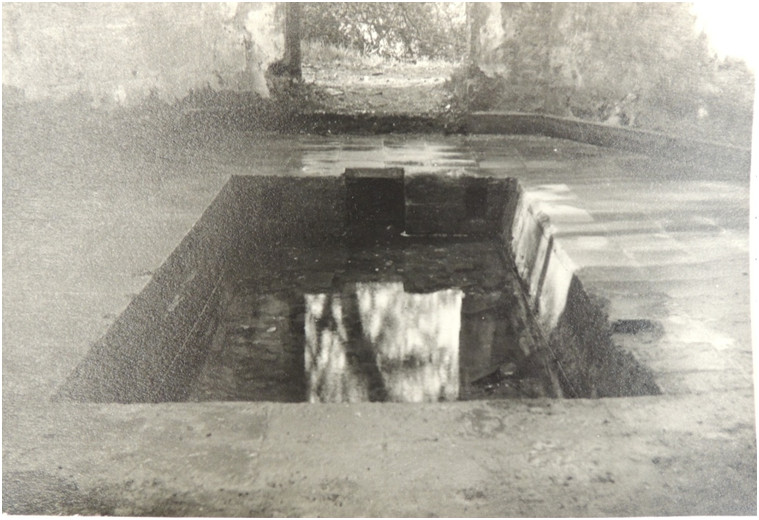
The
date when the baths ware
constructed is not known for certain, but it is probable that they were
built
in the first half of the eighteenth century. They are shown on a map of
the
Langley estate in the time of Jones Raymond (Photograph Q.116) end this
is the
first map which is available of the site. Jones Raymond succeeded to
the estate
on the death of his father Hugh Raymond, in 1757, and Jones himself
died in
1768, It is possible that the baths were constructed at the same time
as the
new Langley Mansion was built, which was probably in Hugh Raymond's
time at
Langley (1752-7). The house was certainly of that period.
The baths would serve the purpose of both sport and hygiene. The large
bath
would provide a swimming pool of ample proportions, and the small bath
would
fulfil the purpose of a plunge bath in the privacy of the small
building. There
would have been no such baths in the mansion at that time. The house
was
improved by Sir Peter Burrell (later Lord Gwydir) when he inherited in
1789
from his mother Amy Burrell, who was Jones Raymond's sister. Even so,
the house
contained no bathroom, although by 1820 at any rate the house could
boast of
two water closets. These are referred to in the particulars of the
Auction
which followed on the death of Lord Gwydir in 1820, The particulars
mention the
"cold bath in the park”.
Although the small bath has sometimes been referred to as a "Roman
Bath" there is no indication that the construction is of Roman date at
all. Nevertheless it is worth noting that the bath lies within a few
feet of
the ancient Roman road which ran from Lewes to London through West
Wickham and
Beckenham and that it is probable that the place was known and used as
a source
of pure spring water from very early times.
The spring is not to be confused with the "Woe Waters" referred to by
Johan Warkworth, the chronicler in the time of Edward IV, as being a
"pytte ie Kent, in Langley Park". This reference applied more
appropriately to the subterranean flow of water in Langley Park near
Maidstone
(see Hasted’ s History of Kent Vol.II page 140).
15th September 1959. G .W .TOOKEY
1971
- Control and ownership of
Beckenham Place passed from the Greater London Council to the London
Borough of
Lewisham (LBL) and in 1995 the boundaries were adjusted so that the
whole of
the park fell within Lewisham. Prior to this the mansion was in
Beckenham,
(since 1965 part of the new London Borough of Bromley), whilst the
stables were
in Lewisham as evidenced by a number of parish boundary posts which can
still
be seen within the park today. The present condition of the mansion and
stables
reflects the inability of any borough council to fund, repair and
maintain a
Grade 11* nationally listed building, when faced with competing higher
priority
responsibilities. Some sources mention the park was briefly in the
possession
of Bromley Council but we can’t confirm that.
1976
– Beckenham Place Park and other
open space is designated Metropolitan Open Land, a form of inner city
Green
Belt under the Greater London Development Plan.
1984-7
– This extract from the Beckenham
Place Conservation Management Plan of 2009:
Records
at English Heritage confirm the undertaking of further repair
works in 1984-7 including the insertion of the large steel beams above
the
lantern, repairs to stacks, the
aluminium light over the main hall, dry rot repairs. Investigation of
the
decorations to the ground floor ceilings was undertaken by English
Heritage in
about 1985. No record of the investigations has been found but they are
understood to have been entirely consistent with the ceilings being of
late C18
date.
1992
- Football pitches and changing
rooms in the eastern part of the park are closed to enable David Lloyd
scheme
(DLL). Stable Block Homesteads and other accommodation cleared of
tenants to
provide vacant possession to DLL. 11 football pitches were fully used
at
weekends so this was another example of removing one group of park
users for
another as with the golfers at a later date.
1992
– London Borough of Lewisham
attempt to pass occupation of the park to David Lloyd Leisure for the
purposes
of an indoor Tennis centre and extended golf facilities. A Public
Enquiry leads
to rejection of the plans to extend golf and add indoor tennis centre.
Ironically, this scheme would have more than doubled the golf area, as
well as
covering a large area of the park with indoor sports facilities. Later,
in
2015, the golf is deemed unviable and removed completely.
1993/2000
– Although the Tennis Centre
scheme is refused the Park is managed by David LLoyd Leisure as a 7
year
management contract had been awarded prior to the public enquiry.
Rejection of
the tennis centre and golf extension plans was largely because of the
MOL
status of the park. In 1993 planning permission was granted in
principle by
London Borough of Lewisham for a sporting venture, which would have
radically
transformed what is Metropolitan Open Land (MOL) into inaccessible
sporting
areas, at the expense of informal leisure activities by the general
public.
Determined opposition by a widely supported and well-organised
‘Save
Beckenham
Place Park Campaign’ and other groups led to a public inquiry
and
rejection of
the application in 1994. Many local and national groups were active in
the
campaign, primarily the Ravensbourne Valley Preservation Society, a
local
residents association. Other groups included The London Wildlife Trust,
Council
for the Protection of Rural England, Friends of the Earth and Save BPP
Campaign
group. Despite DLL being a large tennis related company they cannot
provide
enough nets for 3 tennis courts?
1993
- The Friends of Beckenham Place
Park is inaugurated to attempt to positively influence the management
of the
park for conservation, heritage and open space use. At the same time
the London
Borough of Lewisham ex-Mayor John Rudd establishes the Beckenham Place
Park
Working Party for all interested parties to have a forum to discuss
park
related matters. Unfortunately the Council disband this forum in 2016
in a
democratic backward step, in favour of forums which divide opinion.
1996
– The Friends of Beckenham Place
Park open a volunteer run visitor centre in a vacant cottage in the
stable
block. There had already been a high level of vandalism and the Friends
repaired and decorated the cottage to a degree where a park
conservation worker
lived there for some years afterwards. Permission was granted to open a
Visitor
Centre in the stable block in January 1996 to be run by volunteers from
the
Friends.
1997
– about this time, Eric Inman
produces a series of articles on the History of Beckenham Place for the
Friends
of BPP newsletter. Eric and I accepted various other sources such as
Hasted as
bonafide but this timeline account explores aspects of written
histories which
have been shown to be inaccurate.
1998
- Len Hevey's book "The Early
History of Beckenham" is published. Written circa 1994 is confirms many
early events which we have rediscovered independantly. It was published
after
Len's death.
1999
– The Visitor Centre removed to
the Mansion in November 1999. We regret leaving it as it might have
saved the
stable block from the later fire in 2011.
The
21st Century (Beckenham Place
unless otherwise stated)
2000
- The Friends’ Visitor Centre
moves into the Mansion at the invitation of a park manager.
2000/2014
- Various changes is park
management take place after the expiry of the David Lloyd Leisure
contract and
the takeover of the leisure
company by
Whitbread Brewery. Consultations are carried out regarding use of
buildings,
including rejection of a charitable trust bid for management of the
mansion. As
part of one management tendering exercise around 2009 a firm of
architects,
Rees Bolter, produced a Conservation Management Plan (CMP) for the
Mansion and
a summary of possible uses. The CMP has a lot of interesting
information about
the park and mansion including details of past stages of renovation and
repair.
It is worth a read but bear in mind that some of the history has since
been
altered and revealed. The CMP describes how the mansion resembles
Palladian
designs in Italy among other things.
2002 - Local Nature Reserve Listing (LNR) and Large Turkey Oak blown
down:
Wayne Butler as an in-park conservation officer employed by a park
management
company gets the park listed as a nature reserve. The Turkey Oak tree
which was
the second largest of its species in the UK and was over 230 years old
came
down on a windy day. The trunk had been hollow for many years and it
had
suffered from vandalism which weakened it. The date and age indicates
it may
have been planted by Cator. Perhaps supplied by his father in law,
Peter
Collinson who supplied many of his contacts with young trees probably
cultivated in his Mill Hill garden. Turkey Oak was introduced from
Turkey early
in the 18th century and thought to be a valuable timber but it decays
quickly
when harvested. 15 years after its demise very little can be seen of it
apart
from some largest pieces of its trunk. It would have stood very near
the end of
the original lake.
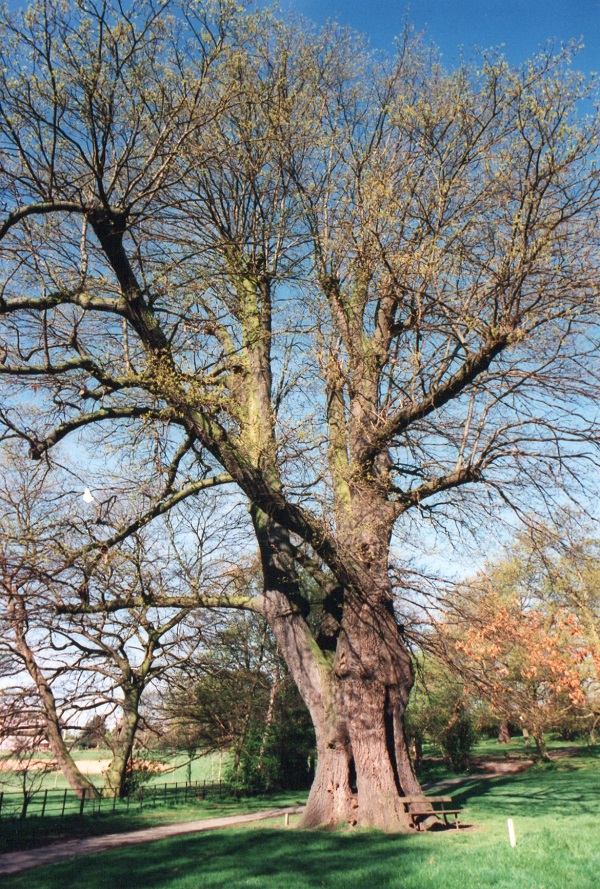
Turkey
Oak - over 230
years old
2004
(?) - Beckenham Place: Mander and
Mitchenson Theatre Collection leaves the mansion: having occupied most
of the
mansion upper floors for over 20 years the collection is moved firstly
to the
Greenwich University and then to Bristol University to join other
theatre
memorabilia. Though the collection originally had plans to turn the
mansion
into a theatre museum they both did not raise enough funding and also
did not
in my opinion take the opportunity to apply to the National Lottery
Arts Fund
to achieve their aims. Though occupying the mansion the collection made
no
contribution to its upkeep and was not open to the public.
2009
– A Conservation Management Plan
is produced by Rees Bolter Architects. One of several
‘consultations’
commissioned by L.B.Lewisham this plan outlines possible uses for the
mansion,
its condition and history of maintenance. Though containing some errors
or
omissions regarding the history in our view, the Plan was comprehensive
but not
acted upon to any great degree. The Plan may be viewed through a link
on the
Friends of BPP website.
The
management plan was introduced
thus: (but in this history we dispute some dates) but the plan does
reveal some
otherwise unknowns.
Beckenham
Place is a Grade II* listed
mansion of c1774 with a simple stone faced exterior and a number of
important
interior rooms. It was extended in about 1810 by the construction of a
new
entrance front which incorporates a great deal of material from the
great house
of c1723 at Wricklemarsh. The estate was purchased by John Cator in
1773 and
remained in the Cator family until 1926 when it was purchased by the
London
County Council. The Cators occupied the house until about 1825; it was
let to a
series of tenants during the remainder of the nineteenth century and
was in
institutional use in the early twentieth century. Since passing into
public
ownership the house has provided accommodation for refreshment rooms
and golf
related uses on upper and lower ground floor levels. Upper floors were
in
residential use for a time, were briefly occupied by a theatre archive
and have
now been empty for about ten years. The mansion is an important
building,
reflected in its Grade II* listing, principally because of its position
in the
designed landscape, the interiors of the upper ground floor and the
salvaged
fragments of Wricklemarsh.
As
the conservation management plan
concentrated on the house more will be said in ‘Additional
Information’
under
‘The House on Stumps Hill’
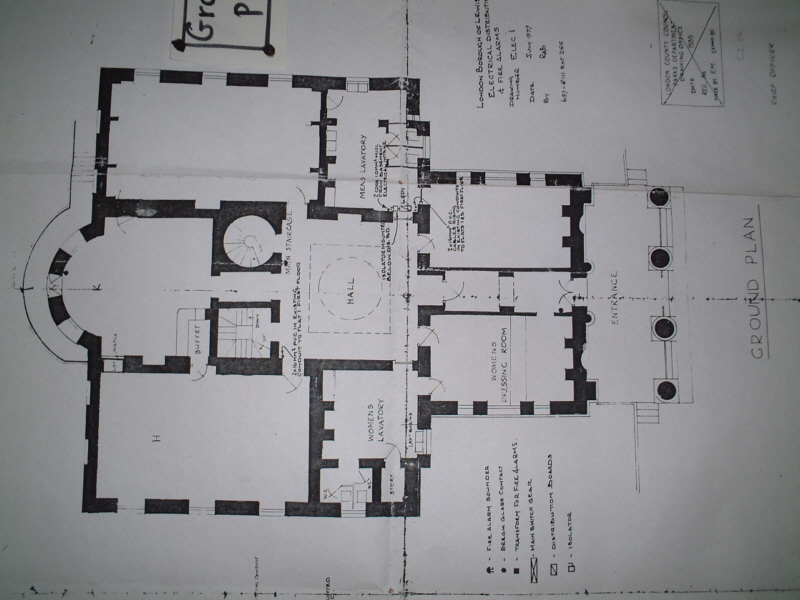
Ground
Floor Plan of
the Mansion
A
gap in the history here needs filling
with information regarding Consultations and Tendering for use of the
Mansion,
such as the bid by a Korean Hotelier which would have involved
unacceptable
extension of the building.
The
Golf Course is put under the management
of Glendale with the intention of increasing income from the course.
However,
Lewisham retain all the cost centre expenses such as grounds staff and
machinery therefore most income remains with Glendale and all costs
incur to
L.B.Lewisham
2011 - Most of the Stable Block is destroyed by fire after being left
abandoned
and insecure for several years. Most of the heritage features of the
building
are destroyed including the clock which was about 300 years old. Below,
the
rear of the stable block facing the gardens in less than perfect but
complete
condition. The righthand end had been extensively remodelled probably
after LCC
takeover but the centre and left hand end had old if not original
features. The
clock was nearly 300 years old and may have once been at Clockhouse,
Penge.
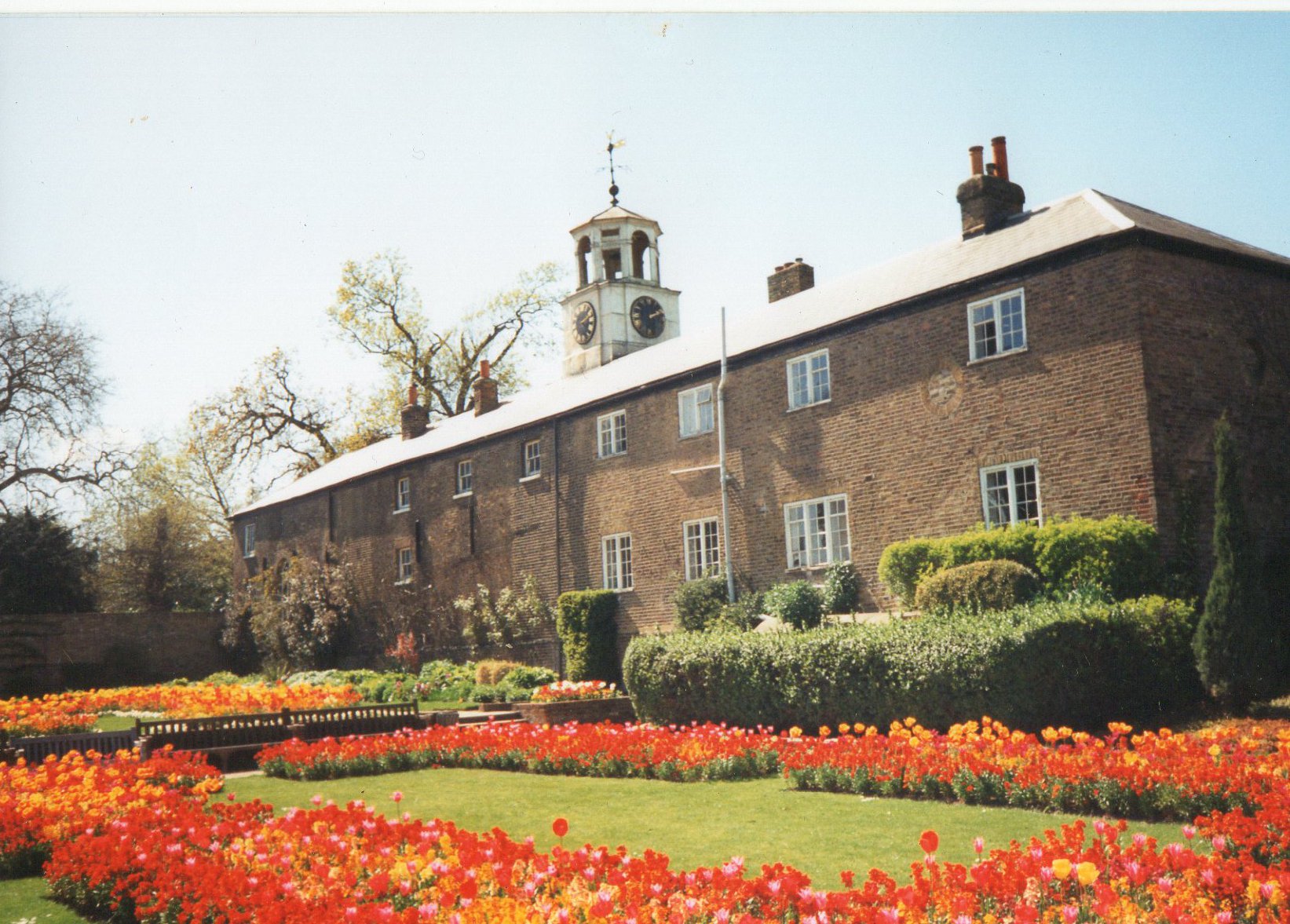
The
Stable Block and
gardens circa 1990
2012
- The Friends and the Sensory
Garden: Over time and with cutbacks in park staffing levels one part of
the
gardens became a bit past its best. The old Rose Garden had overgrown
and spent
plants, overgrown path edges and weeds in the paths. A grant
application was
made via Groundwork Trust and the Big Lottery to obtain funding for a
Sensory
and Nature garden. Cooperation between the Friends and a Local
Authority
officer on behalf of the landowner produced an application and after
much ado
funding was awarded allowing for upgrading of the landscaping including
an
improved disability access ramp. A local landscaping firm completed
that work
after Friends and other volunteer groups grubbed out the old planting
and dug
over the beds. When the landscaping was finished the park gardeners
turfed
around the beds and planted the central area with lavendar. The Friends
began a
program of planting and maintenance gardening. Corporate volunteers
from
Deloite put in a stag beetle loggery and installed a bench and helped
with a
wet area for wildlife. The garden changes with the seasons providing
habitat
for birds, invertibrates, small mammals and amphibians. We get the
occasional
surprise if a bank vole or frog jump out while gardening. Some local
people
keep the bird table supplied with seed and leftovers. The beds are
broadly
themed for touch, smell, sight and a bit of sound if its windy.
Volunteer
gardeners are welcome to come along to workdays regardless of
experience.
Although there's a kind of plan its flexible.
2014
- London Borough of Lewisham
decide to bid for Heritage Lottery Fund money under the 'Parks for
People'
scheme to fund improvements to the park. The mansion remains excluded
from any
funding at this time. Although various works had been done to the
mansion over
a long period such as repairing the roof, installing disabled toilets
etc. No
complete restoration has been done. If we added up all the money spent
on
tinkering it would probably have paid for a proper job or at least
provided
match funding for a grant a long time ago. However, the scheme is not
popular
with all and various people object, not least the golfers whose course
is
deemed to close under the scheme. The Public Consultation such as it
was
presented four schemes either including the existing golf course or
closing the
golf course in favour of an 'Eighteenth Century Parkland Landscape'
restoration. The latter narrowly won having the biggest quarter of the
votes
out of about 300 public responses. The restoration should include the
reconstruction of a lake, rebuilding of the stable block and
restoration of
other Homestead buildings.
2014
- The Environment Agency evaluated
a flood alleviation scheme to use part of the park to prevent flooding
further
downriver. Floods have been recorded in Lewisham, Southend, and
Beckenham over
hundreds of years but infrequently i.e. the 100 year flood which
intimates a
flood event will happen even if rarely. A prevention scheme was
installed on
the River Quaggy at Sutcliffe Park some years ago. The Quaggy,
Ravensbourne and
Pool rivers have combined by the time they get to Lewisham near the
station. A
deluge backs up at that point threatening housing and businesses. The
flood
risk is the result of uncontrolled or ill advised development on river
floodplains. There could be some landscaping and nature habitat
advantages to
this scheme but the scheme was shelved in 2019/20 due to escalating
costs.
2015
- The mansion remains at risk
awaiting HLF restoration bid, The park and homesteads await the
production of
stage 2 HLF bid for restoration etc.
2016
- Lewisham Council close the
public golf course, unable or unwilling to make it financially viable.
The
Mansion is put on short term lease to a property management
organisation RJK
Properties with intentions to increase use of the building.
At
this time Lewisham Council
(councillors and officers one presumes) decide to disband the Beckenham
Place
Park Working Party, probably because members of the working party tell
them
things they don’t like to hear. They establish 3 forums which
in the
view of
some is a ‘divide and rule’ tactic. Public
representation of views is
suppressed by this procedure in my opinion.
2017
- Heritage Lottery Fund bid for
£4.9million approved for park and some buildings
regeneration. At time
of
writing the Local Authority are tendering for design consultants for
the actual
scheme after former consultants produced plans for the bid? Why the
original
tender couldn't have included a proviso that if the bid was approved
the former
consultants would continue with the scheme God alone knows. Seems a lot
of the
money will be spent before a shovel hits the ground or a brick is laid.
Fairly
comprehensive plans were submitted with the bid and for the planning
permission
application but a furter 'detailed design' phase is being tendered.
2017
- May 13th The Public Park's 90th
anniversary. This is the date of the LCC meeting in 1927 which appears
to have
decided the purchase of the Park from The Cator estate. The Foxgrove
Club Golf
Course and the Norwood Sanatorium had active leases for a short time.
2017 - August: New design consultants have been appointed to perform
the
detailed planning. Planning permission for the scheme is still not
granted
awaiting, we assume, presentation of detailed plans. Apparently some
concerns
remain regarding the lake and its proposed source of water i.e. the
stream
appears inadequate, a borehole would be perhaps inadmissable and its
event
suggested that filling of the lake would be by mains water.
2017 - October. The planning application for grant related works is
approved by
Lewisham Council. Alterations to the landscaping will include removal
of some
trees which were planted to define the now closed golf course. The
Mansion
although in use and under a short term lease to RJK Properties is still
on the
English Heritage at risk register and not included in any current
restoration
grant or scheme.
2018
– Over the winter of 2017/2018 a large number of trees have
been
felled to meet the ‘vision’ of the landscape
architects and invisible
‘design
team’. The desire to recreate a lake and wetland area
required the
felling of
what were quite mature trees of up to 100 years age. Due to the lack of
maintenance of the former artificial lake it was either overgrown,
partially
filled in or generally left to its own devices. As the new lake may
have to be
filled with an engineered water supply I wonder what the long term
future of any
new lake will be. As previously mentioned it seemed the original lake
was
created for John Cator circa 1790, probably extended or remodelled by
his
nephew John Barwell Cator after inheriting the estate circa 1810.
Subsequently
reduced in size and mostly dried up due to diversion or building over
the
supplying stream. Any overflow of the lake area is taken by a conduit
under the
railway to the Ravensbourne. At time of writing (Spring 2018)
I’m
informed that
the current rainfall is creating a pond. The area will require
artificial
lining as most man-made lakes either made use of natural clay beds or
clay was
imported and ‘puddled’ down as a liner.
Some work is commencing around the Stable Block but we have no
indication as to
whether original 18th century heritage features
will be
conserved or
restored. “Heritage Lottery” seems just that.....a
lottery as to
whether any
heritage is preserved.
An update on the progress of the works reveals that contamination of
soil at
the site of the lake requires sealing in of contaminant and
cancellation of a
proposed raised landscaping feature. Some architectural feature
flooring in the
stable block is to be retained. Some archaeology is discovered under
the old
lake bed. The new lake is to be provided with water from a borehole as
the old
water source is either dried up or periodically may carry polluted road
run-off.
Excavations for the lake and car park are creating large piles of spoil
and the
installation of pathways is also contributing to this eyesore. The
concept of
‘restoring 18th century
landscape’ is in fact obscuring the
landscape as well as destroying it. All I can say is that previous
landscaping
for golf course or sports pitches did not endeavour to conserve any
landscape
either.
2019 – Beckenham Place; Work continues on the landscape of
the park,
installing
a new lake and rearranging the garden area, installing a car park and
continued
work on the stable block, homesteads and garden cottage.
Contaminated war time landfill was discovered on the lake site and was
tipped
on another area of the park under protective plastic sheeting.
The Flood Alleviation scheme for the east side of the park was
abandoned in
late 2018 due to escalating costs, perhaps among other reasons. Now the
fate or
prospect of funding for works to that side of the park is in doubt.
Although there is some support for the works, there have been
objections and
criticism of some of the works as not being in keeping with
‘restoration of 18th
century landscape’ in fact destroy and covering up a lot of
it.
Excessive tree
planting which alters the character of some areas and felling of mature
or
maturing trees purely for visual aesthetic reasons. One ancient tree
was drawn
to the attention of project workers as being in need of management and
lopping
to balance the crown. The work was refused and subsequently the tree
fell and
though the work might not have prevented it we will never know if
conservation
could have been achieved.
2019 – Beckenham Place: July, The lake and Homesteads are
opened but
shortly
after some safety concerns are raised concerning use of the lake, some
children
rescued from deep water. The profile of the lake bed is such that it
deepens
from paddling depth to over 2 metres quite suddenly. Maybe a forseeable
design
flaw as a gradually sloping lake bed would not hide any surprise drops.
The
other unforeseen issues around the lake have required temporary
fencing,
security patrols and additional safety measures
The Homestead cafe is opened to the delight of some. Unfortunately the
stable
yard looks like its just been resurfaced over the top of any other
surfaces
which might have had some historic or heritage significance.
The
new clock
tower (minus the destroyed ancient clock) cannot take the weight of the
bell
which is apparently dated to 1734 (probably the date which it was
installed at
Clockhouse). The bell is destined to be hung inside the cafe area (time
gentlemen please).
Works are still being carried out and snagging to address footpath
erosion,
stairways etc
The 'mound' near the railway who's main purpose is to accommodate spoil
from
lake excavation and provide a viewpoint etc is merely a pile of earth
with
steps and a path leading to it and shows signs of being a mud
trap. The
old burning yard which we know has a concrete surface somewhere
underneath it
has been levelled but the remains of years of waste disposal can be
seen in the
soil, such as plastics and glass. Several young trees planted to
reclaim the
site a few years ago have been bulldozed in the process. One step
forward, two
back it seems.
As the flood scheme has been cancelled L.B .Lewisham are
planning
a
'makeover' of the east side of the park with reed beds and more mounds
of
spoil. I'm informed this is to meet the Heritage Lottery
Grant
conditions
which included a guarantee that 'improvements'
would be
made to the
east side. L.B.Lewisham are providing a further
£2m for the
scheme.
The Friends of Beckenham Place Park continue to run a Visitor Centre in
the
mansion on Sundays and their volunteers maintain the Sensory Wildlife
Garden
area of the formal gardens. Volunteers under the L.B.Lewisham volunteer
coordinator perform works in other areas of the garden and around the
park. The
Garden Cottage is a volunteer hub and base for the coordinator.
2019 - Beckenham Library: Bromley Council propose demolishing the
purpose built
library to make way for housing. Certainly the neighbouring site of the
old
Technical Institute and Swimming Baths was given to Beckenham for a
nominal sum
by the Cator Estate under Albemarle Cator circa 1900. A campaign to
oppose the
closure and sale begins.
2020 - Beckenham Manor; The manor along with the other areas has
disappeared
long ago under the urban sprawl. Development becomes less planned and
depends
on financial influence and supposed need. A remaining green
space
on
Copers Cope Road which was Natwest Sports Ground is being buried under
indoor
football pitch and artificial surfacing Astroturf in an age where we
know that
plastics and micro paricals are harmful.
A
Crystal Ball is required beyond this point.
See
Additional
Information in another next file to be completed soon. Full references
will be
added here shortly and amendments or corrections will continue to be
made to
this account.
2022
– A recent visit to Bromley Historic
Collections and delving into the research of G.W.Tookey revealed this
vision of
the future, possibly from the 1930’s